

Yacht vs Catamaran: Which Boat is Right for You?
- On October 23, 2023
- No Comments
When it comes to leisure boating, two of the most popular options are yachts and catamarans. But what exactly is the difference, and which one is better suited for your needs?
In this comprehensive guide, I’ll compare the key characteristics between monohull yachts and twin-hulled catamarans.
Visual Comparison of Catamaran and Yacht Designs
How they differ in handling and performance, onboard living spaces and amenities, ownership and operating costs, which boat is right for you, defining catamarans and yachts.
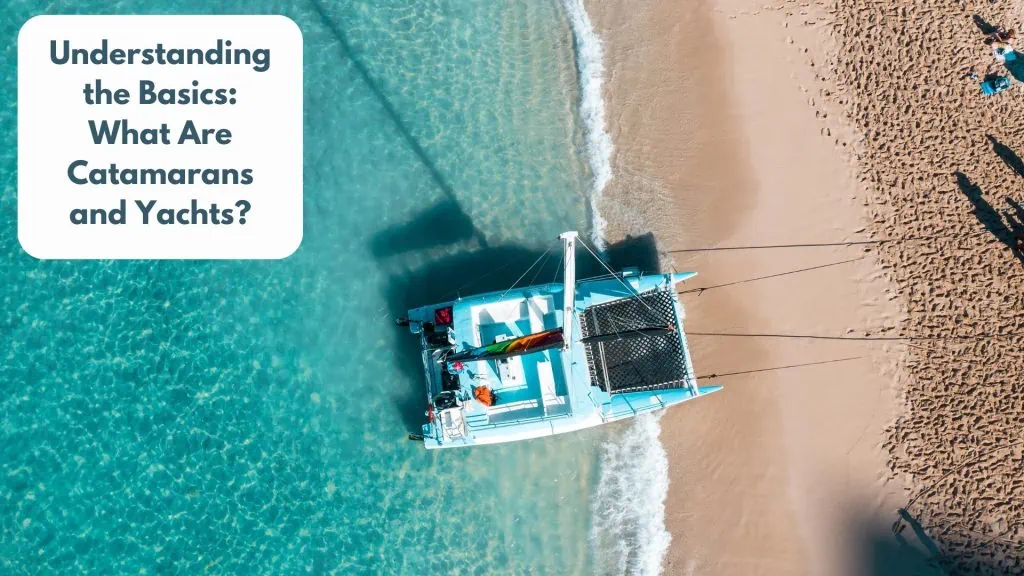
A catamaran is a type of multihull boat featuring two parallel hulls connected by a central deck. This twin-hull design provides more stability, expansive interior space, and shallow draft.
Yachts, on the other hand, have a single continuous hull and are known for their elegant aesthetics, lavish amenities, and versatility for long-range cruising.
Here’s a quick visual comparison of the general shapes and hull configurations:
| Category | Catamaran | Yacht |
|---|---|---|
| Hulls | Two parallel hulls connected by deck | Single continuous hull |
| Shape | Wider, more beamy | Sleeker, narrower |
| Stability | Very stable with minimal rolling | More susceptible to rolling motion |
| Draft | Shallow draft to get closer to shore | Deeper draft requiring deeper waters |
| Living Space | Very spacious, open floor plans | More confined spaces |
Catamarans typically range anywhere from 40 to 70 feet in length, while yachts can be as small as 30 feet or over 100 feet for superyacht models.
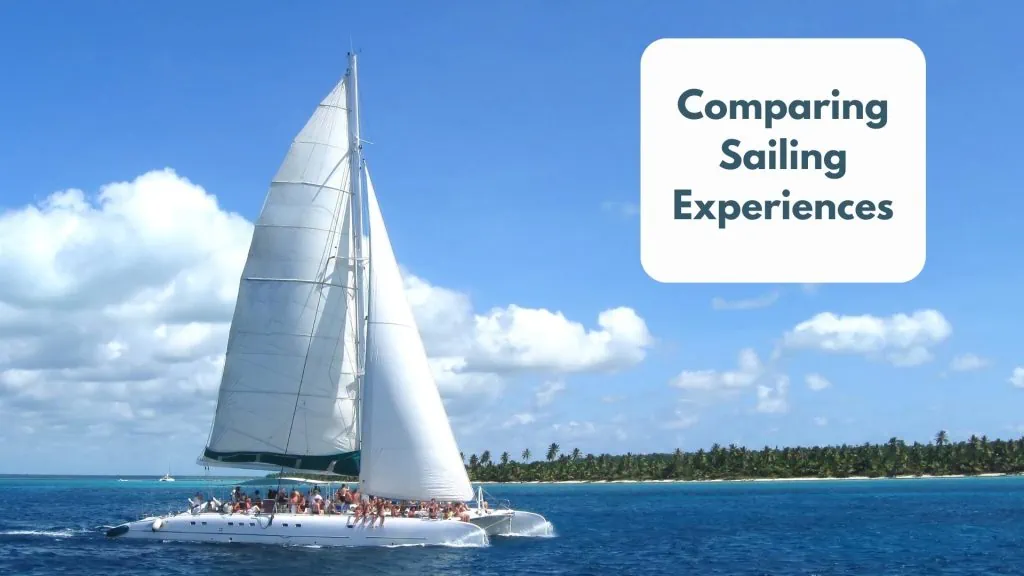
When it comes to maneuverability and sailing dynamics, there are some key distinctions between catamarans and yachts:
- Speed – Catamarans are lighter and have reduced drag, making them significantly faster than yachts. Top speeds can reach up to 25 knots.
- Stability – With their twin hulls, catamarans offer unmatched stability and minimal rocking motion in rougher seas. This also reduces seasickness.
- Maneuverability – Yachts take more skill to maneuver tight spaces, while catamarans can turn 360 degrees within their own length.
- Windward Performance – Yachts point higher into the wind and sail more efficiently upwind. Catamarans excel on reaches and downwind sailing.
So for performance-oriented sailing, monohull yachts have some advantages. But catamarans trade maneuverability for supreme stability and comfort on the water.
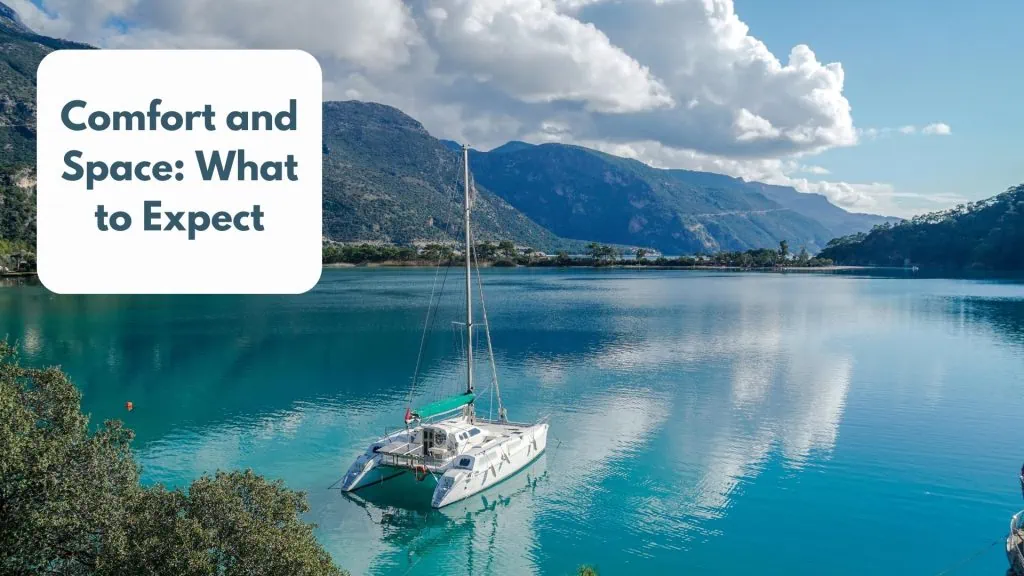
One major differentiation between these two boat types is the onboard living spaces and amenities. Some key comparisons:
- Deck Space – With their spacious bridge deck, catamarans offer ample lounging and relaxation space for large groups. Yachts have more confined deck space.
- Cabins – Catamaran cabins are typically larger and more comfortable. But yachts allow for more privacy when chartering with other couples or guests.
- Entertainment – Yachts focus more on lavish entertainment amenities like high-end sound systems, theaters, and bars. Catamarans offer more outdoor fun.
- Overall Comfort – For stability, living accommodations, and seasickness reduction, catamarans are vastly more comfortable boats.
So catamarans excel when it comes to providing generous living areas for group getaways and family vacations. But yachts are tailored more for couples charters and luxury amenities.
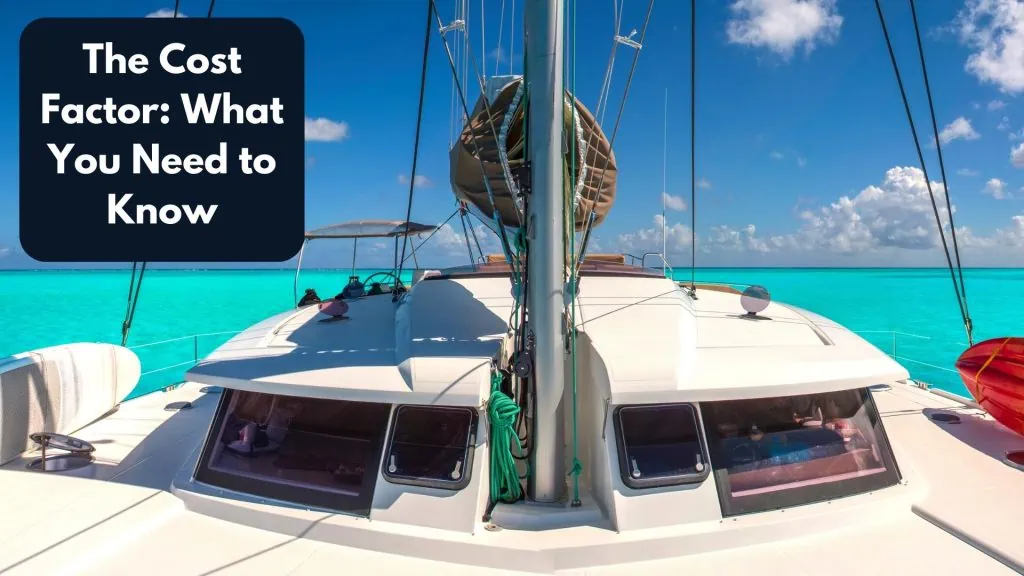
A significant factor to weigh is the overall ownership costs between catamarans and yachts:
- Purchase Price – Due to larger size and dual engines, catamarans come at a higher initial purchase cost. Yachts are more affordable for comparable lengths.
- Fuel Efficiency – With two engines to power, catamarans use almost twice as much fuel to operate. Yachts are more efficient.
- Docking and Marina Fees – Catamarans incur higher fees because they take up more dock space, especially in high-traffic areas.
- Maintenance – More complex systems and dual engines onboard catamarans equate to higher lifetime maintenance costs.
- Resale Value – Depreciation varies widely, but yachts tend to retain resale value better in the pre-owned market.
Clearly, the costs of owning and operating a catamaran are substantially higher compared to a similar-sized yacht. Being aware of these expenses will help determine the right boat for your budget.
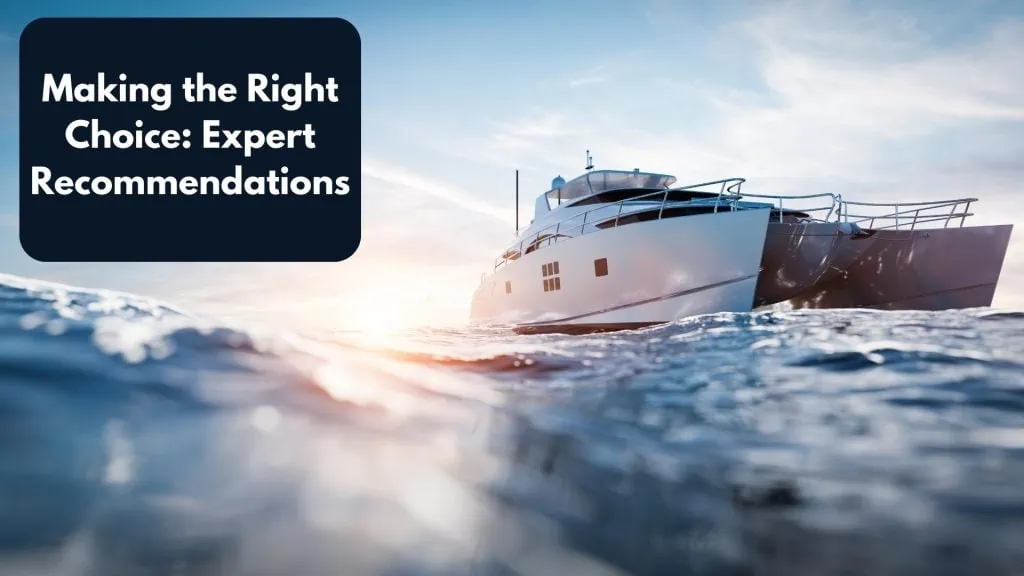
We’ve covered a lot of comparisons, so which boat type is the best choice? Here are some quick recommendations based on needs:
- For comfort, stability, and spaciousness on extended cruising trips – Catamaran
- For performance-focused sailing and nimble maneuverability – Yacht
- For luxurious amenities and entertaining small groups – Yacht
- For exhilarating speed and family-friendly features – Catamaran
- For affordable purchase and lower operating costs – Yacht
Of course, it depends on your individual priorities and boating style. Charter both for a test run to see which you enjoy more. At the end of the day, the right boat is the one that fulfills your needs and invites you to experience the magic of the open water.
Hopefully this guide has provided a helpful overview of the core differences between catamarans and yachts. Let the voyage begin!
- https://catamaranguru.com/catamaran-vs-monohull-we-changed-should-you/
- https://blog.cancunsailing.com/en/diferencia-entre-yate-y-catamaran
- https://www.mbcyachts.com/types-of-yachts-and-their-pros-and-cons/
- https://makaiyachts.com/power-catamaran-vs-monohull/
You might also be interested in reading:

The Top 3 Boat History Report Websites Reviewed
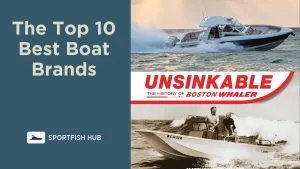
The Top 10 Best Boat Brands
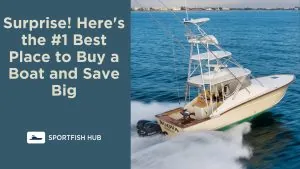
Best Place to Buy a Boat
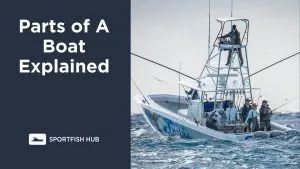
Parts of A Boat Explained
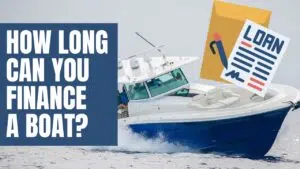
How Long Can You Finance A Boat

Steve Momot
Steve is an accomplished professional photographer and marketer who specializes in the Fishing, Yacht, and Boating industry. With a strong presence as an influencer and marketing expert in the Marine Industry, he has made a significant impact in the field. Additionally, Steve is the original creator and co-founder of Sportfishtrader. Prior to his career as a marine photographer, he gained extensive experience as a licensed boat and car dealer in South Florida.
Leave a Reply Cancel reply
Your email address will not be published. Required fields are marked *
You might also like.

Who Makes The Biggest Sport Fishing Boat?

Fishing Memes

What is Sportfishing?

Sportfish Hub was founded with a clear and unwavering mission in mind: To provide boaters and fishermen with the highest quality content, offering invaluable insights, tips, and resources.
- Terms of Service
- Privacy Policy
SOCial Media
Get in touch, © 2023 | all rights reserved.

Introduction
The benefits and compromises of owning a power catamaran are usually obvious for different consumers, depending on their circumstances, boating ambitions and level of experience. However, a rapidly growing number of seasoned boaters are learning the joys of owning a catamaran and end up becoming firm catamaran supporters.
We have witnessed amazing changes to how families go boating together on a catamaran. For many families, the catamaran yacht has enabled their kids to join and bring their friends without overcrowding the boat. Guests do not have to be seasoned yachties to enjoy the day in the stable and protected cockpit. While entertaining can be done with style and without stress.

The most compelling argument of all must be this: seasoned monohull boaters are converting to catamarans by the truckload. Many converted former motor yacht owners are now passionate advocates of power catamarans. For experienced yachties demanding performance, the advantages are simply too great to ignore. It is rare to hear of any catamaran owners ever going back to a monohull. Once you become a catamaran owner, you are hooked for life.
“Why should I buy a power catamaran instead of a similar sized motor yacht?”
We are regularly asked by buyers “why should I buy a power catamaran instead of a similar sized motor yacht”. Like everything, there are benefits and compromises to the power catamaran. Despite ourselves being firm Catamaran converts and lifetime believers, below we offer a balanced comparison of the pros and cons.
Advantages of Monohulls
A monohull, as the name implies, has just one hull. This is the most common type of hull design, but why? To produce a well balanced comparison lets start by investigating the benefits of monohulls:
Slow roll period
- Many brands and builders to choose from
More usable space below waterline
Familiar handling.
While monohulls roll back and forth far more than a catamaran, monohull fans will argue that the slow roll period of a monohull has a comforting effect.
There any many brands and builders to choose from as most builders still only produce monohulls. Whilst this trend is changing, 50+ years of composite boat building has been heavily monohull focused. This does mean that there is a far greater selection of vessels, designers and brands and builders to select from.
Whilst the monohull comparably has less interior space, the wide waterline beam (width) allows for greater use of the internal hull height. This either enables builders to mount tanks and storage below cabin floors or to actually expand the cabin below waterline. As a catamaran gains performance via its light displacement and narrow waterline beam, this is often not practical on a catamaran.
Jumping from one boat to another will feel extremely familiar as the differences in handling between brands is minimal, with the exception of planning hull vs displacement hull. Focusing on planning hulls, however you will quickly feel familiar jumping from one boat to another. On the contrary, the difference in handling from a monohull to a power catamaran are immediately apparent.
Disadvantages of Monohulls
Now that we have seen the advantages of a monohull, lets analyse some disadvantages one might encounter while boating on a typical V-bottomed or deep-V motoryacht.
Low stability
Bow steering, rolling at anchor, significant bowrise.
Due to the wide flat hull shape required to get the monohull more quickly into planning mode, it can produce a rather bumpy ride when motoring through waves. Performance through waves can be significantly improved or diminished depending on the hull shape. For instance, a deep V hull will be more comfortable through waves than a shallow V. However, both are significantly outperformed by even the worst power catamaran designs.
A monohulls heel angle is directly affected by weight placement. Moving too much weight to port or to stbd will cause the vessel to heel. This is significantly noticeable when at anchor however even underway an incorrectly loaded monohull can dangerously heel. This can be overcome underway by the use of trim tabs. However, is best overcome by conscious weight placement and management.
Bow steering usually occurs when motoring at speed in a following sea or when passing another vessels wake. If you are inexperienced and do not know what is happening it can be quite frightening. Basically, the boat will suddenly and often expectantly turn hard in one direction while rolling hard in the opposite direction, despite your efforts to steer straight. Bow steering can be prevented with the installation of trim tabs. They can enable you to raise the bow up and out of the water when in a following sea. Trim tabs are not needed on a catamaran due to the natural separation of hulls bow steering.
At times you will undoubtedly come across anchorages that aren’t completely flat. When this happens, monohulls, that rely on the weight of their COG (center of gravity) to be aligned below their COB (center of buoyancy) to keep them upright, will start to rock from side to side. Things roll around inside, plates go flying. It’s uncomfortable or sometimes impossible to cook, and only the hardiest of yachties will be getting any sleep.
While all of this is going on, at the next mooring ball, the power catamaran owners are sitting in their cockpits sipping sun-downers, barely noticing the movement, quietly getting tipsy before a long night’s sleep.
The degree of bowrise varies with monohull designs. However, for those of you unfamiliar with this term, bowrise is the tendency of a boat to point its bows up in the air before it gets into planning mode and then settles somewhat. This puts passengers through an uncomfortable, and sometimes unnerving experience whilst also exposing the vessel to a decreased level of stability and safety.
POWER CATAMARAN
Advantages of power catamarans.
Whilst individual designs can vary by design and their usage, the benefits below are typically universal for most catamarans. In comparison to the equivalent length monohull a catamaran shall deliver the following advantages:
Superior ride comfort
Enhanced stability at anchor and underway, up-scaled cabins and interiors, larger single level cockpit and saloon, significantly improved fuel consumption.
- Drastically improved close-quarter maneuvering
Catamarans experience slower deceleration through wave impact. This significantly reduces slamming through waves. This has been measured with accelerometers in like for like tests to have a 25% reduction in G forces when riding over waves.
Due largely to their wider beam, catamarans have a remarkably higher righting moment compared to monohulls. This prevents them from rolling side-to-side when at anchor, and keeps them sitting level both underway and at rest . This is regardless of placement of people or luggage, this also eliminates the need for catamarans to use trim tabs.

More interior volume, especially in power catamarans that carry their beam all the way forward. Even applicable in the smallest cats that will usually have stand up headroom in each cabin, unlike smaller monohulls. As a result of this increased volume, a power catamaran will always feel over sized – more fairly compared to a monohull 15-20% longer in length. A 35ft power catamaran for instance is more fairly matched against a 43ft motor yacht.
Catamarans generally provide far more living space in the main salon and cockpit in comparison to similarly priced monohulls. The galley, main salon and cockpit are also all on one level, above the water line … making life aboard as well as your view much more enjoyable.

Due to their reduced displacement and wetted surface area power catamarans are impressively efficient. The wider monohull bows create a large bow wake and greater resistance, which require more HP to get onto plane. Not only does this burn more fuel, but also enables a catamaran to get onto plane under just one motor. This is a significant safety advantage, enabling a boat with only one working engine to return to shore before dark rather than limping home at below planning speeds. The ability to plane at lower RPM’s enables cruisers not wanting to travel at groundbreaking speeds to achieve highly efficient low speed planning. Vastly expanding their cruising ground while not breaking the bank nor taking all day to get to the next anchorage. Learn more about power catamaran fuel consumption HERE>>
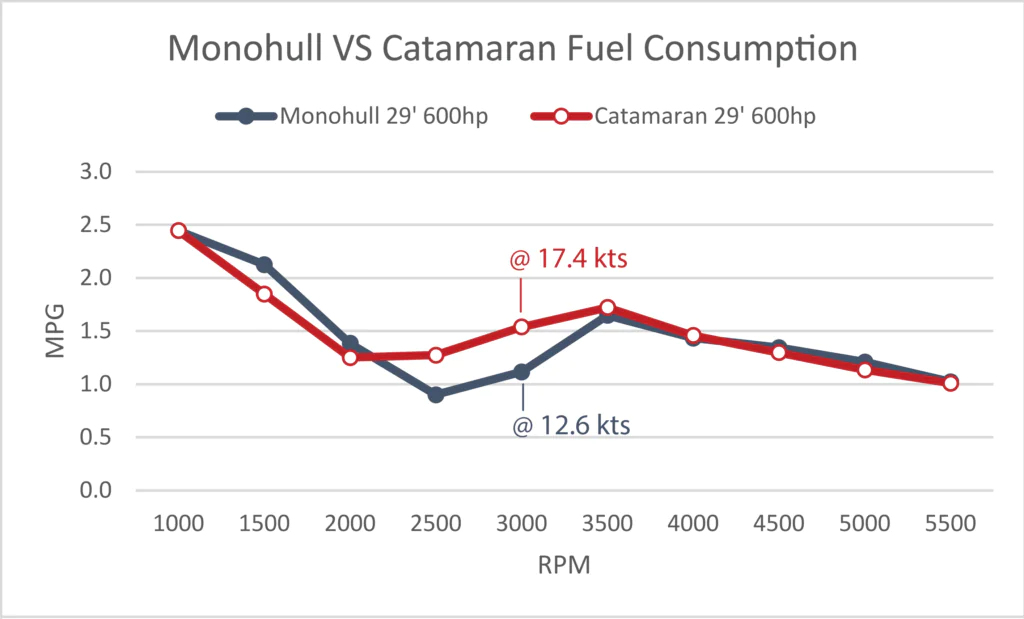
Drastically improved close-quarter maneuvering: A large separation between the port and stbd engine drastically improves close-quarters maneuvering. This enables a power catamaran to literally rotate within its own waterline length by simply putting one engine in reverse, and one in forward. Add a joystick control and you’re in command of one of the easiest boats that you will ever dock.
Disadvantages of Power Catamarans
Despite the significant benefits gained by the power catamaran, there are also a few unusual traits associated with powercats:
Outward banking
Snaking at anchor, tunnel-slap, unusual appearance.
When making sharp turnsm a monohull will bank (roll) into the turn. A catamaran, on the other hand, due to its increased stability and righting moment will actually bank slightly outward. If coming from a monohull background, initially this sensation will feel unusual. However, If you have no prior expectations regarding the outward bank offers ,no benefits or disadvantage over the inward bank.
Due to the power catamarans wide beam and asymmetry, when at anchor a shifting breeze will cause the vessel to turn to port and stbd in a snakelike movement. If the wind has some strength and continues to shift, this movement can become uncomfortable. We therefore recommend attaching an anchor bridle whenever anchoring which completely eradicates this effect.
In certain conditions, catamarans can experience tunnel slap. This is where a wave passing under the tunnel rises up and slaps the wingdeck surface causing a thud or slapping sound. This effects different catamaran designs in various ways depending on whether they are of displacement or planning type. A displacement catamaran requires a high wingdeck to overcome the wave crest heights in order to ride over the top of the waves. Planning catamarans, on the other hand, should have narrower and shallower tunnels. This forces a compressed air mixture through the tunnel, creating a cushioning and lifting effect lifting the catamaran above the surface of the water with intensity increasing as speed increases.
When asked, many monohull owners claim they do not like the unusual appearance of a power catamaran. Whilst styling preference is subjective, at Makai we have worked hard to design a power catamaran that delivers all of the benefits of a catamaran. Whilst doing so with attractive and unmistakable styling.
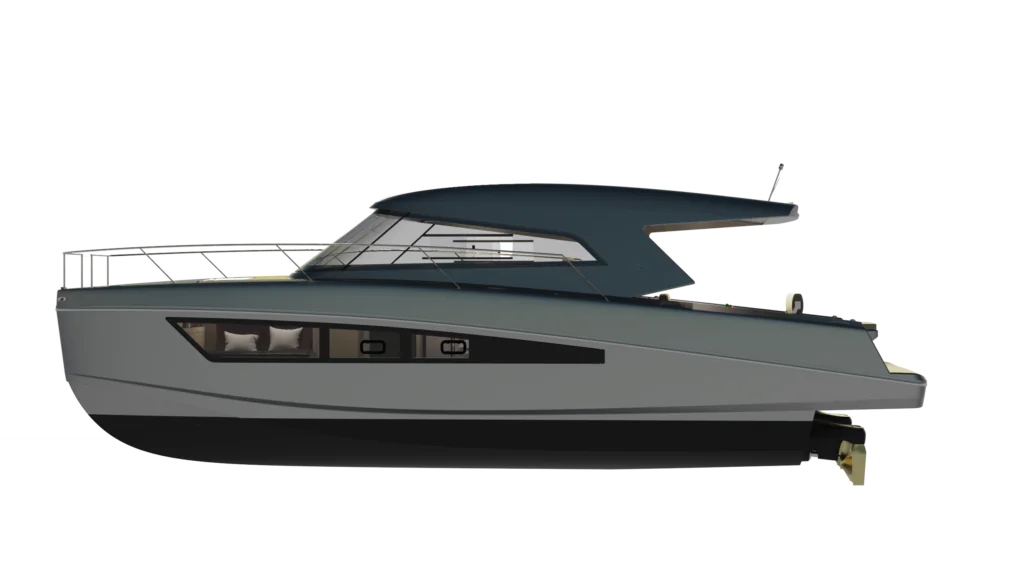
CONCLUSION : Power Catamaran or Monohull?
Whilst each have their own advantages and disadvantages the final choice is completely down to personal preference. Clearly, we are die hard catamaran believers, but we also believe that what is most important above all else is just getting outside and on the water, having fun and being safe. So, when you find the boat that does all of the right things for you, go for it!
Learn more about MAKAI Yachts HERE>>
Learn more about the MAKAI M37 HERE>>
- Get Newsletter
- Privacy Policy
Catamaran Vs Yacht
Learn the difference between a catamaran vs yacht charter, what yacht should you charter catamaran vs monohull, what is better to charter a catamaran vs yacht.
Those new to yacht charter and catamaran charter will often ask, what is Better to charter – a Catamaran or Yacht? To assess the catamaran vs yacht question, we need to understand the main differences. A catamaran is, strictly speaking, a yacht with two hulls and a yacht in this context and a sailing vessel with one hull, otherwise known as a monohull.
It’s easily arguable that a sailing yacht was more fun to sail, takes up less room when mooring, and is cheaper per berth than a catamaran. Alternatively, a more stable catamaran offers more space and is cheaper per sq. foot of space.
Until recently, the advent of catamarans in the America’s Cup competitions would show that catamarans are not the slowcoaches they were when you consider the c atamaran vs yacht debate. All catamarans are very nice to sail just off the wind, which will leave some saying that my characterisation is a little skewed. Yet, I would say, in general, for charter catamarans vs charter yachts, the comparison holds.
Your Answer Will Depend on Many Different Variables Such as:
- Advantages of Catamaran Vs Yacht
- Disadvantages of Catamaran Vs Yacht
- Getting Into The Detail
- Thoughts on a Monohull Charter
- How to Book
Here are our 5 Reasons to Hire a Catamaran Vs Yacht
The Pros of a Catamaran Vs Yacht
The 5 reasons to hire a catamaran versus a yacht.
- Space. When weighing the Catamaran Vs Yacht debate, space is one of the key factors by far, but you’ll also see this appoear in our list of disadvantages too. In terms of squarefootage, if you like to pack generaously, or have planty of space for sunbathing, then Catamarans vs Yacht is for you.
- Cabins. Along the same theme, Cabins are generally much more spacious than monohulls. The locker storage space is always much greater than that of a monohull. The greatest advantage is the considerably larger ports (windows), which, when sailing in August, not only gives you a great view but comes in super handy to let in the breeze.
- Stability. Catamarans are notoriously more stable than that their counterpart. This can be beneficial for new or inexperienced sailors who haven’t got their sea legs yet or are prone to seasickness. Due to their two hull design, cats do not heel over more than 5 degrees. This means you don’t have to check that plates are not sliding off the table continuously!
- Draft. Catamaran’s shallow draft (depth of the hull and keel under the water) has some advantages. This is a particular advantage in areas with shallow waters, thus allowing you to anchor closer to shore.
- Power. Catamarans have twin engines. This, combined with the shallow draft, allows the yacht to cruise at higher speeds, whether under sail or using its engines. The two engines also allow greater manoeuvrability in confined areas or spaces, great in marinas or when picking up mooring buoys.
The Cons of Catamaran Vs Yacht
Four things you might want to consider with a catamaran vs yacht.
- Mooring . Due to the width (and size) of a catamaran, often, you have to pay a lot more to book a berth in a harbour for the night. However, some authors can be quoted as saying that anchoring in a cat is easier.
- Upwind Sailing. Catamarans don’t sail up-wind well! Performance cats make up for this with boat speed and by employing daggerboards to prevent leeway (sideways movement). It will be fun trying to sail upwind, but you might not make much progress!
- Steering. Sailors have noted that the helm (be it the tiller or a wheel) is not as responsive as a monohull, you don’t get the same feedback (weather helm) on a cat, and it can feel ‘limp’ to sail.
- The Feel. Most charter cats are built for comfort, so the sailing can be a little disappointing unless you’re on a beam reach.
The Pros of a Yacht vs Catamaran
Getting into the detaila - monohull vs catamaran advantages.
Monohulls offer the ultimate sailing experience for many sailors. Here’s why:
- Dynamic. When considering a monohull vs catamaran, remember monohulls can tack quickly, thus making them a lot more manoeuvrable than a cat. Nothing beats the rhythmic feeling of sailing whilst heeling over.
- Responsive. They are also fairly responsive to the helm.
- Up-Wind. These vessels are much more capable up-wind than most catamarans. They can sail much closer angle to the wind than a cat.
- Budget. Monohulls are cheaper to buy (fewer materials) than catamarans, often aimed at the luxury market and significantly less to charter. Berth for berth, cabin for cabin, a monohull is usually better value for money.
- Berthing costs. With twin engines, expect to put a little more fuel in your cat. The cost of berthing in a harbour or at a marina tends to be significantly lower due to the reduced beam (width).
The Last Case for a Monohull!
There are good reasons to consider a catamaran vs yacht, but if you love being up close and personal with your crew and you love dynamic sailing, here’s the big advantages.
- Snug. Modern charter monohulls are wide with high ceilings and have plenty of space in cabins and for stowage. That said, the usable space on a monohull is much less than that of a catamaran.
- Heeling. The boat heeling or “leaning” over is perfectly normal and something you get used to quickly. This can be tricky for the young and old and makes handling the boat a little more adventurous.
- Draft. Due to the deeper keel (the stabilising fin below the yacht), you cannot sail in shallow waters and must be more vigilant of your depth.
Learn More About Chartering a Catamaran Vs Monohull
As you can see, there are many pros and cons to consider when deciding between a catamaran vs yacht. Whilst the debate between monohull sailors and multi-hull fanatics will rage, it largely depends on what you are using the boat for, where, your budget, and your crew.
If you have the opportunity to decide if you prefer a catamaran vs monohull, by sailing both types of boats, then take it so you can assess the benefits of both wonderful sailing boats.
If you are planning a sailing trip and are a little unsure, why not get in touch, and we can help you decide what is best for your location and crew.
Amazing Sailing Experiences
Our amazing customers.
I didn't think sailing with my family would be so much fun...
Sailing for the first time.

Everything went smooth, the paper processing, special requests and the specs of tht check-in procedure. Boat was also in good shape, so no complaints and a worry free holiday...
We had a great experience with booking through sailchecker.
Informative and looked for the best value for our family. Very good customer service on this side and in Greece. Great boat and skipper...
Fantastic holiday from start to finish.
They were very responsive and very quick to answer questions via email and instant chat. They had extensive knowledge of the area...
We will most definitely use their services for our next bareboat sailing vacation.

Sailchecker were professional from start to finish - and were awesome dealing with a problem! Our first Yacht had serious issues and sail checker helped us to resolve it...
They are easy to deal with, straightforward and honest and I would recommend them to anyone planning a charter holiday.

During the Coronavirus pandemic, Kate and her colleagues at Sailchecker have performed brilliantly. They have been considerate and highly efficient in re-organising our Turkey charter and also provided lots of assistance in getting our Yacht Security Deposit insurance policy transferred to match our revised charter dates.
Truly worthy of a 5 star rating!

Would I go sailing again? OMG yes! Sailing is the perfect family holiday. Boys loved the activities, I enjoy relaxing as well...
Sailchecker.com arranged a sailing cruise her family of 2 sons, daughter & hubby in the BVI with their own.

It was sail in the day… party at night. We couldn't have wanted a better skipper or a Spring Break! Good times...
Arranged for 6 friends to sail Spring Break in the British Virgin Islands for under $500 each.

All bookings and confirmations was always accurate with no delays. Our boat was also fabulously maintained and the Skipper new the area extremely well...
Everything was down to the tee.

Rated 4.9 out of 5 based on 215 reviews on Trustpilot
Got a Burning Question About Catamaran Vs Yacht?
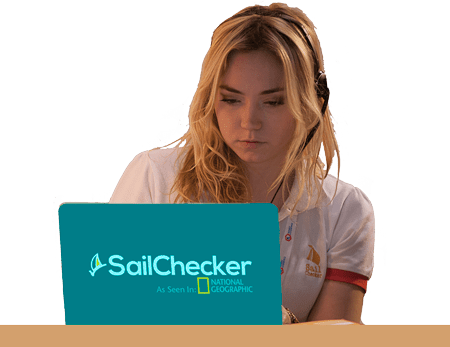
Founder Member IFCYA
Yacht Charter & Sailing.
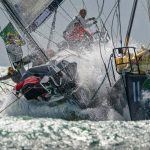
Start typing and press Enter to search


What Is The Difference Between A Yacht And A Catamaran?
What’s the difference between a yacht and a catamaran? Let’s dive in and find out!
Yachts are classically assumed to be medium-sized sailing ships. Today we assume a yacht is a large, luxurious, monohull vessel. Alternatively, catamarans are designated by having two hulls. Catamarans can also be large and luxurious, classifying them as a yacht. Therefore a catamaran can also be a yacht, but a yacht may not necessarily be a catamaran.
This article is just what you need if you’re new to the sailing scene and can’t seem to decide which of the vessels mentioned above to hit the open ocean.
Although technically a catamaran may be a yacht, in popular culture, a yacht is assumed as a monohull. Below is a detailed breakdown of the difference between a yacht and a catamaran. ( source )
Differences Between A Yacht And A Catamaran
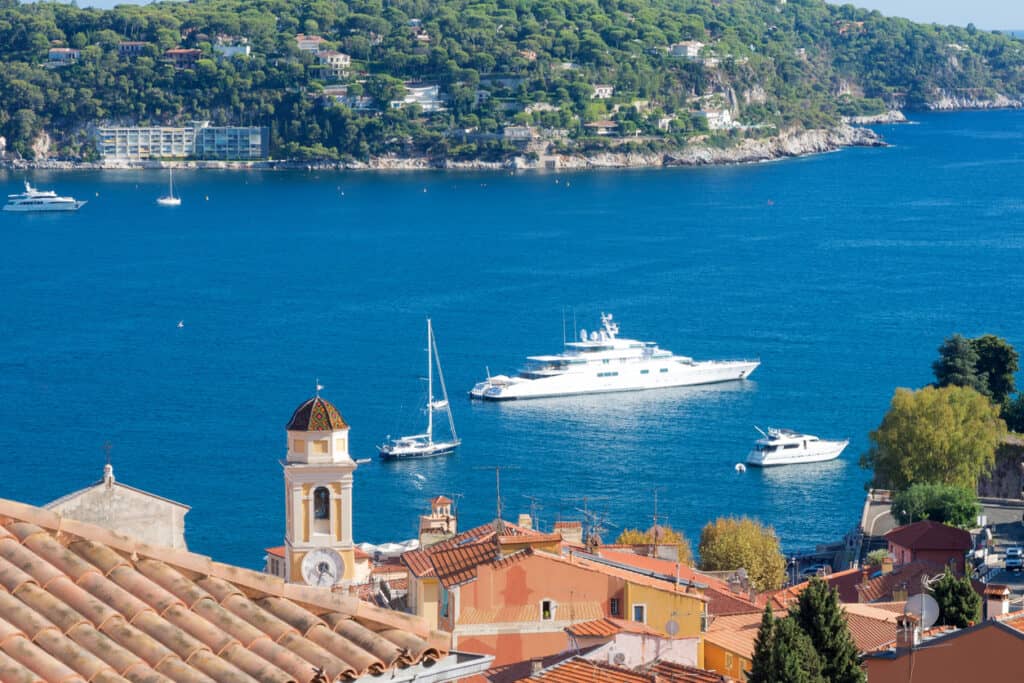
Number Of Hulls
The hull of a sailing vessel is simply the part of the vessel that sits in the water. Yachts have one hull, while catamarans have two hulls.
A sailing vessel with multiple hulls can explore more ocean depths than one with a single hull. It is because very little of the boat is underwater.
Due to this distinctive feature, yachts heel over more than catamarans, making them unsuitable for new sailors, children, or older people.
With that said, let’s look at the difference between a yacht and a catamaran regarding maneuverability.
Level Of Stability, Safety, Efficiency, And Displacement
The primary distinction, as noted, is that a catamaran has two hulls compared to a monohull yacht. These two hulls allow excellent stability for the watercraft with a much lower chance of capsizing and half the chance of sinking compared to a single hull.
Although, a sailing catamaran can always blow over in the incorrect use of sails in windy conditions, just like a sailing monohull can. The difference is that a catamaran is much more challenging to right itself if it goes over. Therefore, it’s best to understand all the principles of sailing before taking out a sailing vessel, regardless of whether or not it’s a catamaran or a monohull.
Unlike yachts, catamarans generally have a minimum of two engines. These motors enhance the level of maneuverability of the vessel.
In other words, catamarans are easier to pilot or maneuver than yachts of the same length.
Furthermore, the presence of a second engine on a catamaran makes it noticeably more potent than a yacht. And they are faster boats, too, because they don’t need to sit as deep in the water due to two hulls sharing the overall weight of the vessel.
A monohull carries all the weight on a single hull, causing the hull to sink deeper into the water. Given that water has greater friction than air, a hull deeper in the water will have greater resistance. Therefore, by nature of design, the more hulls, the faster a craft can go and the less power it consumes to go at a similar speed as a monohull, meaning it is also more efficient.
Size Of Space
You can quickly tell the difference between a yacht and a catamaran by size or space. Yachts are not as roomy or sizeable as catamarans of the same length.
You get bigger cabins, sitting areas, ample bathrooms, and wide galleys with catamarans.
The downside to the size or spaciousness of a catamaran is that it’d cost you a lot more to book an overnight berth.
When choosing between a yacht and a catamaran, consider the number of people you’d like to bring on board.
Sailing Experience
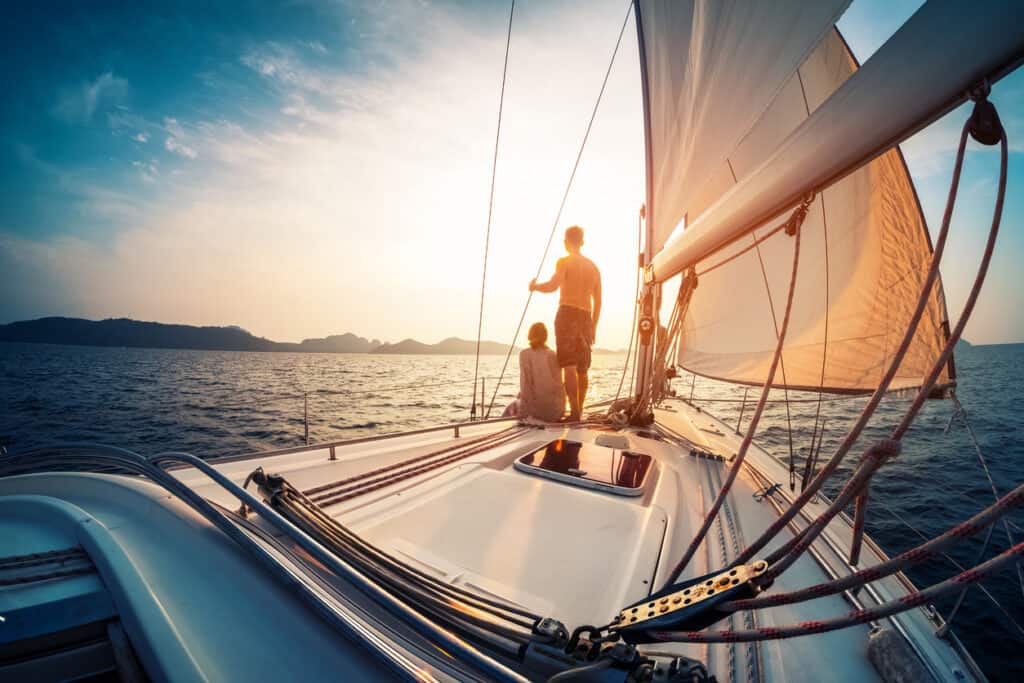
Yachts and catamarans do not provide the same sailing experience. Many people believe that yachts are more exhilarating to pilot than catamarans.
It is pretty simple; catamarans don’t give as much feedback as yachts do when you manipulate their helm.
Additionally, the design of catamarans makes it nearly impossible to sail them upwind. So, a yacht is your best bet if you’re looking to enjoy a thrilling upwind sail.
As you may know, the cost is a critical criterion in identifying the difference between a yacht and a catamaran.
The amount you pay to own or charter one of these vessels depends on the size and type of vessel you choose.
Generally, catamarans are more expensive than yachts of the same length, which is not surprising given that two hulls and a bridge will be more work to build than a single hull.
- Latest Articles
- Articles Sources
- Crab Island by Pontoon: A Fun Watery Boating Guide Destination in 2024
- Upgrade Your Boating Experience: Adding a Third Pontoon Made Easy!
- How Long Does It Take A Canoe To Go… (Canoe Calculator Here)
- In-Depth Review of the Pelican Sentinel 100X Fishing Kayak: Pros, Cons, and Performance
- How To Put A Kayak In The Water – The Ultimate Guide For New Kayakers
Catamaran vs. yacht: How to find the right vessel for your travels https://www.traveldailynews.com/post/catamaran-vs-yacht-how-to-find-the-right-vessel-for-your-travels
perfectrolex.sr
Yacht, sailing yacht or catamaran? What is the difference between them?
The holiday season will be here soon. In March, you should already have your sailing week booked. If you hesitate about the choice, you can risk that someone else may book your dream boat before you. There are many boats on the market, many technical terms, and names. Are you confused about how to choose? Read about each category and choose the right boat for you, your family or friends.
For your unforgettable vacation, you can choose one of our motor yacht, sailboat, or catamaran. It is essential to set the right expectations when you go sailing for the first time so that you will not be disappointed. If you have never experienced a boat vacation, it may not be very easy to understand the professional nautical terms. But don’t worry about it. We are happy to help you. What types of boats can you choose, and what are the differences between them? There are several different categories, according to the kind of propulsion, size, construction, sailing method, areas, and destinations as well. We will focus on marine cruises (seas and oceans) and the so-called recreational crafts . The following limits define them – length up to 24 meters, maximum of 12 people on board, and engine power higher than 4kW.
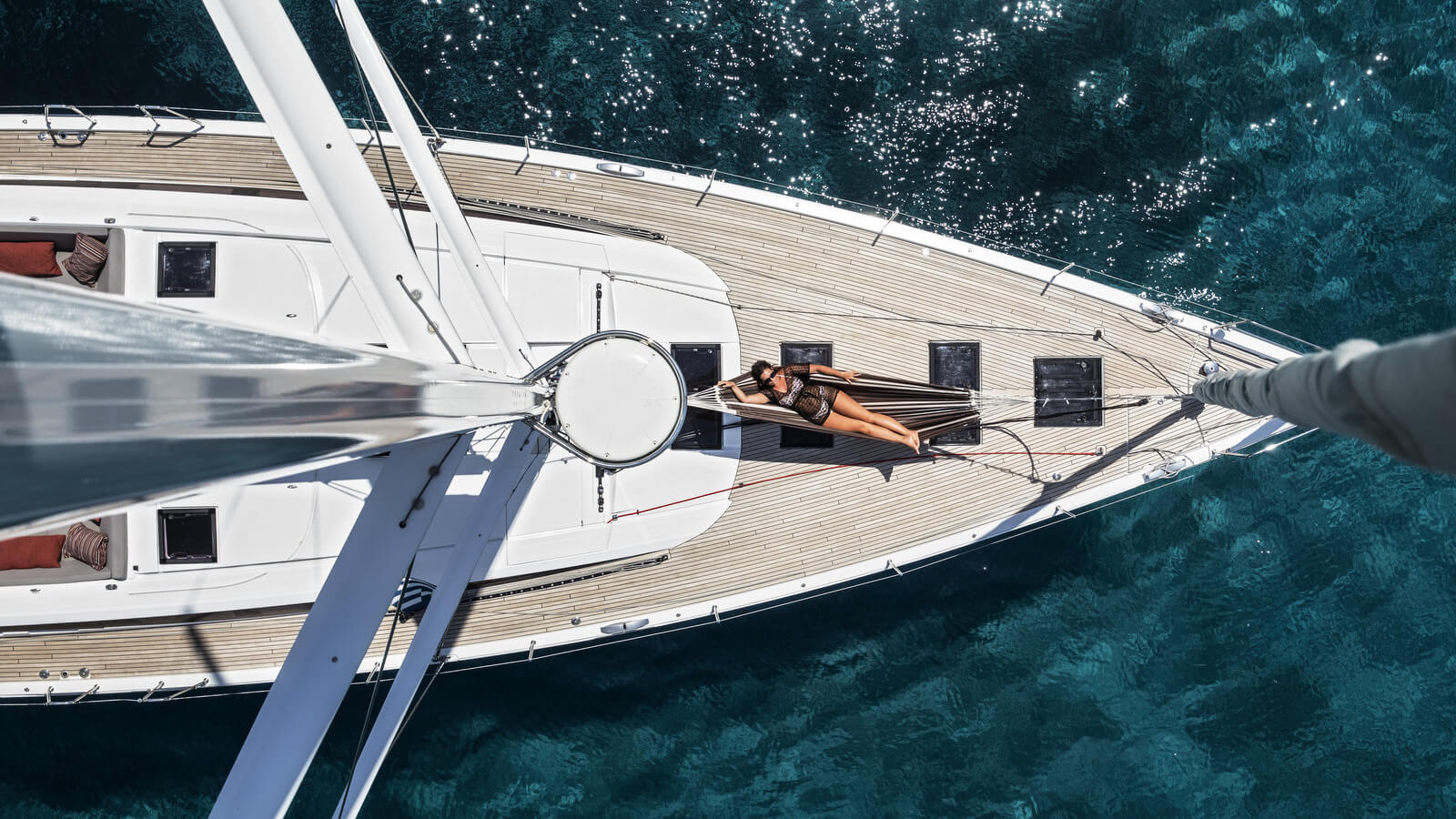
The most commonly used word in connection with sea cruise is a yacht. But what a yacht is, and what do you imagine by this term? The word ‘yacht’ comes from Netherland and means ‘hunting.’ Yachts are usually 6 meters high and can be up to 100 meters long. A yacht can be used for sports, but also for recreation, for discovery
but also for adventure 🙂 For us is word Yacht connected with positive emotion, peace and family holiday on the sea in Croatia. And what do the lessons say to the word Yacht?
A yacht is the general term of a vessel. We recognize two basic types:
- Sailing yachts, also known as S/Y,
- Motor yachts, also known as M/Y.
With or without wind
The sailing yacht is powered primarily by wind and sails. In the port, you can maneuver the sailing yacht only by the engine with sails pulled down. If windy days occur, it can be powered on the sea by the engine. When using the sails, the sailing yacht can cruise safely around 9 knots. When using the engine, it cruises 12 knots. In the case of recreational sailing yachts, the length is 35 to 64 feet (10,5 to 19,5 meters). In general, sailing yachts are significantly more fuel-efficient than other types of boats, as they have one diesel engine. A sailing yacht is about emotions. The sun, water, and wind in the hair make sailing yacht cruise a different experience than a catamaran or motor yacht cruise. Also, they are ideal for romantic cruises. At the same time, sailing yachts are the safest types of vessels, as they have a deep lead pound (1,5 to 3 meters). In the case of a large tilt, it will help sailing yacht to return to a safe position. In terms of vessel construction, the sailing yacht belongs to the category of Monohull (so-called single-deck vessels).
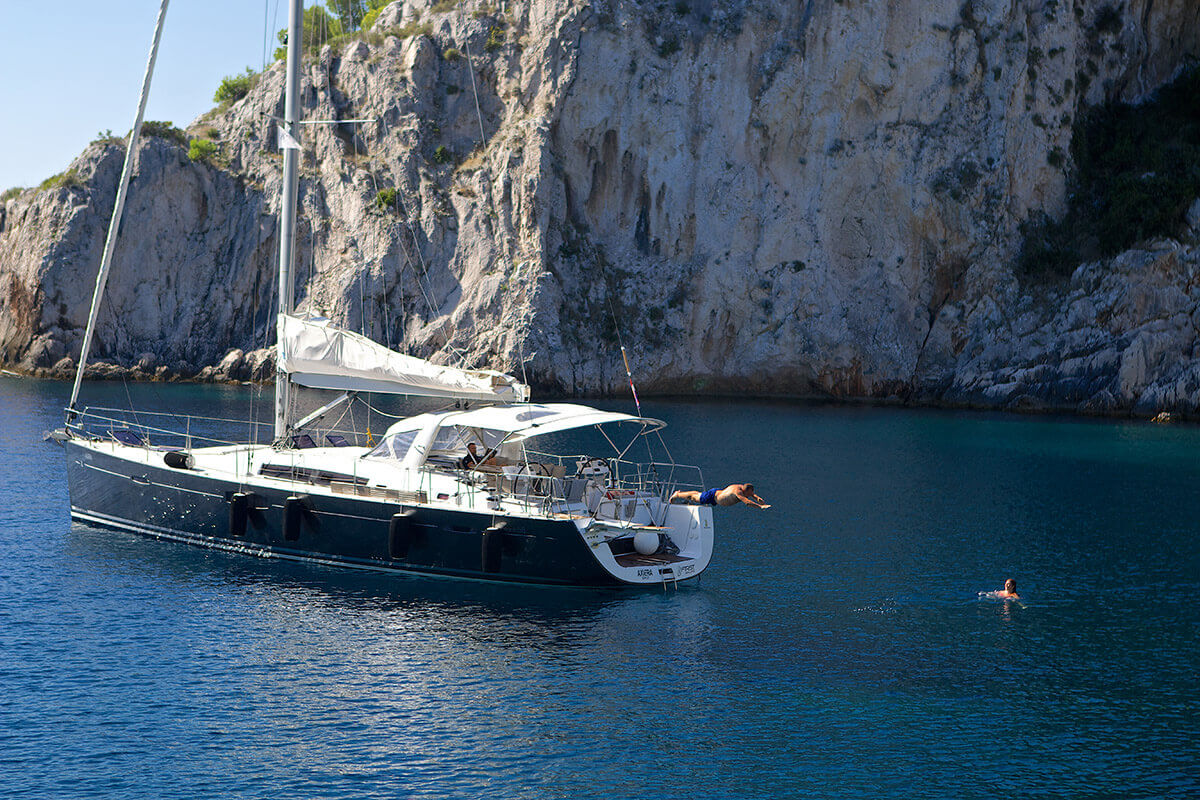
A catamaran is a multihull vessel and is suitable for clients who have never been on a boat since it offers much higher comfort.
There are two basic categories of catamarans:
- Sailing catamaran , powered primarily by wind, with sails and two fuel-efficient engines for maneuvering (average speed of catamaran powered by sails is around 12 knots, by the engine up to 15 knots) or
- Power catamaran , which has no sail at all, but has two powerful engines that can sail at 30+ knots. It all depends on the power of the engine and the weight of the catamaran. However, this is at the expense of high fuel consumption.
The advantage of a catamaran is its excellent maneuverability (it can turn in the place thanks to 2 engines) and has three times more space than a sailing yacht of the same length. It is ideal for families with children; it can anchor in the bay a few meters from the shore at a depth of only 2 meters. The basic recreational catamaran’s length ranges from 39 to 45 feet (11,9 to 13,7 meters). Luxury catamarans are long of 50 up to 80 feet (15 to 24 meters). In terms of vessel construction, a catamaran belongs to the category of multihull vessels, together with trimaran, which has three connected hulls.
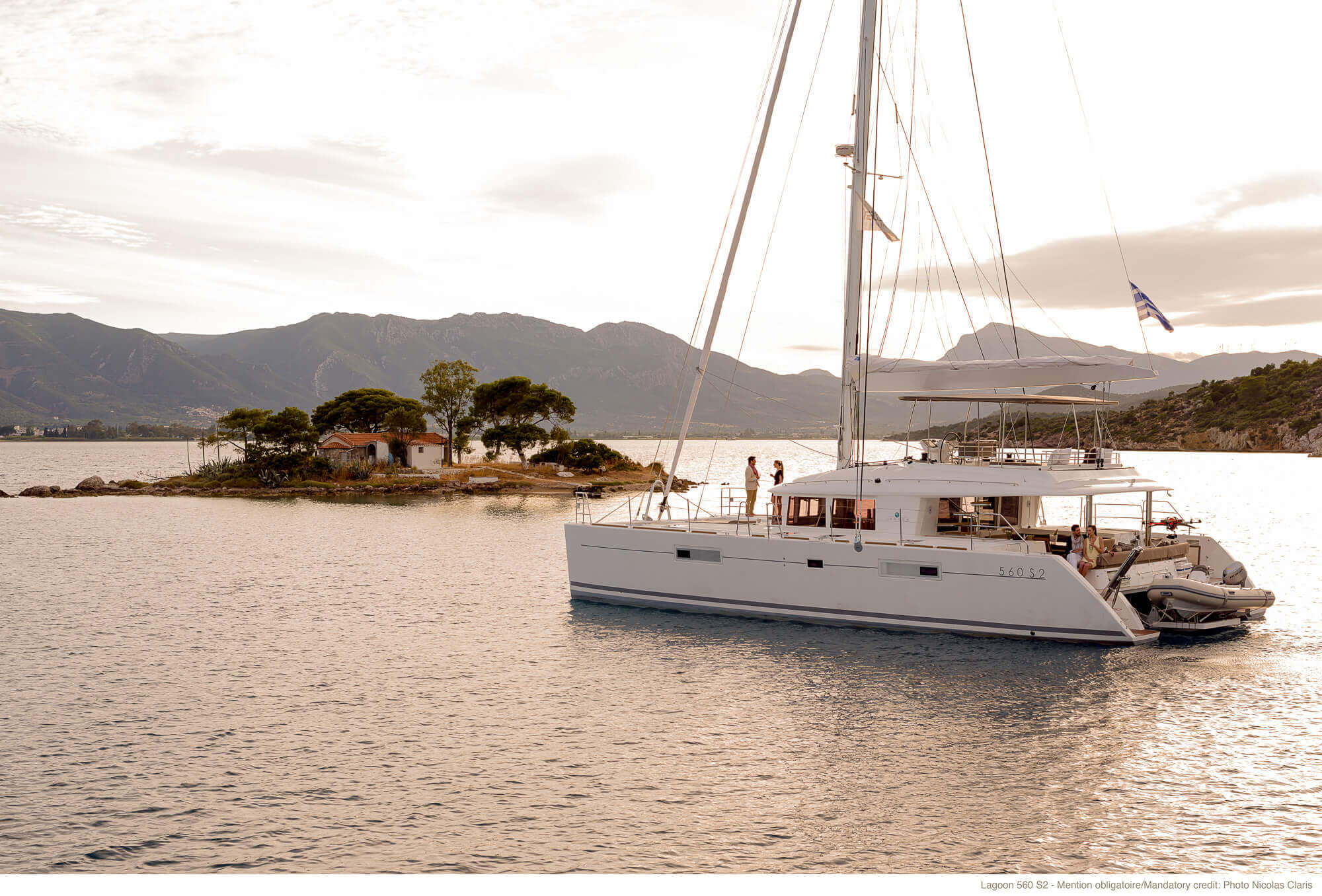
Do you prefer more powerful engines?
In this section, we will introduce you to two categories: motor yacht and motorboat.
Motor yacht works with the help of powerful engines. It has no sail, and usually, there are more crew members (captain, hostess, cook) who take care of your comfort. At the same time, it has no ponds. More luxurious motor yachts use special stabilizers (gyroscopes) while sailing to ensure comfort on board. Motor yacht’s length starts from 10 to 24 meters. Super luxury motor yachts can have a length significantly exceeding 100 meters, including a heliport. However, now we no longer talk about the recreational craft, but we get to the category of a nautical yacht . Motor yachts can sail 25 or more knots without problems, which has a significant impact on their consumption. They have powerful diesel generators and can operate on the water as a small, fully independent house.
A motorboat (or speed boat) is a fast boat that mostly serves to move from a motor yacht, sailboat or catamaran to the shore. It has no cabin to stay overnight or any toilet space (in most cases). The size of the recreational motorboat ranges from 3 to 8 meters and has one or two fast motors from 50hp to 500hp. You can also use it for water sports (water skis, wakeboard or donat). There are of course special sport motorboats that have four or more motors with much higher power and provide much more experiences and fun of sailing on the sea.
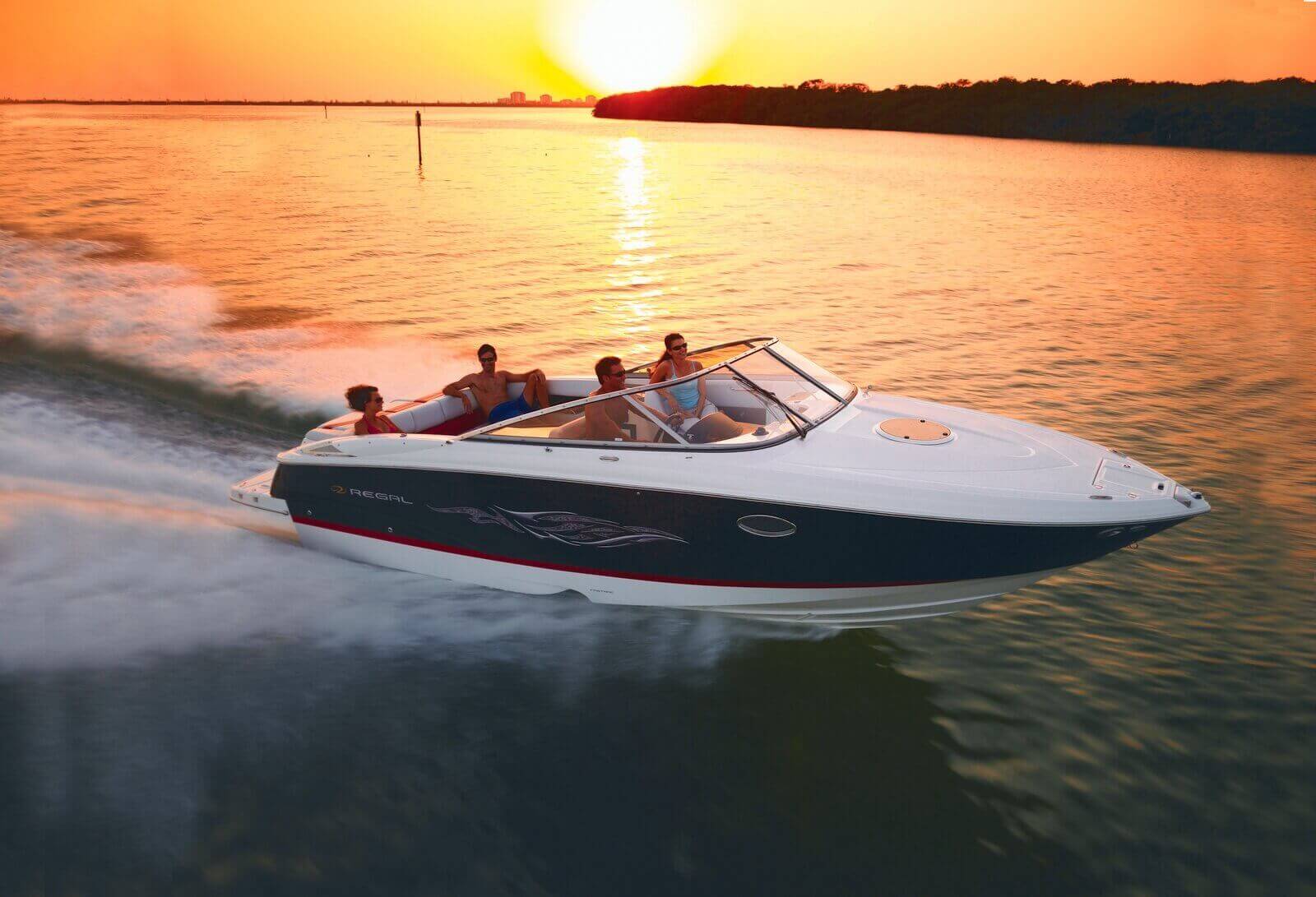
Special category of vessels
A particular type of boats on the sea are gulets. It is a larger wooden sailboat with a length of 20 to 35 meters with sails and engines (that is, according to its length, either a recreational vessel or already a nautical yacht). The crew of three to four persons (captain, hostess, cook, lifeguard) is already on board. Boats originate in Turkey and are mostly over 20 years old. However, for reasons of commercial chartering, they had undergone a complete refurbishment a few years ago. It is a combination of a sailing yacht and a motor yacht with more space, where you can enjoy the atmosphere of pirate times. In the case of the gulet, you can rent the entire boat, or each guest can rent an individual cabin. In this case, it is called the Cabin charter. During the week you can meet tourists from all over the world, who have decided to enjoy a new phenomenon – A holiday on a boat.
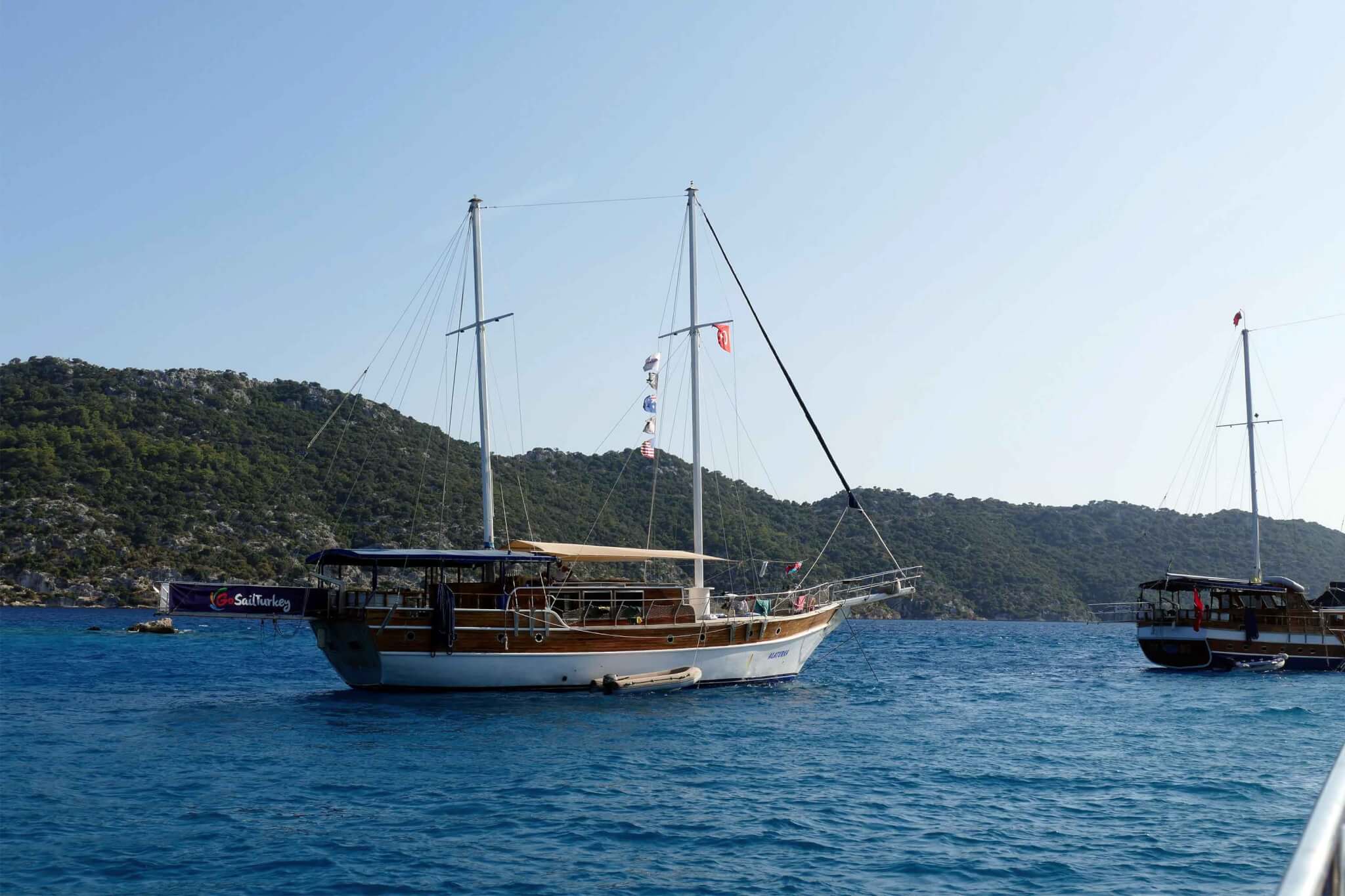
There are a lot of options, which you can choose. In our offer, you can find recreational crafts since we prefer the privacy on a boat over big and crowded yachts (so-called cruisers). Our boat charter also includes a more personal approach, more privacy, free program, and discovering holiday destinations. Click here to view our boat offer. If you would like to read more about our boats, we have written about two of them in this article .
So, have you chosen your dream boat holiday? 🙂
More articles
Desire for an experiences, reserve a boat.
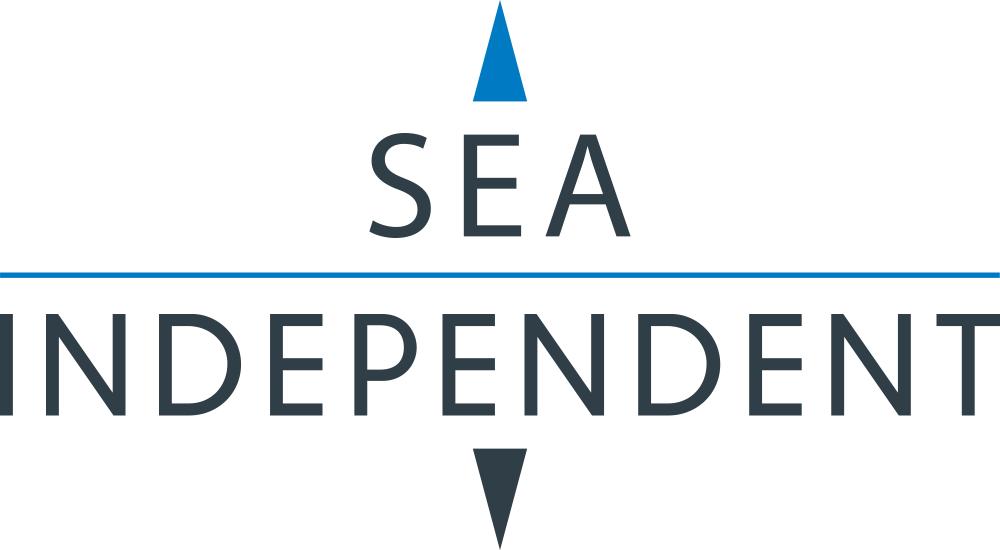
- All Sailing Yachts Motor Yachts Charters Classic Yachts Berths Multihulls Tenders & Runaboats Motor Sailors New & Custom Designed Yachts House Boats Search for:
- Yachts & More
- worldwide network
- Sell your Yacht
- Certified Valuation Reports
- Yacht and Crew Management
- Philosophy and Approach
- Meet the Sea Independender
- Worldwide yacht brokers
Motor Yacht or Power Catamaran? Which is better?
With a Motor Yacht's power, sophistication, and space, you can explore an ocean of possibilities. Our range provides exceptional performance at sea, with magnificent panoramic views from their luminous interiors, impressive power, excellent fuel efficiency, and world-class safety.
Step onboard and feel the rush of power colliding with beauty. With Catamaran motor yachts, you can explore new horizons and have no regrets.
Power Catamaran Boats
Power catamarans are power boats featuring two hulls and are gaining popularity because of their maneuverability, stability, and comfortable ride. Given their dual hulls, they have spacious cabins and more deck space than traditional monohull powerboats. Due to the ample deck space, they make excellent fishing boats and great day and pleasure boats due to their contemporary design.
How are Power Catamarans Constructed?
A power catamaran's two hulls are designed to sail through waves with less drag, increasing fuel efficiency and delivering ride comfort. Many modern power catamarans feature stepped hulls and vented hull technology. These vessels range in length from 19 to more than 100 feet.
Which Engines Power Catamaran Boats?
Outboard motors positioned on the rear transom power most smaller power catamarans. Options vary, but power ranges consisting from a single 100 HP engine to triple or quad outboards with top speed and very high cruising are standard. Larger power catamaran boats are frequently powered by inboard engines, while others use jet propulsion.
What Equipment is Available for Power Catamaran Boats?
Power Catamaran boats come equipped with fish finders, rod holders, navigation equipment, radar, riggers, premium marine sound systems, galley, head, luxury upholstery, and appliances.
Private staterooms, premium upholstery, and a variety of entertainment options such as televisions, hot tubs, and marine stereo systems are standard on more extensive, luxury power catamaran boats.
The Best Power Catamaran Boats
World Cat, Fountaine Pajot, Leopard, Invincible, and Aquila, are some of the most recognised and skilled builders of quality power catamarans today. These companies build luxury power catamarans with inboard, outboard-4S, electric, outboard, and inboard/outboard propulsion systems that can run on diesel, gas, electric, or other fuel systems.
Aquila, Fountaine Pajot, Leopard, Goetz, and Silent were the top five brands that received the most views for power catamarans.
Power Catamaran Pricing
Power Catamarans range in prices from $19,500 for the most affordable models to $8,760,000 for the more costly ones. When considering the listing price and your budget, keep the cost of ownership in mind.
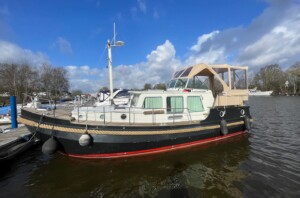
Length 10.80m
VAT status Paid
Price 122,000 EUR
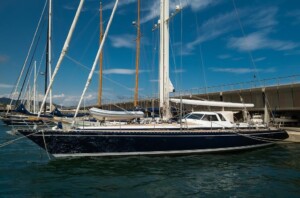
Length 22.20m
Price 670,000 EUR
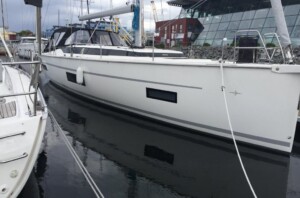
S/Y Bavaria C45 ''Kaia
Length 14.31m
VAT status paid
Price 309,900 EUR
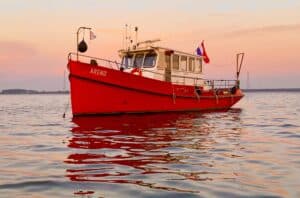
Seagoing Motor Ship
Length 14.99m
VAT status Not Paid
Price 149,000 EUR
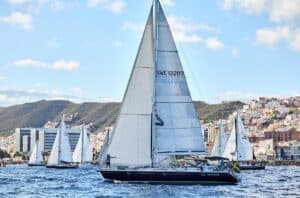
Janneau Sun Odyssey 52.2
Length 15.32m
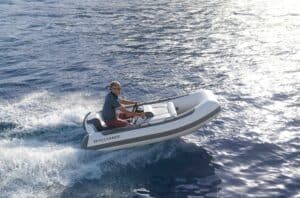
Williams Minijet 280
Length 2.79m
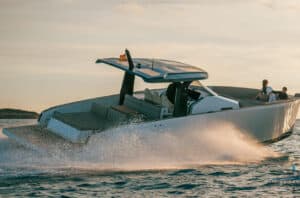
Tesoro Yachts T-40
Length 12.36m
Price on request
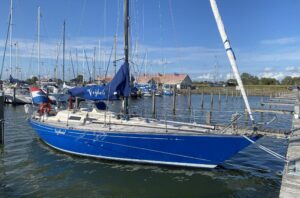
Length 11.2m
Price 50,000 EUR
Monohull Boats Vs. Expert Power Catamarans
Buying a boat is a significant investment, and you will want to fully understand the distinctions between the most popular hull types. Here, we highlight some of the critical differences between Catamaran and Monohull boats:
Ride Comfort
One of the most important aspects of any watercraft is how effectively it is engineered to deliver a comfortable ride for all occupants. Many boats are primarily designed for the captain's comfort. This usually means that anyone near the bow or sides of the boat takes the brunt of the jostling. The catamaran-style hull has three distinct characteristics that are important for ride comfort, load distribution, smoothness, and stability.
The catamaran yacht's larger footprint mitigates the effects of unpredictability while at sea. The effective hull design reduces resistance and enables faster forward motion, particularly in rough conditions.
Monohull Motor Yacht
The monohull vessel's narrow design relies heavily on the tranquilly of the water to guarantee a smooth ride. Given the greater surface area in contact with the water, the bouncing, slapping, and choppiness experienced by the monohull are much more significant.
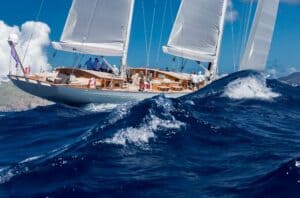
Sailing Yachts
20 Products
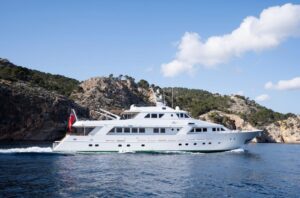
Motor Yachts
21 Products
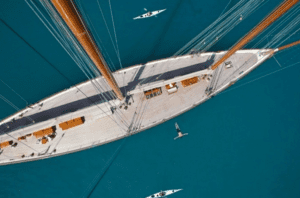
10 Products
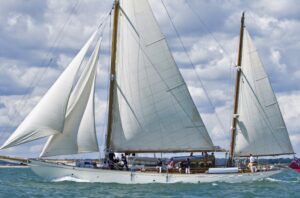
Classic Yachts
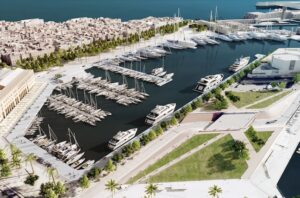
Tenders & Runaboats
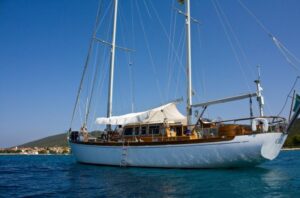
Motor Sailors
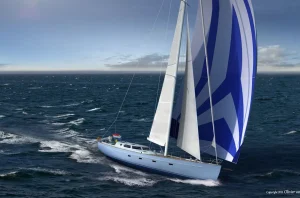
New & Custom Designed Yachts
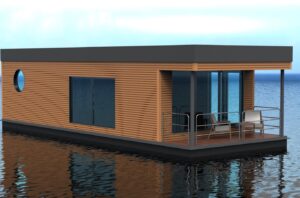
House Boats
The parallel hulls of catamarans create reliable form stability, which limits heeling and capsizing and significantly reduces vessel roll at rest and trolling speeds. The elimination of seasickness for riders is one of the most apparent benefits of catamaran stability.
Motor Yacht
The stability of this boat can be called into question more quickly than that of a catamaran because a monohull boat requires four times less force to capsize than an evenly sized catamaran. Heeling is also a more significant issue for monohulls, as their single-beam design makes them seven times more vulnerable to it than a comparably sized catamaran.
Load Distribution
The catamaran's rectangular shape makes better use of space, allowing passengers to stretch out and enjoy the experience even from the bow. Occupants can also fish from either side of the deck, rather than having to adjust to ensure equal weight distribution, as with monohull designs. This is due to the catamaran's higher resistance to capsizing.
You've almost certainly sailed on a monohull-style boat and are aware of their tendency to dip and rock when passengers board and depart. A simple analogy best explains this unfortunate feature of monohull boats: catamarans are like standing on two legs, whereas monohull vessels are like balancing on one leg.
Catamaran Deck Space
The catamaran beam is carried completely forward, giving the main deck a rectangular shape and more workable deck space than a monohull boat.
Monohull Deck Space
In contrast to the rectangular shape of a catamaran, boats have a pinched bow that comes to a point. This feature reduces the monohull's space efficiency.
Find Your Perfect Power Catamaran Motor Yacht
View our Catamaran Listings and Motor Yacht Listings to select the perfect boat type for your needs.
- You need Polylang or WPML plugin for this to work. You can remove it from Theme Options.
Username or email address *
Password *
Remember me Log in
Lost your password?

Catamaran vs Yacht

When getting into sailing, there are so many types of boats you can choose from—pontoons, tritoons, catamarans, yachts, sailboats, fishing boats, deck boats—and all of them have different advantages and disadvantages when getting out into the water. But when it comes to a catamaran or a yacht, which is better, and what are the costs to calling one your own?
Table of Contents
What is a catamaran?
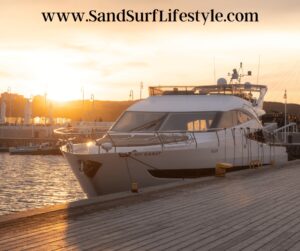
Catamarans come from the peoples of the Indian and Pacific Oceans, who used this form of boat to expand from island to island. The word itself is derived from the Tamil word “kattumaram” which means “logs bound together.”
Because of their construction, they usually have less hull volume, which means they have a shallower draft and a smaller displacement. They are also more hydrodynamic comparatively and require less power than another monohulled boat of the same size. The wide hull of the catamaran also reduces the likelihood that it will heel, or start to roll, in the wind. The wide stance also reduces the wake that the boat gives off.
It is possible to race with catamarans, especially if you are looking for both speed and stability overcapacity. Catamarans built for recreation and sport can be launched and landed from a beach and usually contain a crew of two.
What is a yacht?
A yacht is a blanket term for a boat that uses either sails or power for cruising, racing, or pleasure. While there is no real definition for a yacht, they are typically any sort of boat that has a cabin for overnight use and is a pleasure vessel over 30 feet in length.
There are different sizes of yachts under certain designations—any yacht over 79 feet is considered large, while any yacht over 131 feet is considered a superyacht or megayacht.
The word yacht comes from the Dutch language, which means “hunt.” It started as the name of the fast-sailing ships that the Dutch used to hunt for pirates in the 18th Century. The concept of pleasure boats, though, started early in the world’s history in Egyptian times and only increased in popularity as time went on.
There are several types of propulsion for yachts—sailing, which is when they use sails to catch the air and power. Yachts first started with steam power before turning to the internal combustion engine.
Most yachts, if large enough to accommodate, have a main salon and a forward stateroom in terms of cabins. The larger the yacht, the more rooms it may have.
Catamaran vs. Yacht: Structural Differences
If you are looking for a cruising catamaran, you will need a larger boat than the monohull counterparts. While a monohull can be small, usually around 30 feet, if you want the same sort of carrying capacity out of a catamaran, you will need a boat upwards of 40 feet.
Because of their larger size and width, catamarans will take up more space in your marina, but they are also more spacious than other boats—that width is not put to waste on the deck or underneath.
The double-hulled catamaran also gives more privacy when it comes to the living spaces—the cabins are conveniently separated, keeping the living quarters and sleeping quarters apart on most catamarans.
Looking to purchase a catamaran? Here are the pros and cons of owning one.
Catamaran vs. yacht: performance differences.
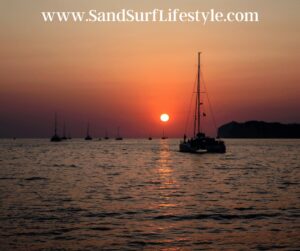
That speed, though, comes at a price—because they have two hulls, you will hear the water slapping against the boat from underneath, which is something you do not get with a monohulled boat.
Because they have two hulls, catamarans are nearly resistant to any sort of heeling, compared to a yacht. They also have extremely high resistance to capsizing, due to their multi-hulled construction. This stability allows for passengers to easily navigate the deck without fear of suffering from wave action. This stability will also let you cook and do any other activities on the deck without fear of displacement.
Catamarans are also easier to handle than another type of boat—one person can singlehandedly sail such a vessel. Because you have two engines and two rudders, it is easier to dock and maneuver compared to a monohulled boat.
Yachts tack much quicker than a catamaran as well—when you turn into the wind so you change which direction the wind blows on the ship—meaning your catamaran will slow down significantly as you turn. A monohull is more maneuverable in the wind.
Catamaran vs. Yacht: Cost Differences
A new, high-quality catamaran larger than 40 feet can run about half a million in cost. Pre-owned catamarans can run as low as $35,000, while larger, new catamarans can exceed $5 million.
Catamarans will also cost more because of the need for two engines and two rudders. The double hull means more equipment, which therefore increases the price. They also use different types of materials, making that cost increase. They also are typically higher quality construction and are safer and easy to sail, pushing the price higher. Because of this equipment increase, your service costs will also be higher.
If you are looking for a smaller yacht, those would put you within the 50 to 70 feet range. Choices also include the engine and optional equipment, along with whether you intend to purchase a new or a pre-owned yacht. New yachts in this size range can run about
Pre-owned yachts of this size can run anywhere between $300,000 for a smaller model to almost $6 million for a larger one. Most around 50 feet are an average of $375,000.
Catamaran vs. Yacht: Which is better?
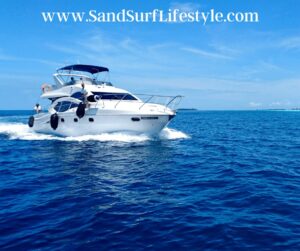
If you want to stay with the traditional sailing experience with more feedback about how your ship is moving, along with keeping a smaller footprint both on the water and in the marina, a yacht is the way to go. They are much more maneuverable than a catamaran in the water. Yachts are also cheaper than a catamaran.
Regardless of what you’re looking for in a boat, the choice remains with you about what you value most in your travels. Whether it’s a catamaran, a yacht, or something entirely different, know what you are looking for in your vessel before going out and looking to buy.
Please note: This blog post is for educational purposes only and does not constitute legal or medical advice. Please consult a legal expert or medical professional to address your specific needs.
Aloha! My name is Shawn and I Love the Beach and Ocean! From surfing to beach sports to boating and fishing I like it all. More importantly, I Love the people I get to meet who also share a passion for the sand and surf. Living and growing up near the ocean my heart has always been connected to the beach and its lifestyle. I wish to share my experience with those around the world. Mahalo (Thank You) for visiting and enjoy your stay here on my site!
Recent Posts
Adaptive Surfing: Overcoming Challenges and Inspiring Stories
As an Amazon Associate, I earn from qualifying purchases.Adaptive surfing has truly opened my eyes to the power of resilience and determination. The sport's inclusive nature has broadened my...
Spotlight on Surfing Destinations: Hawaii Edition
As an Amazon Associate, I earn from qualifying purchases.Exploring Hawaii's Surfing ParadiseSurfing in Hawaii has been a dream come true for me, as it's where I've discovered some of the most...
- THE PRINCESS PASSPORT
- Email Newsletter
- Yacht Walkthroughs
- Destinations
- Electronics
- Boating Safety

The Power Catamaran Compilation
- By Yachting Staff
- Updated: December 21, 2018
Power Catamarans have been growing leaps and bounds in popularity, and, in lengths and widths. And for good reason. These cruise-centric yachts offer homelike livability for avid travelers, are fuel efficient and are fairly intuitive to run. Power cats are popular in the bareboat charter market too, for these very reasons.
Here, we take a look at 12 catamarans ranging from a cruising-couple-size 36-footer to a 78-footer for friends, family and some more friends. And there are myriad power options: outboards, diesel inboards, hybrid or even all-solar power.
Fountaine Pajot MY44
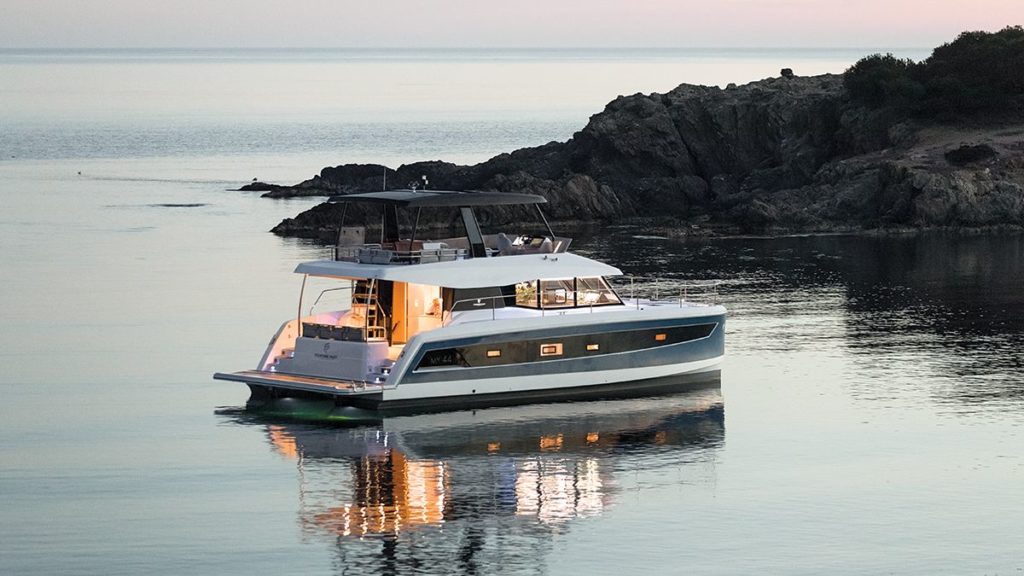
The Fountaine Pajot MY44 , a creation of Italian architect Pierangelo Andreani and French designer Daniel Andrieu, has a main deck that’s open from the aft-deck seating all the way forward to the starboard helm station. The sense of spaciousness is significant, for several reasons. First, four glass panels aft can all slide to port, creating an indoor-outdoor space with the aft deck and salon. In the salon, 32-inch-high windows extend for 12 feet down the sides of the yacht, with three sections per side, bringing in natural light along with the three forward panes that comprise the windshield. Finally, 6-foot-6-inch headroom provides vertical clearance, with a 21-foot-7-inch beam that adds interior roominess while keeping the yacht stable.
Read more: Fountaine Pajot MY44
Silent-Yachts 55
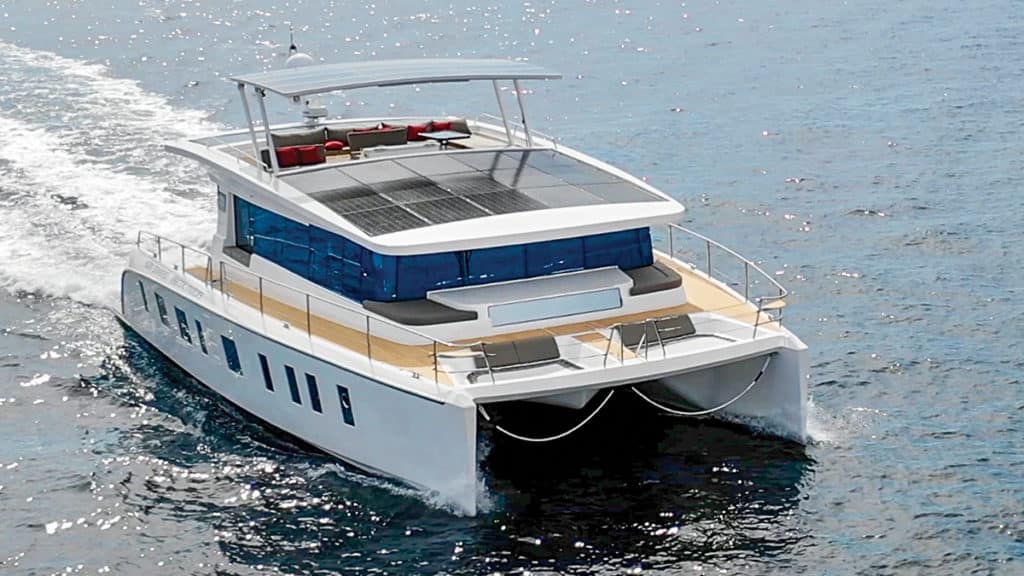
The ideas about which solar panels, electric motors, inverters and the like to use — and more importantly, Michael Köhler says, how to configure them — became the basis for the brand Silent-Yachts. The company offers 55-, 64- and 79-foot catamarans that run on solar-electric propulsion. The Silent 55 premiered this fall, and the 64 is sold out for the next two years, Köhler says.
Read more: Silent 55

Horizon PC74
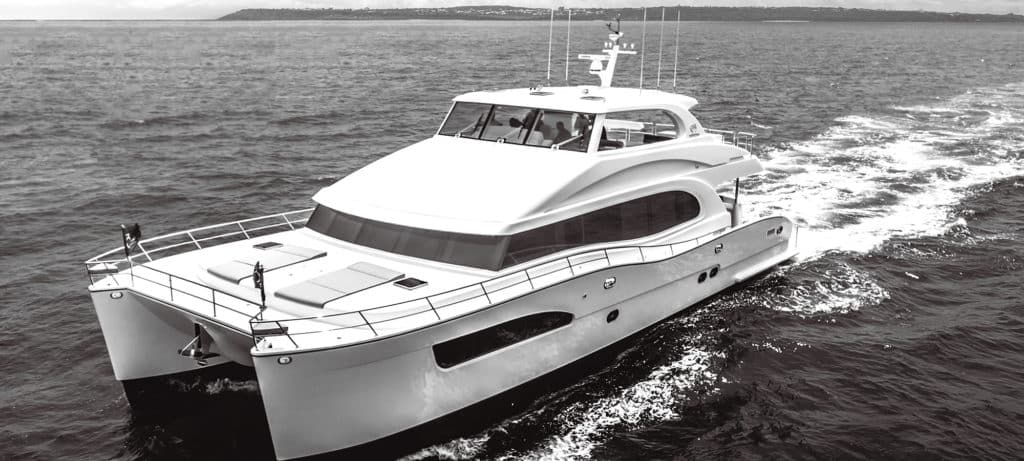
As founder and director of The Powercat Company, a Horizon Power Catamarans distributor, Stuart Hegerstrom had long believed that catamaran builders needed to design their yachts to more stylish standards.
“The boats were very boxy,” he says, based on his years of experience with cats in the charter market. He and his partner, Richard Ford, asked Horizon to produce models that had high-end finishes and looked good inside and out.
The Horizon team brought in mega-yacht designer JC Espinosa to work with its own craftsmen. The result aboard the Horizon PC74 is a catamaran with exterior styling, layout and functionality that should appeal to private and charter owners alike.
Read more: Horizon PC74
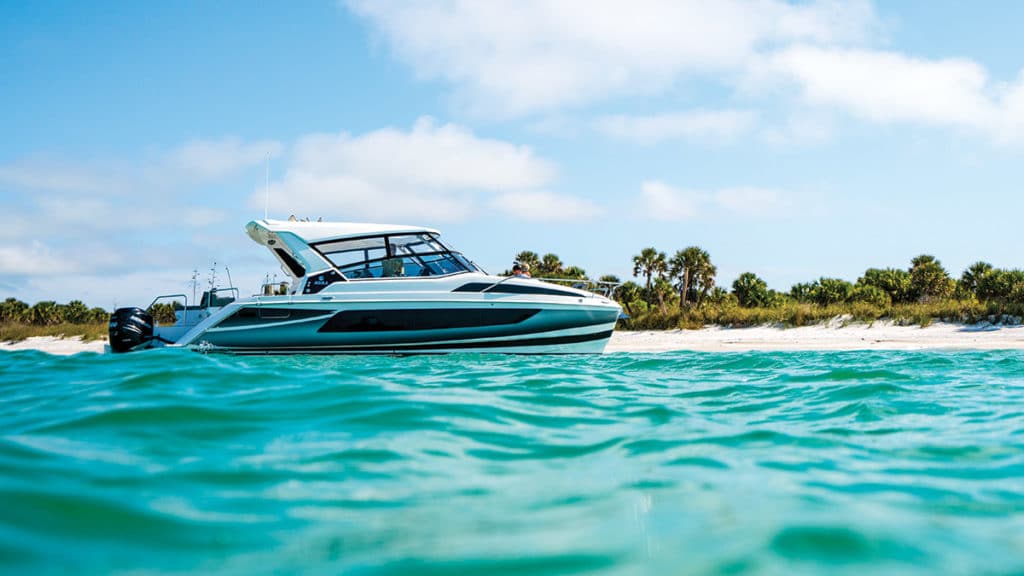
The Aquila 36 is a departure from her sisterships in that she is an outboard-powered, express-cruiser-style catamaran, but she also adheres to MarineMax’s philosophies.
With a single main living level from bow to stern and a beam of 14 feet 7 inches, the Aquila 36 is like a bowrider on steroids. She has seating that can handle 20 adults for outings and barbecues, and there are two staterooms below, one in each hull, for family weekending. The staterooms have nearly queen-size berths, en suite heads, stowage and 6-foot-6-inch headroom.
Read more: Aquila 36
Lagoon Seventy 8 Powercat
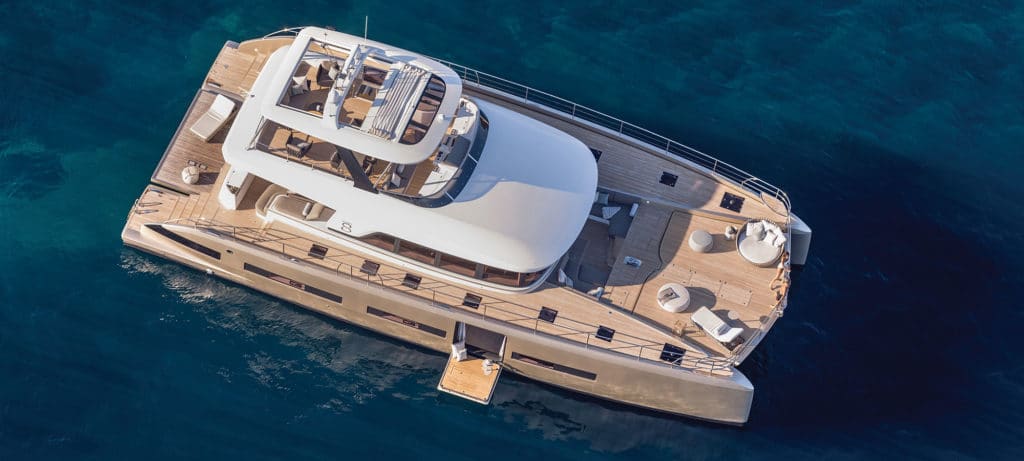
Lagoon is a division of Groupe Beneteau, the world’s largest builder of sailing yachts, and the Lagoon Seventy 8 Powercat is a developmental sistership of its Seventy 7 super sailing cat. The Seventy series yachts are built at Construction Navale Bordeaux in France, which had to add a new yard to construct these catamarans because they require separate stern molds for the power and sail versions.
Read more: Lagoon Seventy 8 Powercat
Horizon PC60
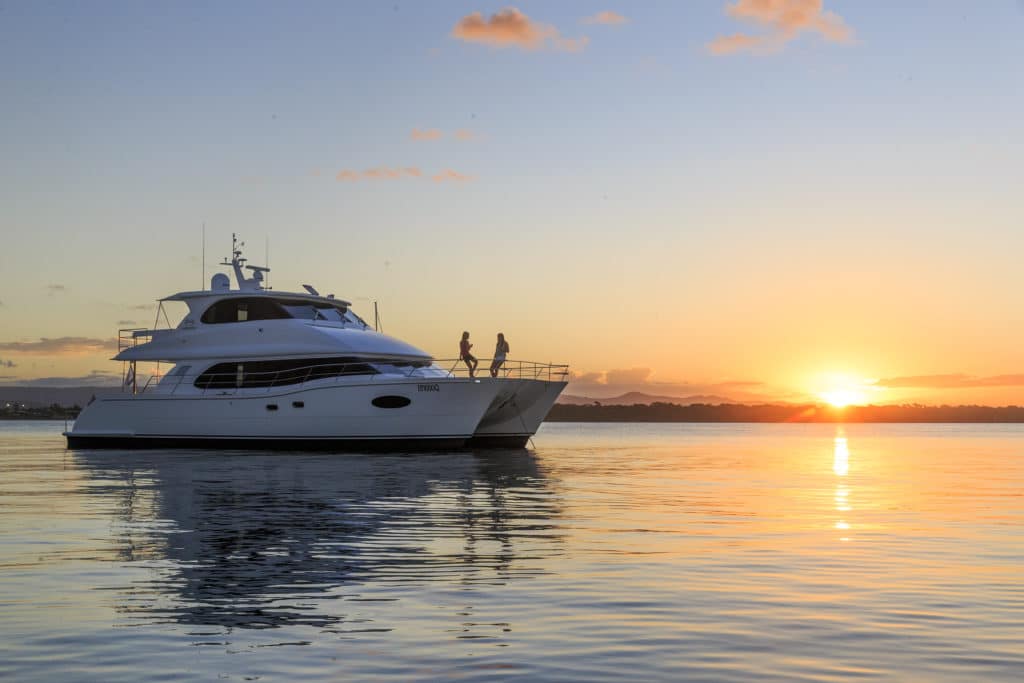
To understand the Horizon PC60 power catamaran , you need to put aside preconceived notions about midsize yacht amenities. For example, main-deck master suites are the province of yachts over 100 feet length overall. Incorrect. This 60-footer has an elegant and spacious owner’s stateroom on the same level as the salon. If you want a 14-foot center console tender on a 60-foot yacht, you have to tow it. Wrong again. On the PC60, you hoist it onto the upper deck, no problem.
Read more: Horizon PC60
40 Open Sunreef Power
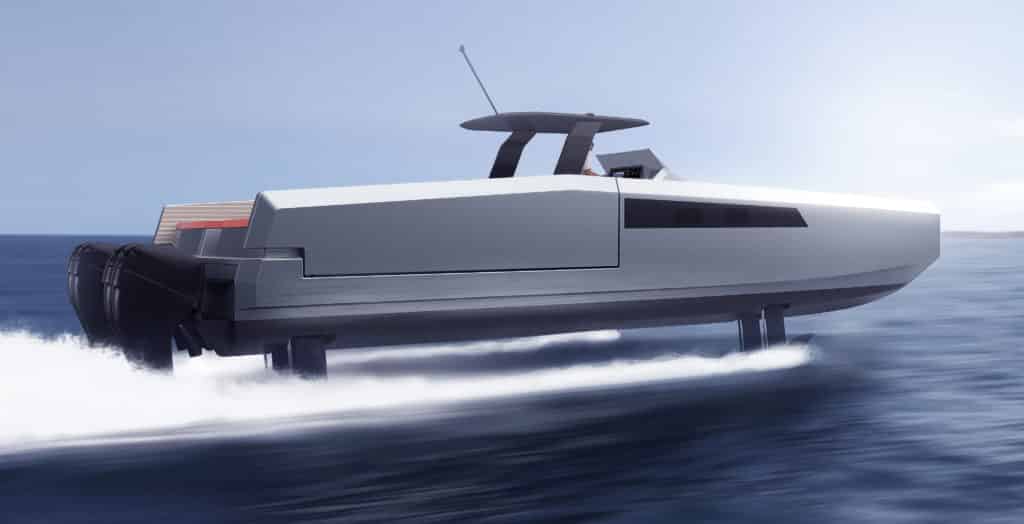
Sunreef is known for pushing the boundaries of catamaran design, incorporating four adjustable hydrofoils into a twin-hulled speedboat.
The Polish builder is one of several European builders (including Evo, Fjord, Wider and Wally) transforming the open day-boat category with creative designs. Beyond its hydrofoils, the 40 Open Sunreef Power ‘s cockpit has side “wings” along the aft gunwales that fold out at anchor, widening the beam from 17 feet to 22 feet 9 inches.
Read more: 40 Open Sunreef Power
Sunreef 50 Amber Limited Edition
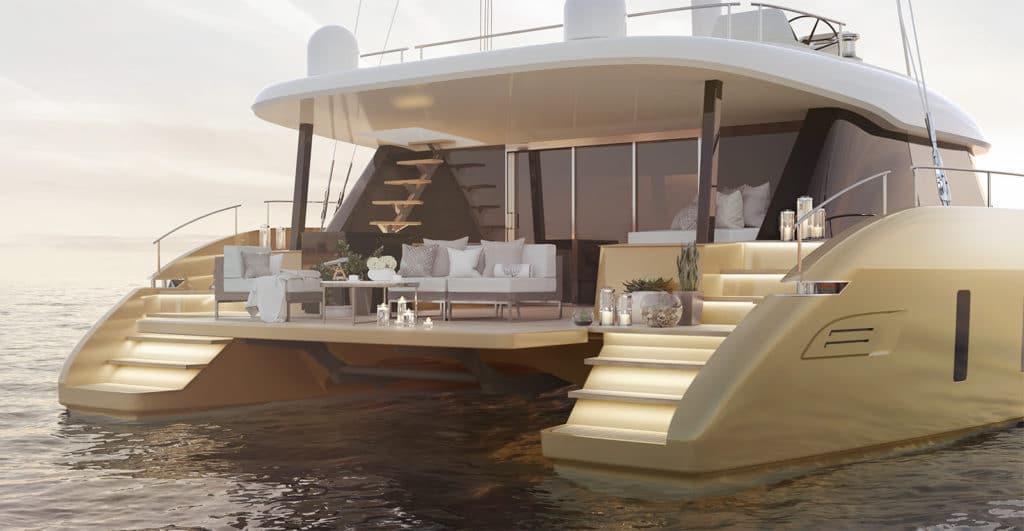
Sunreef Yachts introduced its 50 Amber Limited Edition , with plans to launch just 10 hulls of the exclusive design.
The Sunreef 50 Amber Limited Edition will have a carbon fiber mast and boom, four layout options and numerous amber-colored elements, including the hull.
Read more: Sunreef 50 Amber Limited Edition
Lagoon 630 Motor Yacht
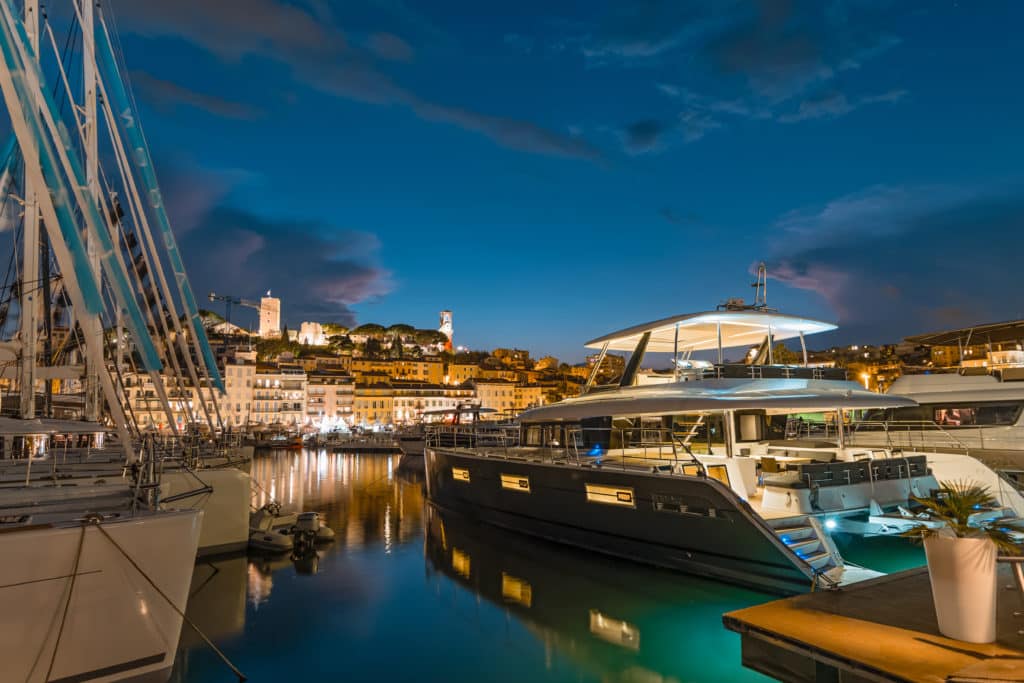
Fitted with the optional twin 300-horsepower Volvo Penta D4 diesels, the Lagoon 630 MY burns only 1.64 gph total at 6 knots, giving a theoretical range of 2,952 nautical miles with standard tankage of 793 gallons. Hull No. 1 had an optional 502-gallon tank, giving it transatlantic range.
Luxury, stability and economy are all hallmarks of Lagoon’s return to luxury motor yachts. If you can take a ride, it will be worth your time.
Read more: Lagoon 630 Motor Yacht
Fountaine Pajot MY 37
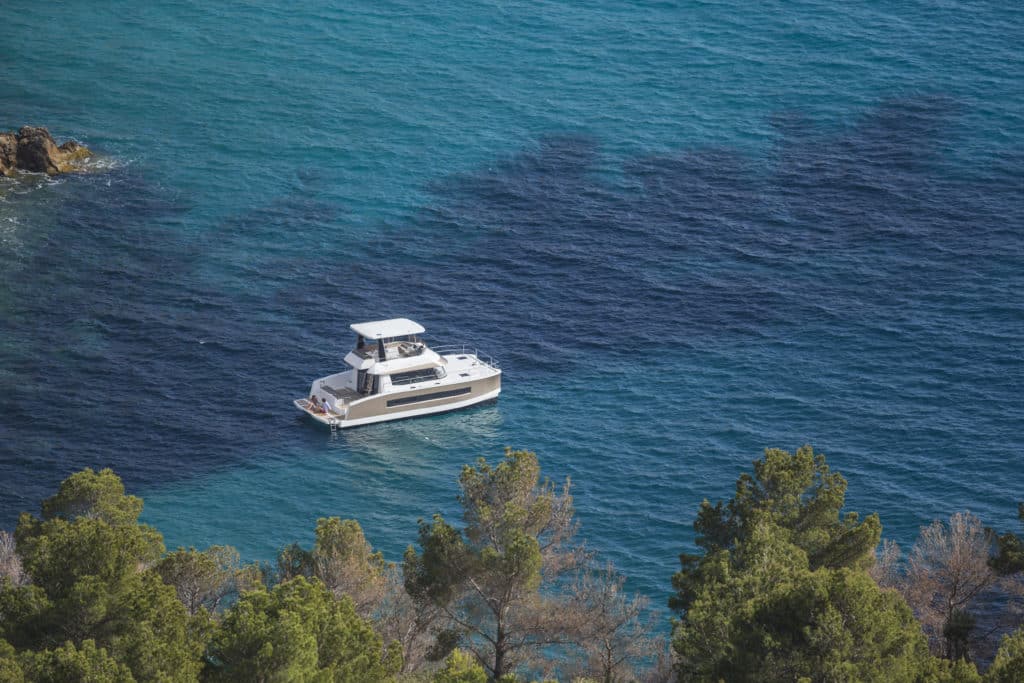
The Fountaine Pajot MY 37 easily accommodates the seafaring family with three- and four-stateroom options. In the three-cabin version, called Maestro, you’ll find an owner’s suite in the portside hull with a queen-size berth and en suite head. Two double-berth cabins and one more head are available for the kids. If your brood is bigger, the Quator setup features four double cabins with two heads.
The 37 is a traveler and can be powered with twin 150 hp or 220 hp Volvo Penta diesels. Top speed with the smaller engines is 17 knots, while it’s 20 knots with the bigger power plants. Interestingly, at 7 knots, the fuel consumption is the same, with either set of motors offering voyagers a 1 ,000-nm range.
Read more: Fountaine Pajot MY 37
Solarwave 64
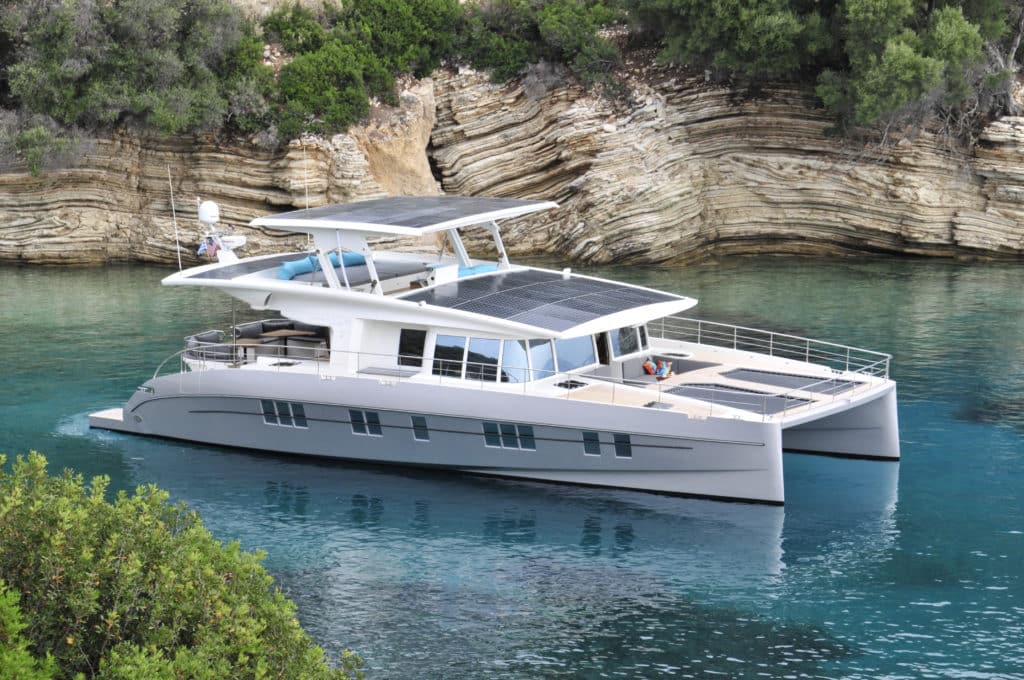
Many yachts boast eco chops because they have a handful of solar panels that power the microwave or navigation lights. The Solarwave 64 , launched last summer, has the potential to run on sunshine alone. The vessel’s 42 solar panels generate 15 kW that are stored in batteries weighing about 1,300 pounds. They connect to electric motors.
Read more: Solarwave 64
Glider SS18
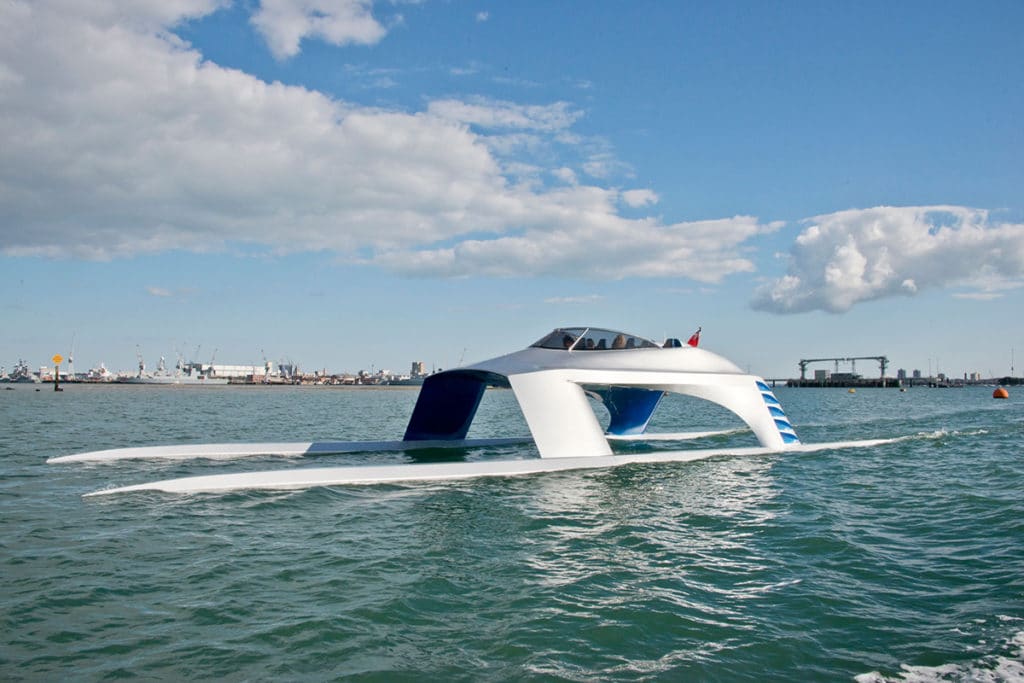
This British builder says it strives for design innovation and the Glider SS18 displays that DNA, the result of 8 years of research and development. She has a head-turning, catamaran hull form constructed from aluminum and composite materials. She is 60 feet LOA with a 17-foot beam, and has a relatively shallow 1-foot draft. Powered by quad Yamaha 300 hp outboards, she can reportedly reach 50 knots, and with her Stability Control System (SCS), should give a smooth ride while doing it.
Read more: Glider SS18
- More: aquila , Aquila Boats , Express and Flybridge Cruisers , Fountain Pajot , Glider Yachts , Horizon Power Catamarans , Lagoon , Power Catamarans , Silent-Yachts , Sunreef , Yachts
- More Yachts

Merritt 88 Skybridge Reviewed

Tankoa Launches “Diamond Binta”

Duffie Boatworks 70 Reviewed

Sunseeker Predator 55 Prepares for Debut

Albemarle 53 Spencer Edition Reviewed

For Sale: 2019 Palm Beach GT50

- Digital Edition
- Customer Service
- Privacy Policy
- Email Newsletters
- Cruising World
- Sailing World
- Salt Water Sportsman
- Sport Fishing
- Wakeboarding
You make the memories. We make the arrangements.
Motor Yacht or Sailing Yacht?
Chartering a luxury yacht is the ultimate way to experience a truly personalized vacation. While...
Table of Contents
Motor yachts, sailing yachts .
Chartering a luxury yacht is the ultimate way to experience a truly personalized vacation. While the destination is of utmost importance, the yacht you choose is equally significant. With so many yacht styles, sizes and amenities, it can be hard to keep things straight. Especially for first-time yachters. To help you understand the differences between luxury motor yacht charters vs. sailing yacht charters, we’ve put together a quick guide.
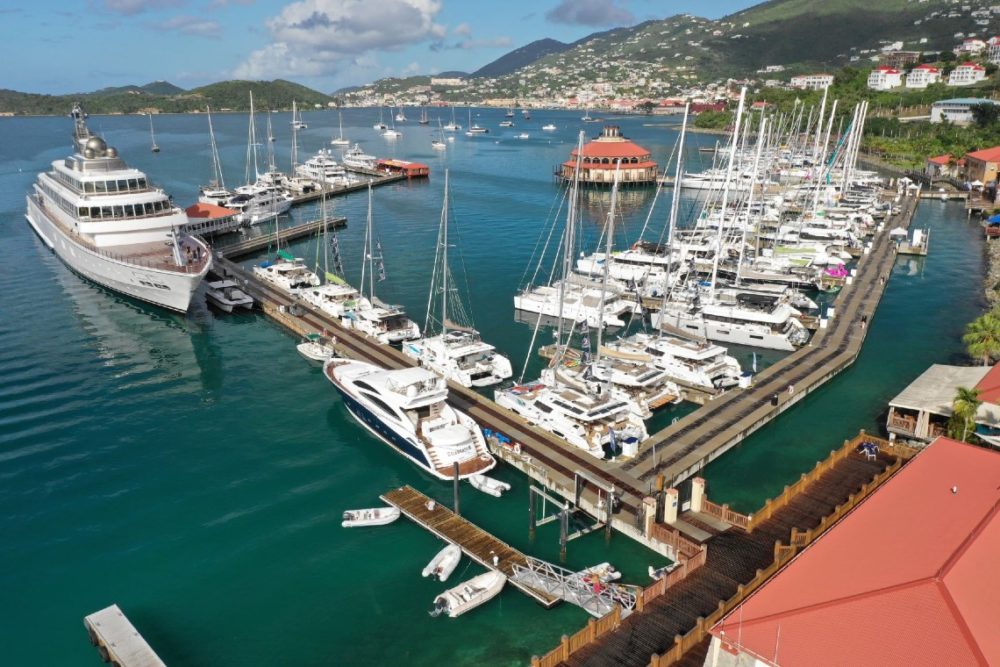
Super-Yachts & Mega-Yachts
The highly capable motor yacht can take you on Arctic expeditions, luxurious trips along the Italian Riviera , or snorkeling in the Bahamas. No matter the conditions outside, motor yachts deliver comfort, style, and plenty of room to unwind. Motor yachts are a luxury resort at sea, with many featuring gyms, pools, theaters, and more. Some even have helipads for effortlessly accessing even the most remote locations.
Large families or group vacations among friends can be easily accommodated on super-yachts (78ft+/24m) and megayachts (200ft+/60m). Numerous staterooms and flexible sleeping configurations allow for private spaces and many group gathering areas. Smaller yachts from 40ft+/12m are also great options for smaller groups or couples celebrating their honeymoon.
If you’re into water toys, many motor yachts carry numerous tenders from jet skis, to kiteboards, paddleboards, inflatables, and scuba equipment. Additionally, dedicated crew can be requested for instructing and accompanying guests on many water excursions. With the flexibility that comes with a motor yacht, some guests can choose to go fishing, while others can take the tender to shore for some beach time.
Speed is also a great attribute of motor yachts. You can experience more destinations in a shorter time with the power of 40+ knots, and no reliance on the wind. Their sheer size and advanced stabilizers also allow for smooth sailing while underway. Take a look at the luxurious accommodations aboard Superyacht Starship .
Motor Catamarans
Flexible, comfortable, and perfect for cruising shallow waters. That’s one way to describe the increasingly popular motor catamaran category. These yachts combine the agility of a smaller boat, with many of the conveniences of a large motor yacht. The dual hulls also allow for a more stable ride while underway. Lack of sails provides a lower clearance for added flexibility in lower passages.
Smaller than most megayachts, catamarans can still typically accommodate groups of up to 12 and offer two or three levels of area for relaxing and dining. Many modern yachts even feature forward cockpit areas for secluded outdoor space in the front of the boat. Couples can easily share these boats without problems. While families can have their space spreading out on the flybridge as well as the main deck.
Motor Catamarans can also cruise at a quick clip, reaching 22-25 knots, depending on the boat and conditions. This allows for easy navigation of groups of islands like the USVI , Bahamas, Greece, and more. You can also get much closer to land in these gorgeous lagoon areas and tiny ports.
Water sports enthusiasts will appreciate the easy access to the water that catamarans boast. Drop anchor and swim, snorkel, or go kayaking within minutes. Most catamarans also carry dinghies or tenders to explore or tow inflatables.
Onboard, the galley and salon are prioritized with wide and easily traversed configurations perfect for gourmet dinners. Front deck areas often feature trampolines for relaxing and breezy sunbathing. What completes the package is the low fuel consumption that comes with the small engines and lighter-weight frames. Catamarans provide the option to enjoy a private yacht charter more economically.
Sailing Catamaran
Like the aforementioned power catamarans, the sailing catamaran yachts offer a very comfortable experience, suited for many top yachting locations around the world. They traverse these gorgeous waters, however, at a slower pace, reaching 9-10 knots per hour, depending on conditions and the boat’s engine. This is an important factor to consider when choosing between a motor yacht vs. sailing yacht.
Those in search of true relaxation will appreciate the quiet sailing of these luxury sailing catamarans, a major difference from luxury motor yachts. In addition, sailing enthusiasts can learn techniques and lend a helping hand to the crew if so desired.
Nearly all of the great designs of a power catamaran also exist aboard sail yachts. Flybridges and front cockpits allow for more distinct lounging and sightseeing vistas. As with power catamarans, the water is easily accessed, giving way to hours of water sports enjoyment.
Gliding through the water with two hulls, these sailing catamarans navigate the seas more flatly than traditional mono-hull sailboats, also adding comfort and stability. Also important, sailing catamarans can travel long distances without the need for refueling. Not to mention the lower fuel costs and the smaller environmental footprint this amounts to. A factor to note when choosing between a motor yacht vs. sailing yacht.
A sailboat yacht charter offers guests a truly unique and exciting experience. Most notably, you have the great opportunity to learn sailing terminology, equipment, and maneuvers. You’ll be able to participate in the journey while gaining expert knowledge from the seasoned crew.
In addition, you’ll love the quiet experience and thrill of being propelled by the wind, just as explorers have been doing for millennia. Activities like fishing, swimming, snorkeling are easily reached from the boat.
Larger toys like jet skis or motorized equipment are however not as readily available. The shape of sailing yachts does limit some storage, typically found on powerboats. However, the captain and crew will do their best to accommodate all guests' preferences and desires.
Traditional sailboat yachts can reach lengths of 220 ft, enabling large groups to charter in total comfort. The large decks, some with flybridges flow elegantly into interior salons. The staterooms also offer great space and amenities for entertainment and dining.
Utilizing the wind for as much travel as possible, sail yachts can travel further distances without the need for stopping to refuel. In some cases, sailboats are the only way to reach very remote islands and blue water attractions. This of course also means very low fuel consumption in comparison to power yachts.
We hope this helps you in choosing between chartering a luxury motor yacht vs. sailing yacht. Please visit our wide array of luxury yachts for charter and let us plan your dream trip today!
Similar Posts
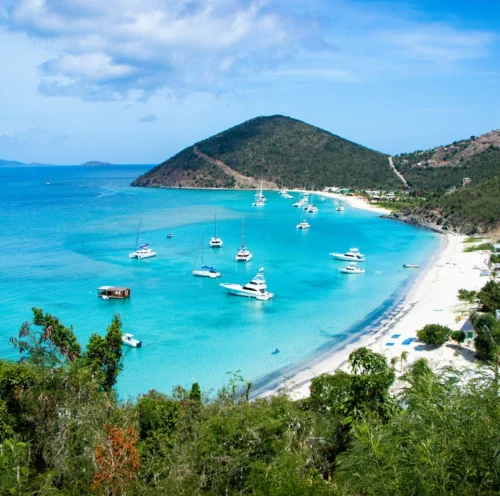
Discover Virgin Island Yacht Charters
Set sail on a luxurious adventure with Virgin Island yacht charters. Discover the breathtaking beauty...
Read Discover Virgin Island Yacht Charters
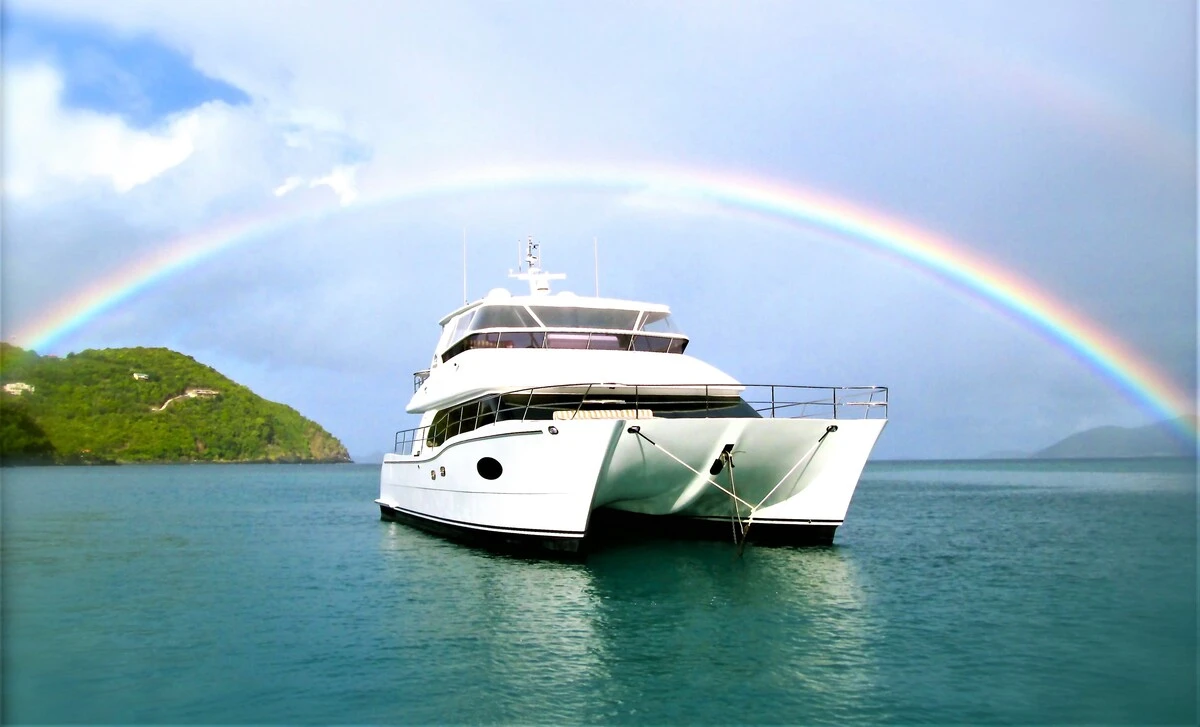
Navigating Paradise: Ultimate Catamaran Rental Guide
Discover the Joy of a Catamaran Rental Catamaran rental offers a unique way to explore...
Read Navigating Paradise: Ultimate Catamaran Rental Guide
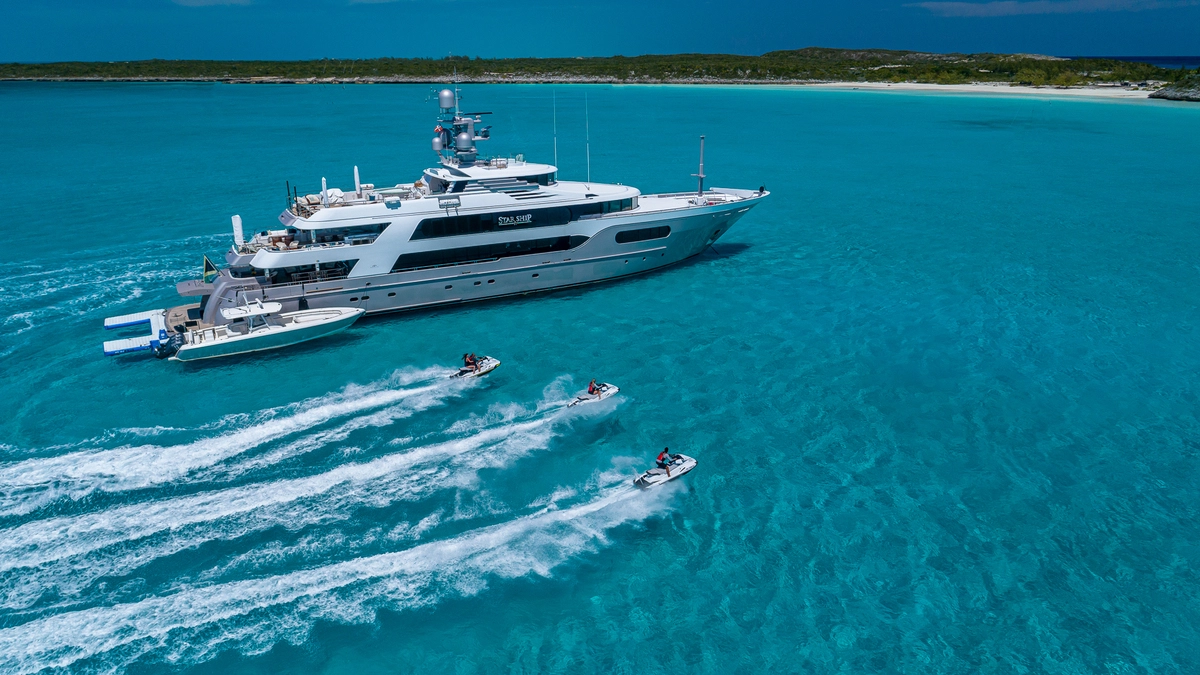
Best Private Yacht Vacations | Explore Top Destinations
Luxury yacht charters offer private yacht vacations, combining comfort, privacy, and adventure. With various yachts...
Read Best Private Yacht Vacations | Explore Top Destinations
Let us deliver on your dream vacation.
Contact us to start a conversation about your dream vacation, and let us show you how we can help bring your vision to life through our exceptional yacht charter services.
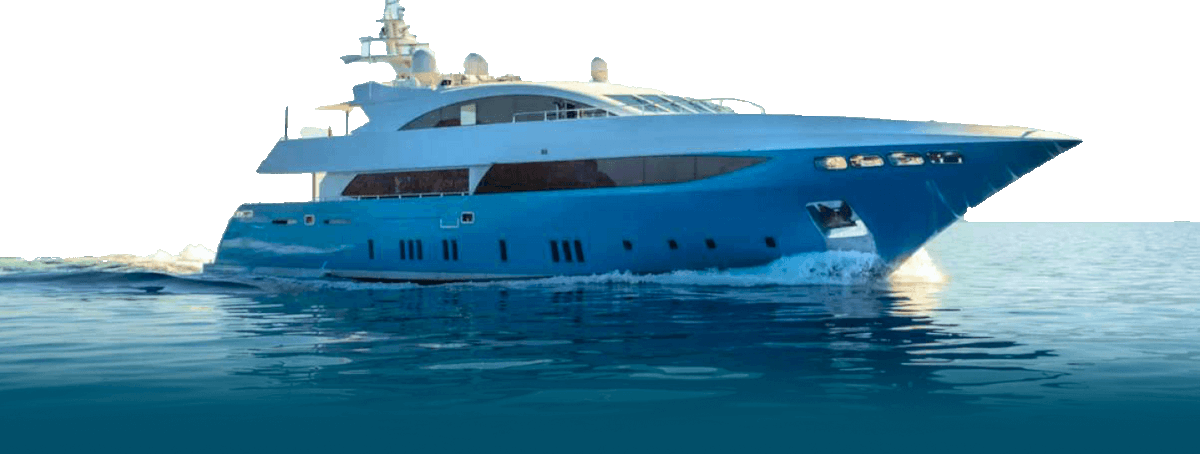

Catamaran vs. Monohull: We Changed, Should You?

There are two schools of thought when it comes to monohull versus catamaran . We have done extensive cruising and lived aboard two monohulls and four catamarans over the past 25+ years . We experienced the good and the bad for both single hull and multihulls first hand. Quite honestly, the pluses for catamarans far outweigh the minuses. There are multiple benefits of catamarans. They are faster, more stable and spacious, and have shallower drafts allowing safer anchorage closer to shore. Being on a stable platform with no heeling cuts down on crew fatigue and seasickness leaving the crew more alert and in control of the vessel. Even novice sailors feel more confident on catamarans.
When we built our monohull Royal Salute in the early 90s, catamarans were not established and were looked upon with extreme suspicion by most cruisers, including ourselves. “Safety and the capsize” issue were always the first things to come up against sailing catamarans. It is a fact that monohulls can get rolled in heavy seas but will right themselves because of the heavy lead keel, and while crew and vessel will be battered, the roll is survivable.

However a catamaran once capsized, will remain upside down (jokingly referring to this state of the catamaran as “reaching its most stable position when upside down”). The inability of a catamaran to self-right was and still is a major bone of contention. However, what is not often discussed is that a monohull has about a 5,000 pound keel of lead that is constantly trying to drag the boat to the bottom of the ocean versus a catamaran that has no ballast and is in most cases with modern catamarans, unsinkable.
So the options are to either sail the world on a boat that, if it springs a leak, will sink like a stone or a vessel that cannot self-right in the event of a capsize but will not sink no matter what. So from a practical point of view, here are our observations over the last 25+ years of living aboard, on the advantages and disadvantages of a catamaran.
ADVANTAGES OF A CATAMARAN
1. speed equals safety.
The speed of a catamaran makes it possible to outrun bad weather. While catamarans do not point as high into the wind as a monohull (or if it does, it makes more leeway or slides sideways), it is about 20% faster than a monohull. This means that even if you sail upwind at a slightly wider angle to the wind than a monohull and have to cover more distance, you will still arrive at your destination long before a monohull.
A modern performance catamaran with daggerboards and good quality sails will point as high as a similar sized monohull. It will point the same as a comparable monohull and sail much faster and therefore arrive at an upwind position much sooner than a the monohull. It is important to note that most of the production catamarans on the market are under-powered and are equipped with standard smaller sails. In lighter breezes many of these designs perform poorly unless fitted with bigger headsails, a Code Zero and a square-top mainsail.
While we believe that more comfortable and safer in rough weather , we have to concede that when the weather gets really bad (60 knots of wind or more) we would personally prefer to be on a monohull from the standpoint of surviving. I would say that a monohull is preferable for serious offshore single-handed sailing because you can more easily hove-to in a monohull. We have been in some extreme weather on a number of catamarans and never really felt that we were in danger, although it takes some nifty seamanship.
A monohull could capsize in extreme weather or even roll in a storm, but they generally come back upright. A catamaran on the other hand, will not right itself. But the cat will generally stay afloat, offering a good place to survive while you wait out the storm or until help comes along. Well-designed modern catamarans are very hard to capsize though.
Having said all that, most catamarans can do 200 to 250 miles a day and with modern technology allowing one to pull down weather at will, there is no good reason why you should get caught in extreme weather. A faster boat is a safer boat as it will in many cases be able to outrun bad weather. With good weather routing information a catamaran can avoid most serious weather and, at worst, place itself in the most favorable position to avoid the brunt of a storm.
2. A Catamaran is a Stable, Safe Platform Underway
Catamarans have no ballast in the keels like monohulls do and therefor it relies on beam and buoyancy for stability. Typically cruising catamarans will have a beam to length ratio of roughly 50%, although many designs nowadays exceed the 50% rule of thumb. So, a 45-ft long catamaran will be about 22-ft wide, providing a very stable platform when sailing. Unlike catamarans, monohulls cannot overcome the rolling and pitching with their narrow beam and the lead ballast for stability.
This rolling and pitching makes the deck on a monohull very unsafe whereas on walking around on the deck of a catamaran while underway is far easier since the boat is much more stable, and it doesn’t heel. This makes sail changes and reefing much easier and a lot safer for the crew. Without the rolling and pitching motion, the danger of falling overboard on a catamaran is considerably less than on a monohull.
3. Crew Fatigue Reduces on a Catamaran
Because a catamaran does not heel over like a monohull, it offers far more comfort underway because the motion is mostly fore and aft pitching and very little beam-to-beam rolling. On all points of sail, a catamaran tracks upright and significantly reduces crew fatigue and seasickness. Seasickness is usually caused by things like anxiety, fatigue, hunger and cold, which all add to a sense of disorientation. This leads the crew to making bad decisions and seamanship errors that could be fatal to the crew and vessel. The more stable platform of the catamaran will hugely keep those issues at bay, making the crew more alert and energized.
Every action and chore including cooking is much easier on a catamaran when underway. It is much more pleasant to be on the deck level looking out rather than being stuck “down below.” It is also much nicer to sleep on a boat that doesn’t heel. I remember nights at sea in our monohull when I was rolling around in my bunk unless I was properly wedge in a little corner. That is simply not the case on catamarans.
All these factors ensure that your crew will not expend unnecessary energy to simply try and stay upright, onboard and safe on a long passage. Your crew on a catamaran will be well rested and alert and will be able to function well if a stressful situation arises.
4. Comfort at Anchor
Catamarans provide a wide platform and therefore offer lovely spaces to relax at anchor without the rolling motion that monohulls have a tendency to do in a swell. During our 15 years of cruising on a monohull, we have often had to leave anchorages that we really were not finished exploring because of a rolly, uncomfortable anchorage. Big rollers or swells coming into an anchorage can make conditions in an anchorage very uncomfortable and unsafe.
We were anchored off Funchal on the island of Madeira in our monohull Royal Salute once, when we were forced to leave our anchorage. The rolling became so bad, we were rolling from gunnel to gunnel. The anchorage became untenable to remain anchored, forcing us to go out to sea in foul weather in the middle of the night. This is an extreme case but believe me, we have left many an idyllic anchorage because of a rolling swell into the anchorage. Catamarans, on the other hand, do not roll from like monohulls have a tendency to do and are far more comfortable at anchor.
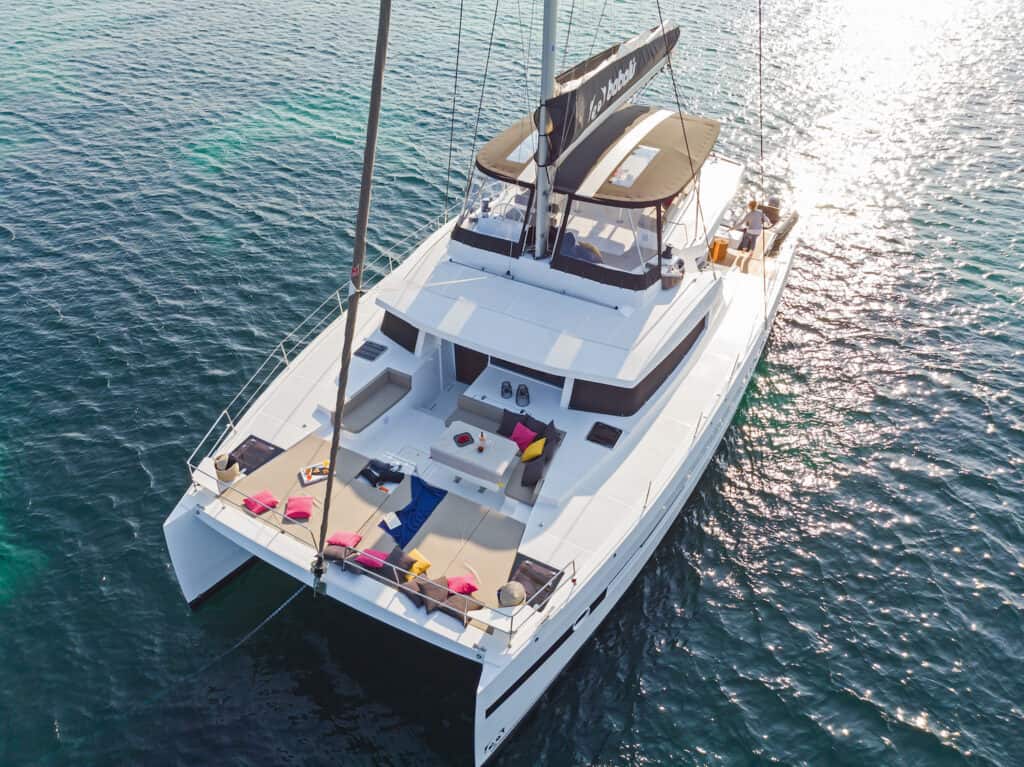
5. Anchor Bridal Setup

Catamarans are fitted with a bridle, attached to both bows and down to the anchor chain, resulting in a very stable position at anchor. What we found with our monohull was that because the bow acts as a sail (because of the high freeboard), the boat tended to sail at anchor in high winds. It sailed in one direction until the chain snatched and tacked over and sailed in the other direction, feeling like it might dislodge the anchor altogether. The catamaran on the other hand sits at anchor a lot more stable and doesn’t sail around as much.
6. Ease of Boarding on a Catamaran
Thank goodness we were much younger and more agile during our monohull days. Royal Salute and most monohulls of her generation or older, have high free-boards, making it quite a feat to get onto the boat from the dinghy. It was one of the most challenging things to do because unlike the more modern monohulls that have a scoop at the back, we had to climb up on the side of the boat to get on and off. We, of course rigged steps, etc. but it was always a hassle compared to the ease of getting on and off a catamaran from a dingy or from the water.
7. Shallow Draft Equals Better Anchorages
Catamarans have significantly shallower drafts than monohulls, allowing for safer anchorages closer to shore. Most catamarans in the 40-ft to 50-ft range draw between 3-ft to 4.5-ft, so they can anchor in places that a monohulls can not even consider. In the shallow waters of the Bahamas for example, the catamarans have a big advantage. We often anchor our own catamaran just a few feet away from a beach. It definitely allows one to be able to explore areas where the water is shallow without the fear of running aground.
The shallow draft also allows for emergency repairs in shallow water and even doing the bottom job when the tide goes out as we have done in places like Mtwapa Creek in Kenya, East Africa. The catamaran easily rests on her keels on the sand without help making it a breeze to do the “annual haul out” even in remote locations.
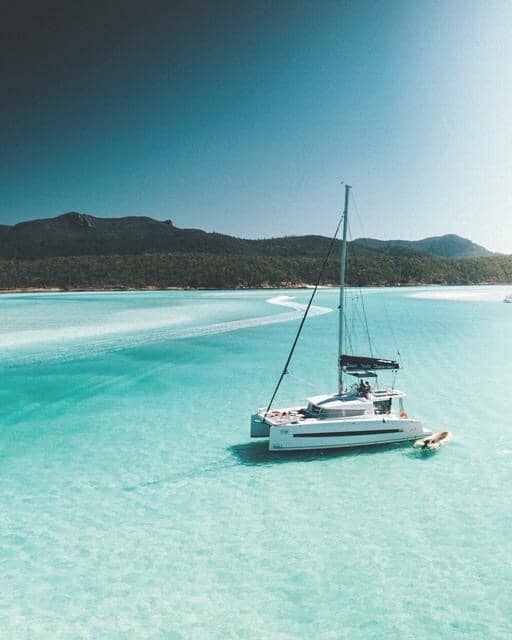
8. Dinghy Davits & Dinghy Size
All catamarans have a set of davits that make it very easy to raise and lower the dingy. Our monohull and most cruising monohulls do not have an efficient or easily accessible set of davits. This makes raising and lowering the dingy an elaborate production. Catamarans on the other hand, has davits systems easily accessible and some even have platforms to rest the dinghy on.
The lack of beam and difficulty of lifting the dinghy also limits the size and type of dingy that one can reasonably carry on a monohull. As we all know, the dingy is your transport to and from shore and diving or fishing spots, so the bigger and faster the dingy, the better off you are. A catamaran can carry both a heavier and bigger dinghy which makes the popular center consul dinghy so much more possible.

9. Interior Space and Comfort on a Catamaran
We sailed 32,000 NM on our 45-ft monohull, happy as clams, not realizing that sailing does not have to be done lying on your ear 24/7 while on passage or sitting knee-to-knee in the cockpit at anchor with your two other guests at the dinner table! One can liken sitting in a monohull cockpit to sitting in an empty Jacuzzi, you are always nice and close to the other folks.
Now that we are on our fourth catamaran, there are a few things that have become more evident to us than the incredible space and comfort of a catamaran, not only at anchor but also underway. The cockpit and living space in general are huge compared to a monohull, making for very comfortable and spacious living conditions. It feels more like you are at home, rather than just on a camping trip.
Knowing that one spends at least 90% of one’s cruising life at anchor, it’s important to have good open living space, which most modern cats nowadays offer. A lot of cats have walk around beds, lots of storage, every modern appliance including washer/dryer, etc. However, one has to fight the urge to fill the space if you want to keep the cat light and fast.

Sailing with guests onboard for extended periods of time, in close quarters can become claustrophobic but on a catamaran people are spread out and separated. With guests sleeping in one hull and the owners in another, catamarans offer much more privacy and separation. Some cats even have privacy doors that will close off the entire hull and has a separate entrance onto the deck, which really separates you from the guests completely.
There is very little heeling on a catamaran, so there is no need for hand grips and safety harnesses inside the boat. There is nothing better (and safer) than being able to walk from the cockpit into the living room (saloon) on one level or one step down at most. In a monohull, when heeling at a severe angle, you would have to claw your way from the companionway steps down to the living area, while fighting to stay upright, significantly tapping your energy.
Unless you hit extreme conditions, everything stays put on a catamaran reducing the anxiety before doing passages of having to stow and secure everything. This very issue makes a lot of cruisers reluctant to weigh anchor and explore more often. It is just too much effort to pack away all your stuff once comfortable in an anchorage!
One thing you will notice is that the stove on catamarans are not gimbaled like it is on monohulls and this should tell the story in itself. The stability and comfort on a catamaran is far superior. Cooking is easy and safer. I often open a nice cold beer, put it down to do something and forget about it only to find a warm beer later in the same place I left it. This is not something that happens on a monohull.
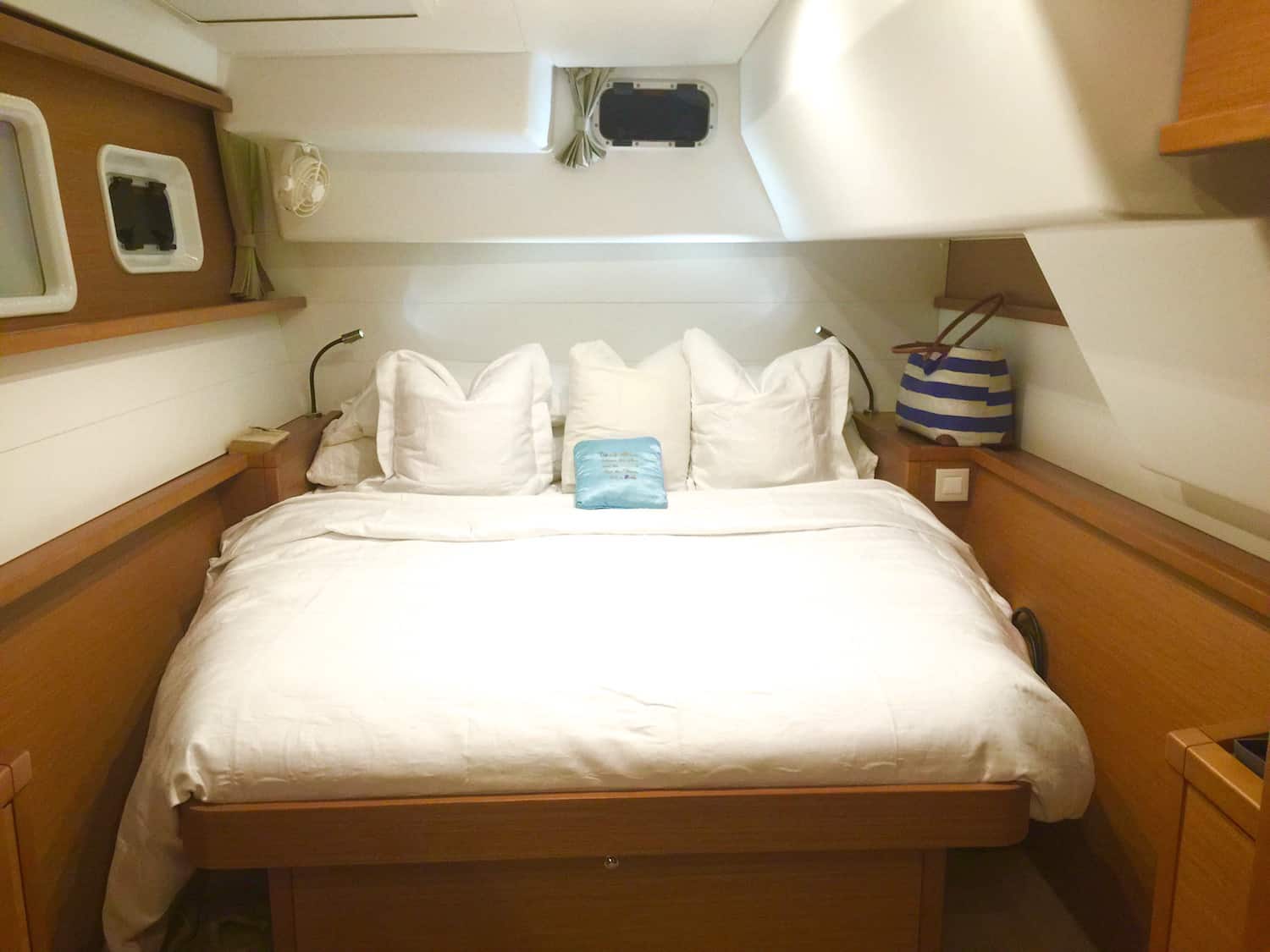
10. Redundancy on a Catamaran
Unlike monohulls, catamarans have a lot of critical redundancies. That of course means two hulls to clean and anti-foul, double the engine maintenance, etc. but having two of the critical equipment like engines for instance, outweighs the downside.
With two engines, if one fails you still have adequate propulsion to go anywhere. If by some fluke the second engine also fails, you have a full set of spares to fix at least one of them. Our friends once hit a sleeping whale off Tanzania, and when it dove, it hit the prop, bending it. They limped into the narrow channel on the one engine but at least they could make it to a safe harbor where we surveyed and repaired their damage.
We often only use one engine when motoring while making passage in order to conserve our fuel. The one engine is totally capable of moving the boat along at a good speed unless you are in heavy seas and you may need more power. Other than that we only use two engines to dock or maneuver the boat in close quarters.
Because there are two engines there are also two independent charging systems via the alternator on each engine. If one alternator goes out, there is still another complete charging system. There are two rudders and if one fails or falls off (as has happened to our friends on a monohull off Columbia, where they almost lost their boat) you have a second rudder that is completely capable of steering the boat by itself indefinitely. That holds true for several things on a catamaran!
11. Maneuverability
The engines are spaced far apart on a catamaran and it makes maneuvering much easier and more precise than monohulls, unless the monohull has a bow thruster. We did not have a bow thruster (not many monohulls do) and had to rely on prop-walk and using prop wash on the rudder. A modern catamaran can do a 360 turn on her own axis. A monohull cannot do this and have a bigger turning circle. However, a monohull under sail is much more maneuverable and certainly will tack a lot faster than a catamaran. The ease in maneuverability under engine on a catamaran in close quarters specifically, is vastly superior comparatively.
12. Rigging
Because of the beam on a catamaran the spinnaker pole has become unnecessary equipment. Hallelujah, I say. That pole on our monohull was a pain the behind and I always hated having to use it. On a catamaran, one can fly an asymmetrical cruising chute or spinnaker, using the bows to tack the clew or run a guy through a block so it is very much simplified, easier and safer.We also sail wing-on-wing with twin headsails when we sail downwind. We use our furling jib and furling Code Zero. It is as easy as one, two, three.
DISADVANTAGES OF A CATAMARAN
1. bridgedeck slamming.
One advantage most monohulls do have when underway is that they don’t slam. Catamarans with a low bridgedeck clearance can experience significant slamming in confused seas sailing upwind. This slamming can be quite disconcerting when you first experience it as we did on a Shuttleworth 44 design, our first ever catamaran experience, 20+ years ago. At times, it felt as though the boat was falling apart. Of course the boat was fine but nevertheless, the stress on the crew from the constant noise and discomfort was significant.
Monohulls don’t have a bridgedeck which means no slamming and are therefore a bit more comfortable than l ow bridgedeck catamarans when beating into severe confused conditions or “washing machine” conditions as we call it. Modern catamarans mostly have better bridgedeck clearance and the slamming is significantly less. However, not all cats have a good clear tunnel under the bridgedeck. Some manufacturers build beds into the bridge deck in order to make more space in the chest of the catamaran where the slamming occurs. These protuberances into the bridgedeck tunnel will likely increase slamming. So be mindful of that when selecting a catamaran. We currently own a Bali 5.4 and the bridgedeck clearance on this boat is more than adequate and the tunnel is clear. We therefor experience very little slamming compared to our Prout 45 that we previously owned (picture of sister ship below) with a much lower bridgedeck.
We Explain Bridgedeck Clearance
In the pictures below, the Bali 5.4 has very good clearance from the water to the bridgedeck and has a nice clean tunnel versus the very low bridgedeck of the Sunreef 50.

2. Sailing Downwind
Monohull spreaders are set at 90 degrees to the mast whereas a catamaran has to have backswept spreaders. The reason is that, on a monohull, there is a backstay and using this, plus the intermediates you can get a nice pre-bend in the mast (the pre-bend is to flatten out the main sail and allow for better performance).
On a catamaran with no back stay, you need to use the back swept spreaders and the diamonds to pre-bend the mast. The reason I point this out is because on a catamaran, if you want to broad reach or run, the mainsail cannot be let out all the way because the backswept spreader tips could punch holes in the fabric.
On a monohull, the spreaders are at 90 degrees so you can let the main and the boom out much further which is, of course, much more effective. This is one of the reasons it is better to broad reach and tack downwind on a catamaran.
Whether a monohull or multihull, sailing dead downwind doesn’t usually make great VMG. Therefor a regular cruising cat, much like a monohull, needs a lot of sail area and has to sail deep downwind if it is to achieve a decent speed made good (VMG). This video demonstrates how we achieve this by sailing wing-on-wing downwind.

It is more difficult to find a dock either as a transient or a permanent slip for a catamaran in general because of the wide beam. But this is changing fast and will soon not be too much of an issue. In the USA dockage is charged by the length of the boat in feet, so there is no disadvantage there but, in some places, (the Mediterranean for example), dockage is charged at length times one and a half because of the additional beam.
Since the catamaran is stable at anchor, we mostly anchor out. We have more privacy, a better breeze and usually a stunning view.We have a nice dinghy with a good outboard engine and is big and comfortable enough to get to shore fast and together with the modern conveniences like the generator, watermaker and washer/dryer, docking becomes a non-issue.
It is definitely more difficult to find a travel lift with enough beam for a catamaran for a haulout, while, for a monohull, there are absolutely no problems anywhere. The wide beam of cats also greatly limits the number of shipyards that can haul them out. Most catamarans over 40-ft must be hauled out with a 50-ton travel lift. This not only increases the cost of the haulout, but greatly limits the choice of the shipyards for repairs and maintenance. With limited choice, prices are high for shipyard services.
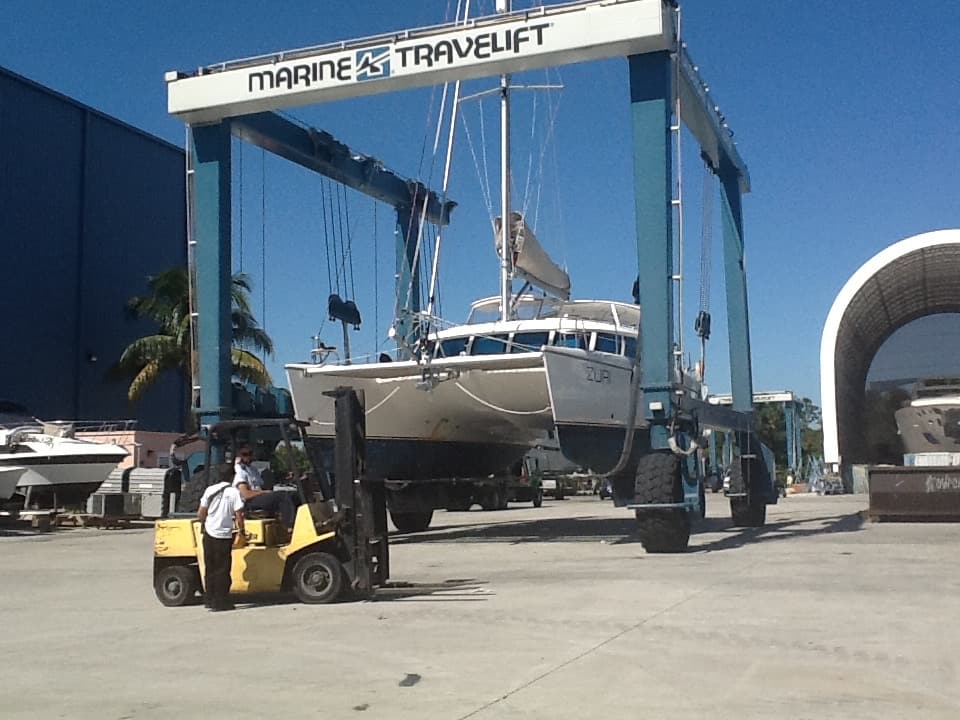
Catamarans do tend to have a lot more windage than monohulls. This can be an issue especially when maneuvering in close quarters with a strong wind. But I have found that, provided the engines are powerful enough for the size of catamaran, that twin engines negate this problem. Also, many modern large catamarans now have a bow thruster fitted. It is super easy to dock.
The cost of getting into a catamaran is much higher than that of monohulls. That could put a serious dent in your cruising kitty or require you to put your dream on hold a little longer. Pre-owned monohulls on the other hand are very cheap to buy comparatively, because the supply presently far outweighs the demand.
Catamarans are in high demand and they typically hold their value much better and longer and the trend is now heavily in favor of the catamaran market. When prospective buyers contact us for catamarans under $250,000 the choices are very limited and catamarans under $100,000 is near impossible to buy. In this case, your best bet is to go with a monohull unless you go with much older boats like the Prouts or the less expensive Geminis.
Our Own Catamarans & Monohulls
FYI: Royal Salute , a Bruce Roberts 45 monohull, was the first boat we owned and sailed approx. 30,000NM on. Mythral, a Seafarer 30, was our “toy boat” while we were waiting for our catamaran to be built. Even though this classic little monohull sailed around the world, it didn’t have much in modern conveniences like running water. Siyaya was an Island Spirit 40 catamaran that we sailed from Cape Town to Florida on and then taught live-aboard sailing classes for several years. Zuri I was a Prout 45, a beautifully crafted catamaran but by today’s standards is considered old technology. Our Lagoon 450 SporTop ( Zuri II ) is a fantastic live-aboard catamaran. We lived and taught aboard her for three years but sold her last year and we currently own a Bali 5.4 ( Zuri III or Z3 as we call her now). Read about our various boats .

CONCLUSION: CATAMARAN vs MONOHULL
We were dyed in the wool monohull sailors for 15+ years. We loved the pretty lines of monohulls, the sailing ability and what we believed at the time to be much safer vessels. However, now that we have been avid catamaran enthusiasts, we simply can never go back to monohulls. Catamarans have come of age and with modern technology have overcome most objections that sailors of old had against them. They are well designed and built, are safe, and we simply love that they sail fast and upright. There is not a whole lot to dislike about a catamaran when you live aboard. We have weighed all the pros and cons of catamarans and found that the pros far exceed the cons. We made the change to a catamaran and do not regret it one bit!
We hope that this article will clear things up for all the prospective catamaran owners out there.
Contact us if you have any questions regarding catamarans, Fractional Yacht Ownership or our Charter Management Programs .
Estelle Cockcroft
Join our community.
Get the latest on catamaran news, sailing events, buying and selling tips, community happenings, webinars & seminars, and much more!
4 thoughts on “Catamaran vs. Monohull: We Changed, Should You?”
I read that the engineering on the catamarans were improved over the years. Whats the oldest year would you recommend designwise?
Scott, my apologies for the late reply. We’ve been traveling in Africa. Anyway, catamarans have come a long way and improvements in technology is happening at lightning speed. I reckon that even the older model catamarans are good. It depends on what your needs are. If you want something a little better performance wise, I would go for something no older than 15 years.
After buying a catamaran what is the difference in expense of a catamaran vs a monohull. Many articles state that not only the initial cost of a catamaran is more it the operating cost as well.
Hi Todd, it is more expensive. The annual dockage and haul out as well as maintenance will be more expensive. You obviously have two engines to maintain and various other pieces of equipment to service in both hulls. While there is more equipment there is also more redundancy and of course you have the comfort factor. So, depending on your situation, it’s probably worth it.
Leave a Comment Cancel Reply
Your email address will not be published. Required fields are marked *
Save my name, email, and website in this browser for the next time I comment.
Recent Posts
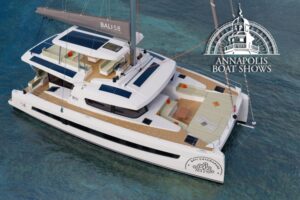
Annapolis Boat Show 2024
Meet with our team! Want to learn more about the Bali and Catana

Exploring the Catana OC 50 Catamaran: A Comprehensive Overview
The Catana OC 50 Catamaran, the latest addition to the Catana Ocean Class series,

Lessons Learned from Selling our Catana 50 OC
Stephen and I are in the process of selling our Catana OC 50 Catamaran.
How is Your Yacht Brokerage Adapting to the Digital Age?
You may have noticed that we have a lot more catamarans for sale in

For more than 30 years, we have been a part of the catamaran community and created Catamaran Guru™ to encourage and educate all the aspiring sailing out there. We understand the dream of traveling the world by catamaran and created a one-stop-shop to make that dream a reality for you.

- Stephen & Estelle
- Testimonials
Get Started
- Yacht Sales
- Used Yachts
- Charter Management
- Boat as Business Programs
- Seminars & Events
- 2024 BOAT BUYERS GUIDE
- Email Newsletters
- Boat of the Year
- 2024 Freshwater Boat and Gear Buyers Guide
- 2024 Boat Buyers Guide
- 2024 Water Sports Boat Buyers Guide
- 2024 Pontoon Boat Buyers Guide
- Cruising Boats
- Pontoon Boats
- Fishing Boats
- Personal Watercraft
- Water Sports
- Boat Walkthroughs
- What To Look For
- Watersports Favorites Spring 2022
- Boating Lab
- Boating Safety

Catamaran Versus V-Hull: Which Rides Better?
- By Kevin Falvey
- Updated: December 2, 2004
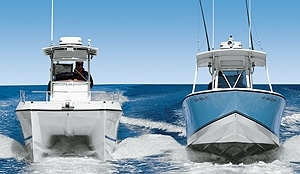
The controversy rages in dockside watering holes, tackle shops, and Internet chat rooms: Which rides better-a catamaran or a V-hull? So far, all the talk has been purely subjective: A cat feels like this, a V-hull feels like that. To us, that’s useless. At Boating Magazine, we need hard numbers, things that we can quantify, then we’ll decide. So we took a Regulator 26, which just might be the best-riding V-hull for its size, and a Glacier Bay 260 Canyon Runner, one of the best-riding cats, and wired them with expensive sensing gear. Rather than a match between two specific boats, it would be a comparison of the finest qualities of each type. We expected the cat to be smoother when the going got rough, but what about the other times? Is it the most comfortable all-around boat? It took us a year-that’s right, one full year-to compile and understand the data, but here, finally, is the answer.
Measured Madness Our first problem was how to quantify a boat’s motion underway. The best tool we came up with is an accelerometer, which records changes and degrees of motion. We also had electronic gear to measure the boats’ angles, WAAS-enabled GPS units, rangefinders to measure distances, four laptops, stopwatches, plumb bobs, measuring tapes, and eventually, a collection of soggy notebooks.
To help us make sense of what we compiled, and back up our conclusions, we enlisted two top naval architects. So we’d like to thank Rick Strand, president of Strand Technologies, a consultant to companies such as Tillotson-Pearson, Boston Whaler, and Brunswick; and John H. Deknatel, president of the legendary design firm C. Raymond Hunt Associates.
With their help, the evidence became clear. What we discovered should silence the know-it-alls and may surprise the enlightened. Without question, we’ve killed the controversy. The boat type with the most comfortable ride is…
Not so fast-to understand our answer, you need to know how we approached the question.
Three Easy Pieces First, we wanted to measure how differently cats and V-hulls turn. To do this, we set up a buoy and had each boat make the tightest 180-degree turn it could at 30 mph. The diameter of each boat’s turn was about the same, although the V-hull averaged 8.4 seconds compared to the cat’s 8.9 seconds. The important difference, however, was how each banked in the turn.
Our electronic angle indicator showed the cat leaning outward by 26 degrees. The unit may have been over-reading due to outward force, but none of the techies from the indicator’s company could confirm this and they therefore stand by its number. By any measure, the cat did lean outward at a steep angle, which can be disconcerting to say the least. Loose gear slides more when a boat leans opposite the turn, and the push that occurs at the apex can make you feel as if you’re going to be thrown out. Of course, with time, you can get used to this. Furthermore, the lean can be minimized by trimming up the outboard engine and trimming down the inboard.
In contrast, the V-hull banked inward by 10 degrees. This not only feels natural, it also has a practical advantage. Centrifugal force pins you and your deck gear into the boat, and you need no special trimming techniques-just turn the wheel.
Both boats are designed for fishing, so our second test was to see how each fared while drifting.
To start, we measured each boat’s roll period-how long it takes to roll all the way to one side and back again. Too short a roll period foretells a jerky motion at sea, too long may mean there’s not enough initial stability. The cat’s period was 2.2 seconds. The V-hull’s was 2.4 seconds, almost 10 percent slower-which in this case is good.
Given our experience with a cat’s less-than-gentle motion at drift, we expected its period to be a lot shorter than the V-hull’s. In hopes of explaining this, we headed out into the ocean.
After the two boats took their natural drift angle in four-foot waves, we looked at the mean G forces each experienced. The cat showed 0.92 Gs, and the V-hull showed 1.18 Gs. So the cat is more comfortable, right?
Not quite. On average, it took the cat 1.15 seconds to reach those Gs, whereas it took the V-hull a little longer at 1.17 seconds. That is, the V-hull accelerated 2 percent slower than the cat. And, as we’ll get into later, slower accelerations equal more comfort.
The results from the accelerometer confirm our roll period tests. The cat, with its greater initial stability, resists rolling. When you stand on its rail at the dock, you notice it hardly leans at all. Most folks think this stability makes for a better boat offshore. But that same resistance to listing at the dock causes a cat to follow the contour of the waves while drifting. The steeper the wave face, the more the cat leans over.
The V-hull has less initial stability, so it gives a bit to your weight at the dock-and to oncoming waves. Its ability to roll easier means it’s not forced to follow the contour of the wave. Instead, as a wave approaches, the boat leans toward it, levels out at the crest, and then leans back into the retreating wave on the way down. In this way, it’s trying to remain level, rather than trying to conform to the angle of the water it’s floating in.
Our third test was to see how smooth each boat ran on a “perfect” boating day, one with a small one-to-two-foot chop on an open bay and a 10-mph breeze. We ran the boats side by side, and the differences shown on the accelerometer were negligible.
So far, after three tests, the V-hull had come out on top in two, and both boats were about equal in one.
We Take It Outside “But what about how they ride when it’s rough?” we hear you ask. “That’s what we really want to know.” And we plan to tell you. But our contention is that there’s more to boating-and enjoying it-than this one element. Unfortunately, and unfairly, bar talk often centers around this, so here we go.
We chose a day when the waves were four to five feet with a six-second period-your typical “rough day.” We ran the boats 100 feet apart at 29 mph directly into the waves. It didn’t matter which boat we were in, it was uncomfortable. Anyone but a masochist would slow down or change course, but we’re here for science.
The graphs on page 86 (see “Graphic Violence”) represent the two boats hitting the same wave. Sharp readers will note that the impacts shown for the two do not exactly coincide. The time each boat hits a wave varies, and a given wave isn’t consistent in shape over its length. Since the boats couldn’t be tied abreast of each other, this is the best anyone can do.
We made numerous runs. For statistical accuracy, we examined seven individual waves for each boat and on each run.
Before giving you the numbers, let’s just say that our accelerometer numbers are dead accurate. But on test day the time between entering a wave, bottoming out, and leaving the wave occurred in less than 0.3 seconds-which is not uncommon. According to Deknatel, “That’s too short a time for your body and brain to process the full effect of the event.” The accelerometer, however, is capable of measuring what we can’t feel.
To accurately compare the ride for a real human, not the machine, you need to look at more than just the peaks of the graph (maximum G force). You need to look at the steepness of the graph’s slope (the time it takes to reach that force), too. A boat that develops more Gs doesn’t necessarily mean it has a harsher ride. It depends on how fast that force is applied. For example, if your 250-pound buddy gently leans on you, what you feel is different than if he were to hit you with a running tackle.
The curve for the cat peaks at 3 Gs; the V-hull, on the other hand, peaks at 4, meaning the cat has 25 percent less gravitational force.
We can also see that the cat consistently decelerated slower when it hit the wave than the V-hull did. It had an average deceleration of 0.287 seconds, compared to the V-hull’s 0.081 seconds-which is 3.5 times faster.
The cat not only landed with less force, it decelerated slower as well. The two combined say it has the more comfortable head-sea ride.
Our test day was rough, so much so that our testers were hard-pressed to say from their gut which rode softer. But, again, the machine is more sensitive than any human, and numbers don’t lie: The cat’s numbers were clearly better.
Later tests also showed the cat delivered lower Gs and slower decelerations while running downsea, in quartering seas, and in the trough. So it’s the most comfortable boat right? Well, not so fast.
Rough Guide We weren’t through testing yet-although some tests were hardly high science.
For example, to see how wet riding each hull was, we taped paper towels to the front of the console. Cats often “sneeze,” or throw a fine mist on certain headings. In this case, and even in the test day’s rough conditions, both sets of towels came back dry.
Then there were issues we couldn’t quantify, such as how a V-hull can dig in its bow going downsea to occasionally make steering difficult, or how in quartering seas a cat’s two hulls catch at different times, requiring constant small steering adjustments.
And there were things that we didn’t have time to test, such as the effect of weight. Typically, a V-hull rides better as it gets loaded down with gear and fuel, which is just the opposite of a cat. Also, our offshore tests were on closely spaced waves. On widely spaced rollers, where boats become airborne, the results would have been different.
In the end, for many boaters, especially those who seem to spend more time in gin mills and chat rooms than on the water, ride quality simply means how softly a boat handles head seas. By that standard, as measured by our accelerometers, and in our test conditions, the cat was the clear winner.
But ask yourself, how often do you go out in weather like that? To make the results of our tests worthwhile for you, ask yourself, “Which boat rides better in the conditions I expect to meet?”
For example, if you have to run far and fast to get to an offshore fishing ground, the cat is a better choice. If you fish close to home, and drift or troll more than flat-out running, the V-hull would be better.
Take all our tests into consideration, and the boat you buy will be the right boat-your Mr. Smoothie.
- More: Boats , express fishing , Fishing Boats , glacier bay catamarans , multipurpose , versus

Boat Test: 2024 Viaggio Lago V 16U

Boat Test: 2024 Sea Pro 292DLX Offshore

Boat Test: 2024 Parker Offshore 2900 CC

Boat Test: 2024 Bass Cat Jaguar STS

Suzuki Marine Initiates Sustainable, Ethanol-Free Marine Fuels Plan in Florida
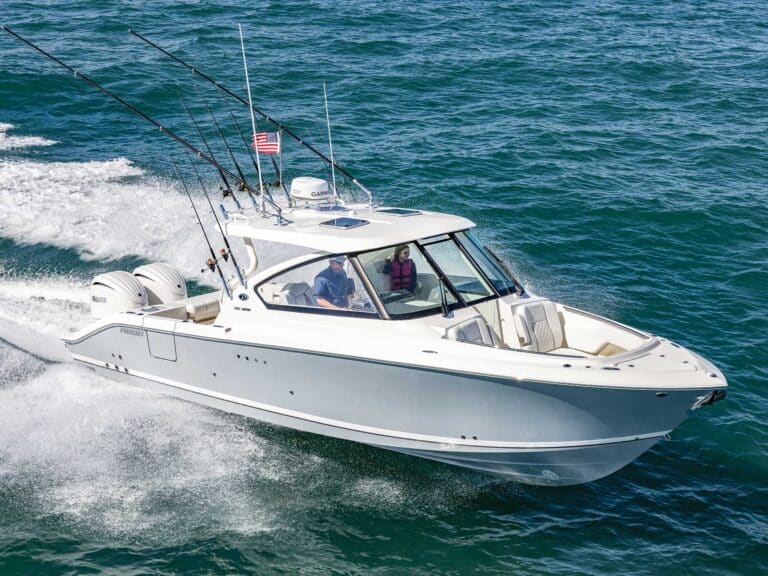
Boat Test: 2024 Pursuit DC 306

- Digital Edition
- Customer Service
- Privacy Policy
- Cruising World
- Sailing World
- Salt Water Sportsman
- Sport Fishing
- Wakeboarding
Many products featured on this site were editorially chosen. Boating may receive financial compensation for products purchased through this site.
Copyright © 2024 Boating Firecrown . All rights reserved. Reproduction in whole or in part without permission is prohibited.

Trimaran VS Catamaran – Which Boat Is Best?
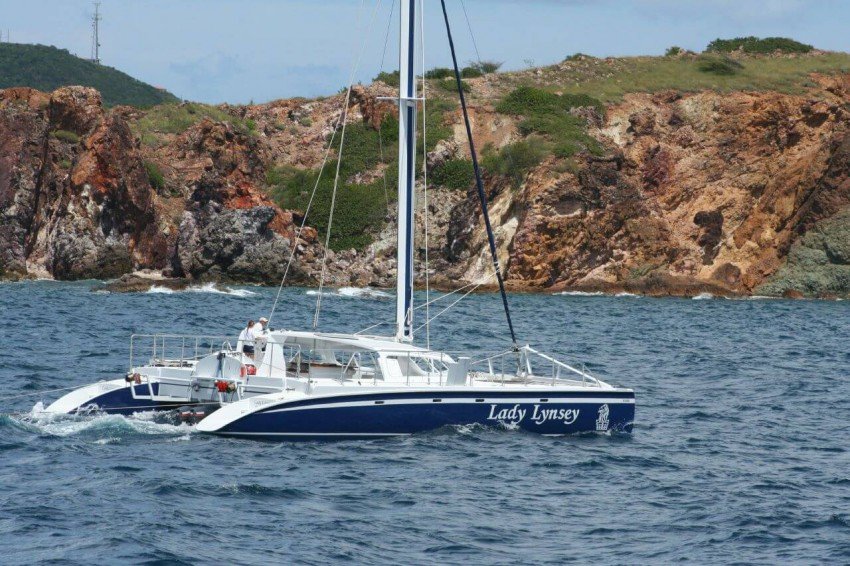
If you’re planning to buy or charter a multihull boat, you might be wondering which one is better: trimaran or catamaran. Both have their pros and cons, and the decision ultimately depends on your needs and preferences. In this article, I’ll explain the differences between these two types of vessels to help you make the best choice for your needs.
Post updated: 10 November 2023
Table of Contents
Our Motor Yachts
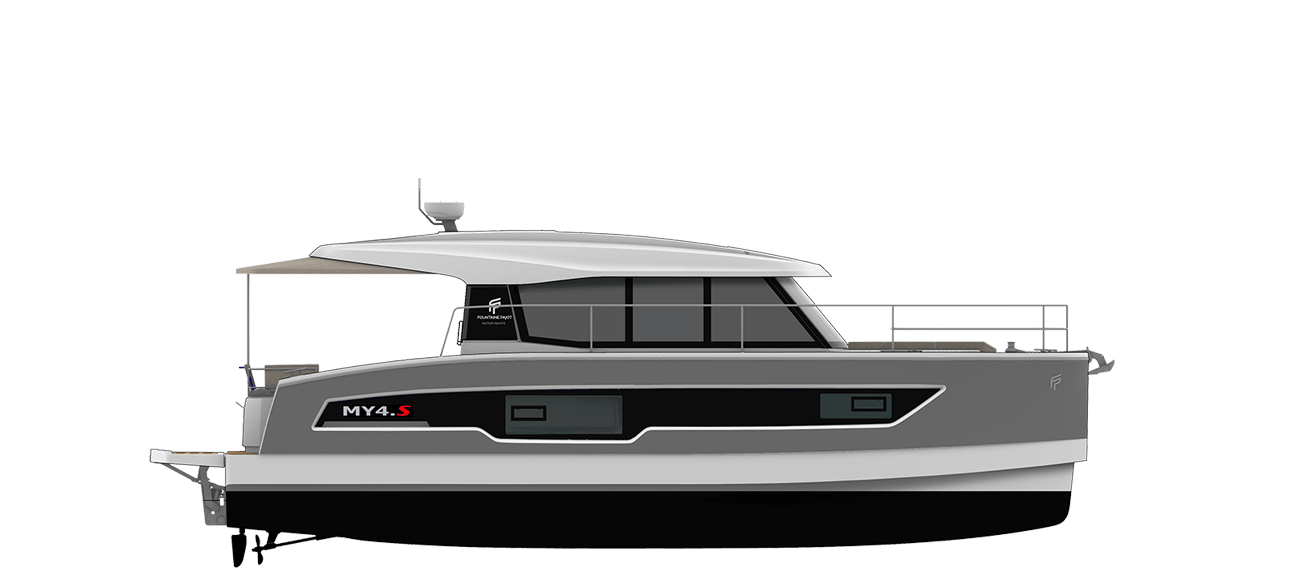
Motor Yacht
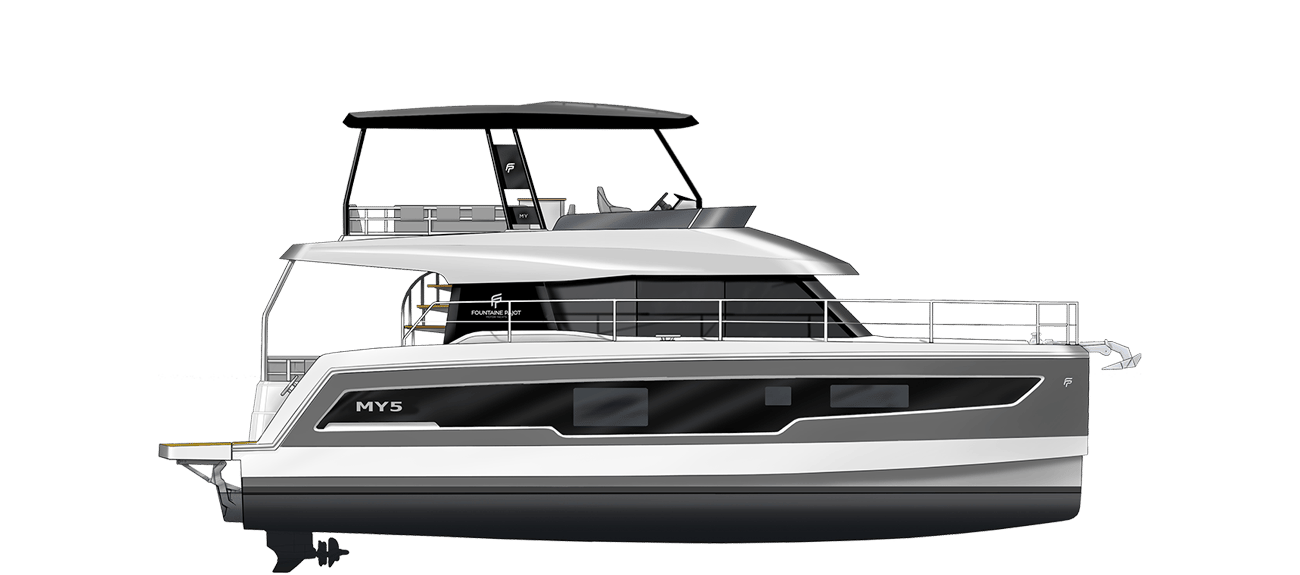
Explore our models in a different way thanks to the virtual marina
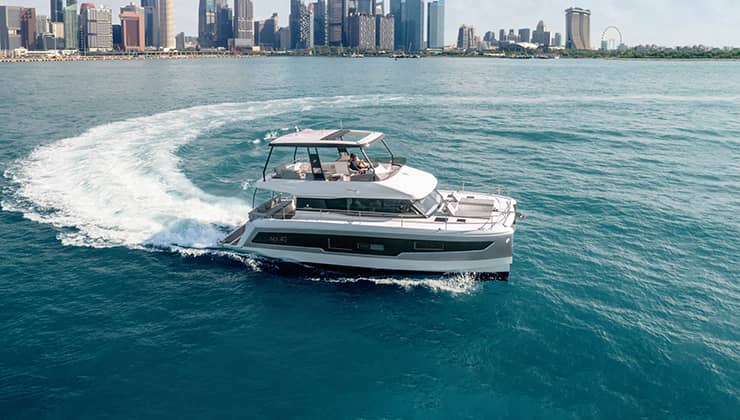
The concept
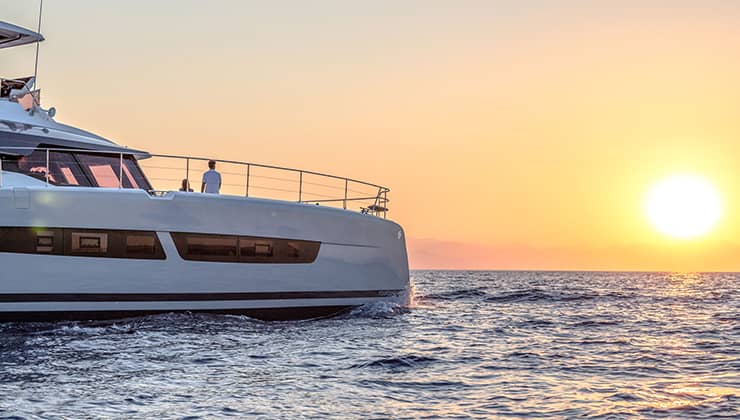
The Motor Yacht experience
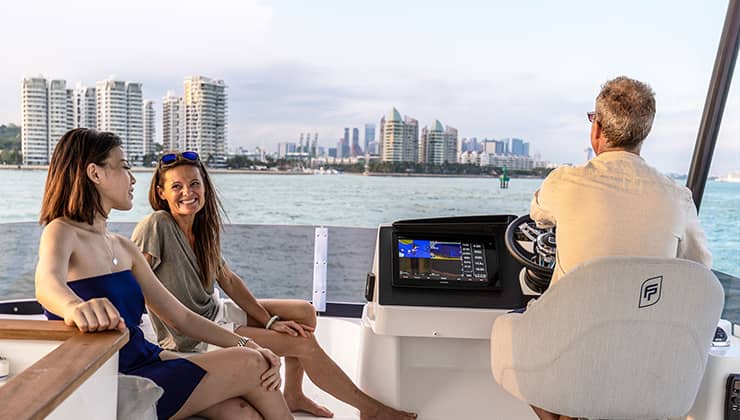
Enjoyment at sea
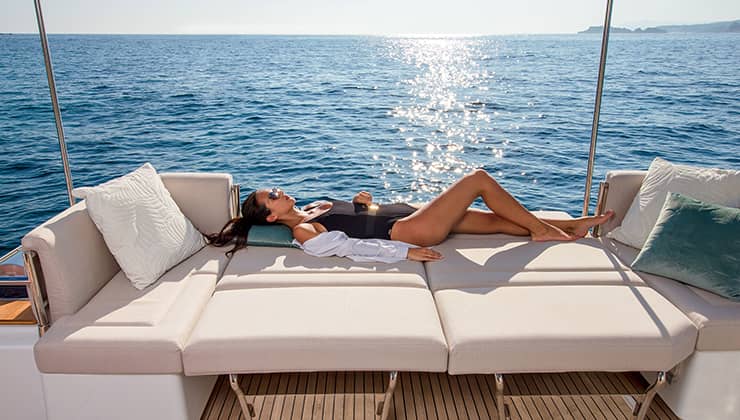
Living Onboard
Experiences
- Virtual marina
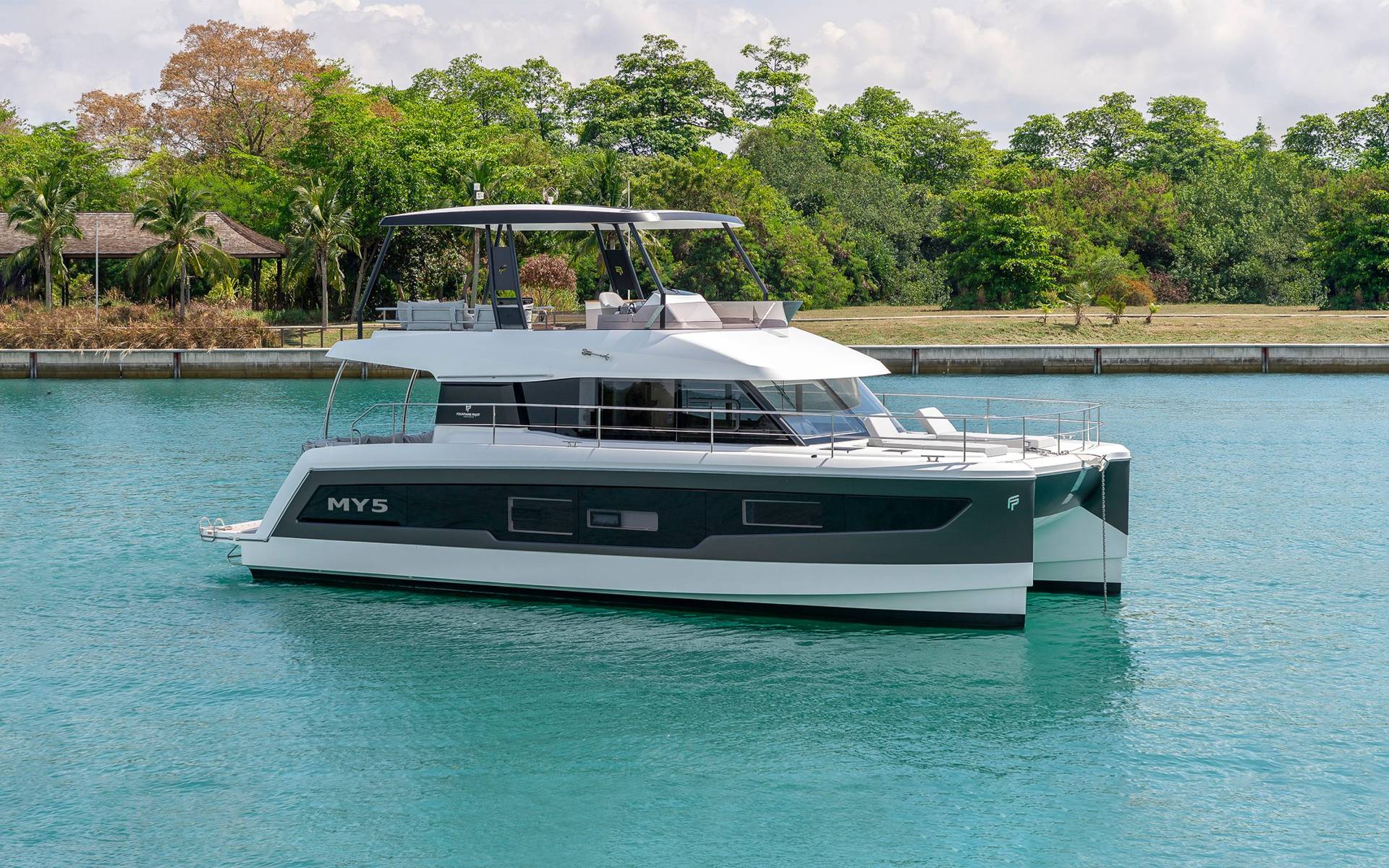
- Motor catamarans range
Motor Yacht MY.5
A power catamaran with flybridge
Length overall
Beam overall
Standard Power
Option Power
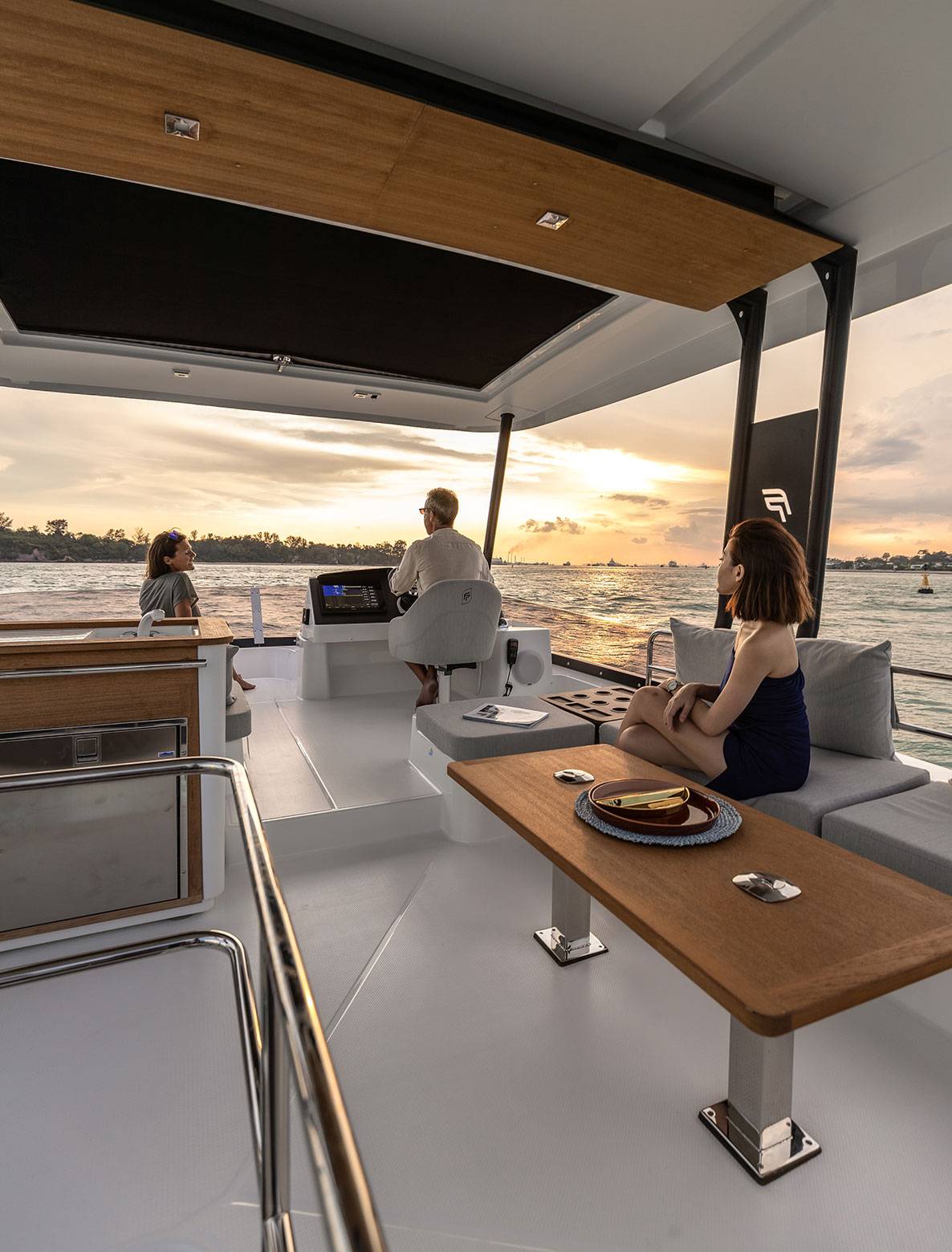
The modular sunbathing areas on the foredeck are the ideal space for unwinding. Just the ticket for an unforgettable holiday on the water.
The MY.5 catamaran motor yacht invites you to take to the open seas
Steering from the flybridge means you enjoy an exhilarating experience with excellent visibility.
Her specially designed hulls deliver confidence at sea, and her Volve IPS engines and onboard technology ensure she can be comfortably handled in all sailing conditions. Sophisticated systems reduce fuel consumption delivering long cruising range . The flybridge provides additional space where you can spend time together both at sea and at anchor.
Motor Yacht MY.5 in video
Discover the MY.5
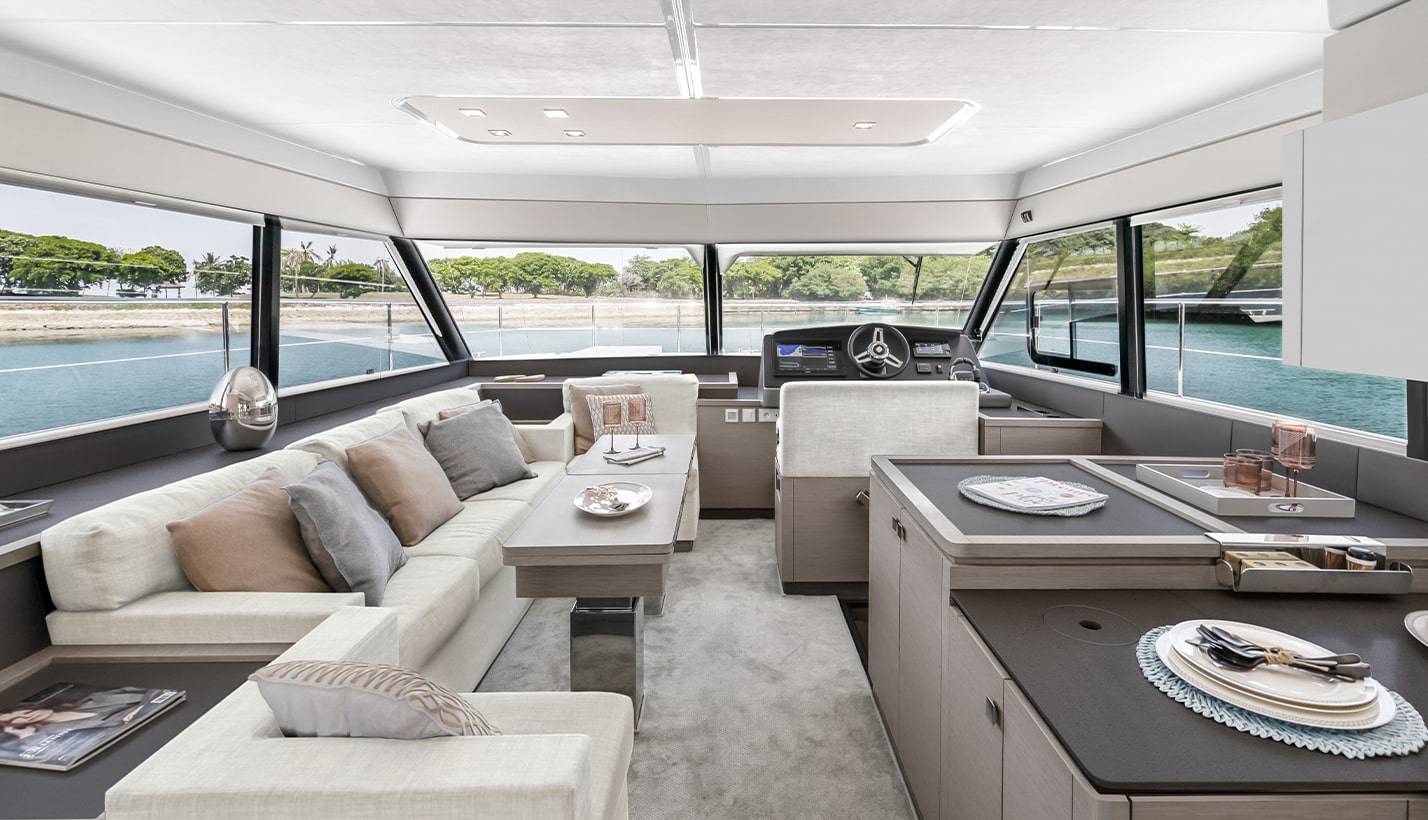
Volume for total comfort
The interior of the MY.5, designed by Andreani Design, offers all the luxury you would expect from this motor yacht . The layout, divided into three cabins, provides an abundance of living and storage space. The central galley serves the aft cockpit or saloon, so you can always enjoy your dining experience, whatever the weather.
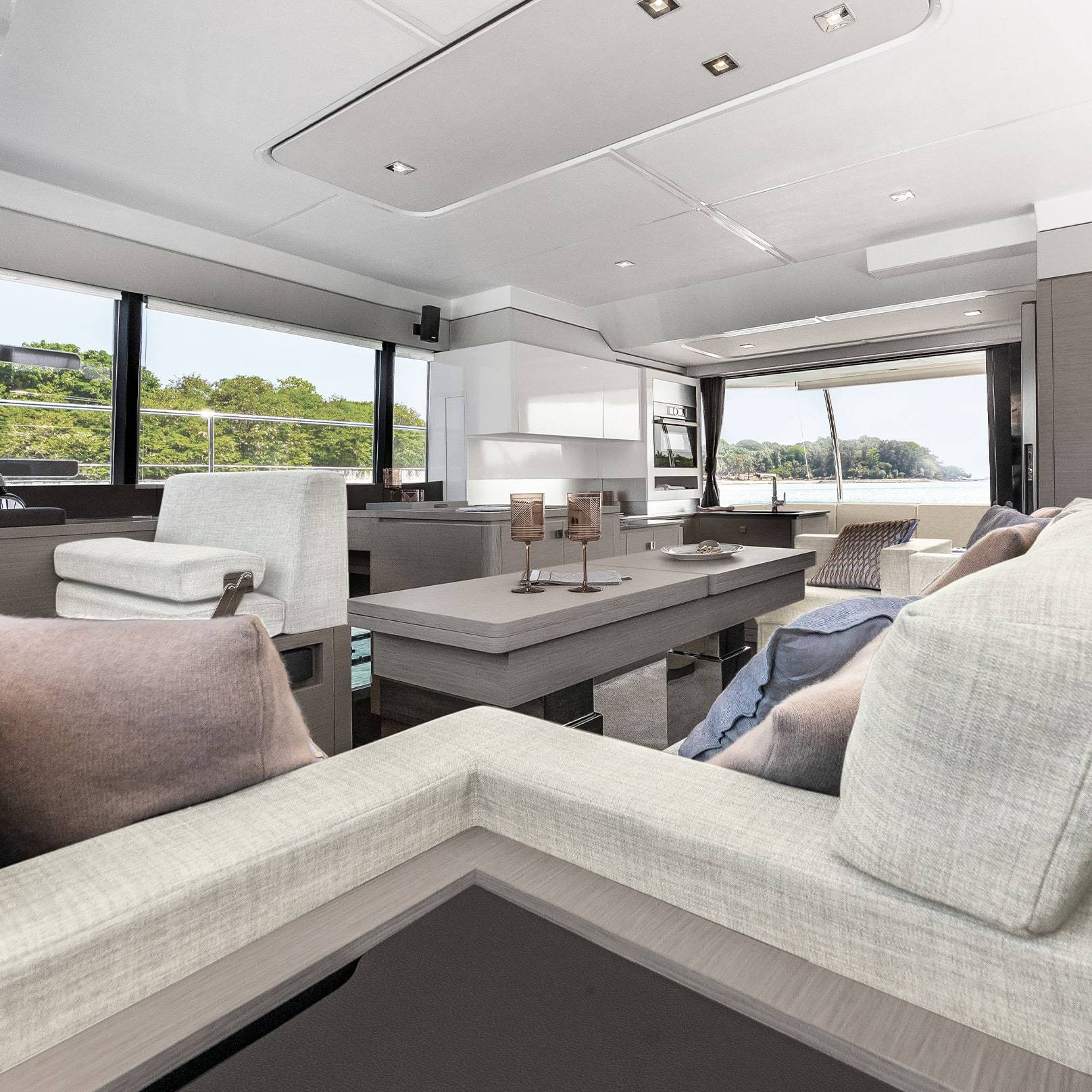
Features Motor Yacht MY.5
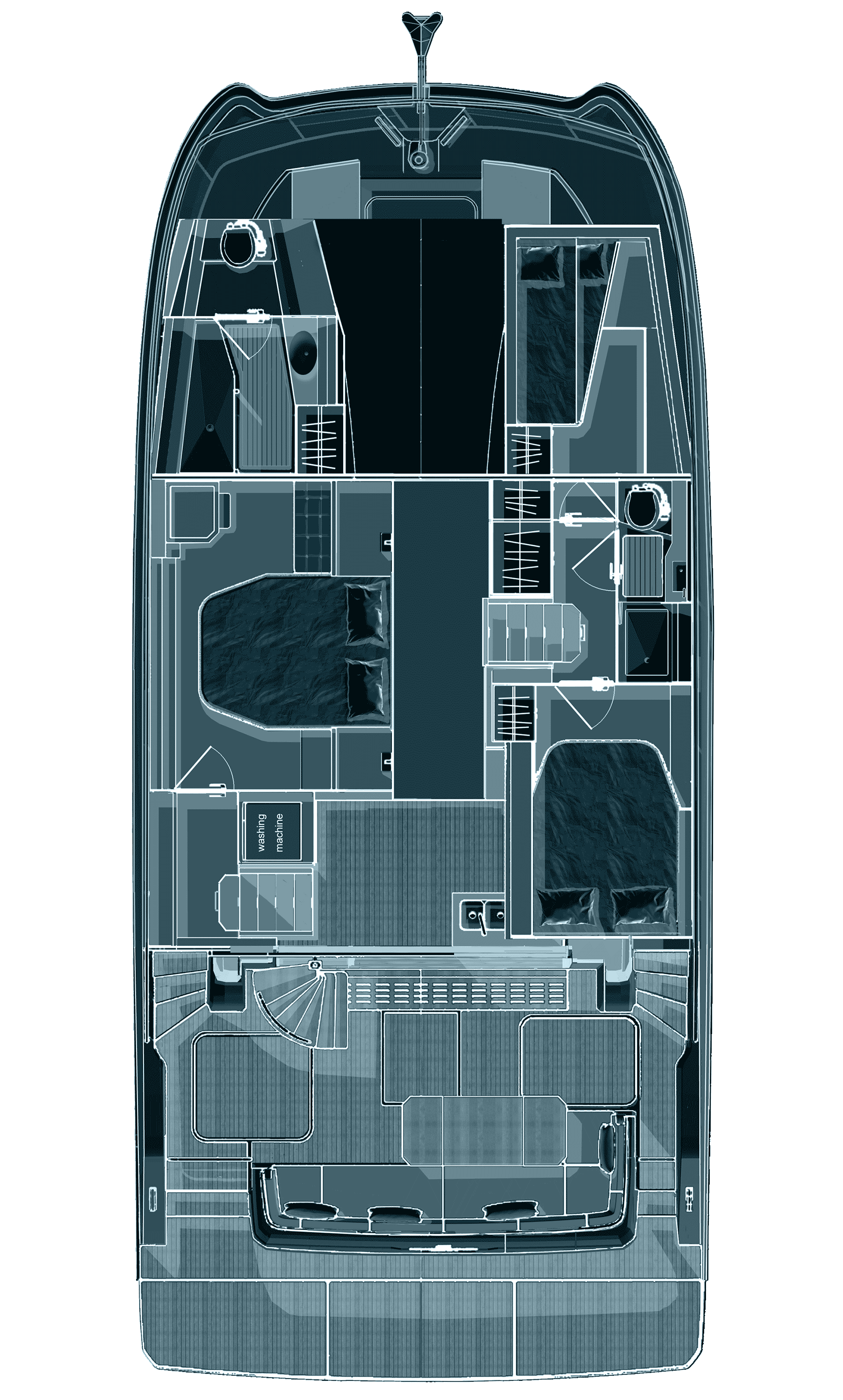
Version Maestro
1 owner’s suite + 1 bathroom / 2 double cabins + 1 bathroom
Displacement unloaded
Full load displacement
23.0 T(Approx.)
Fresh water tank
119 Gallons
Diesel tank
2 x 186 Gallons
Up to 231 NM
Daniel Andrieu
Andreani Design
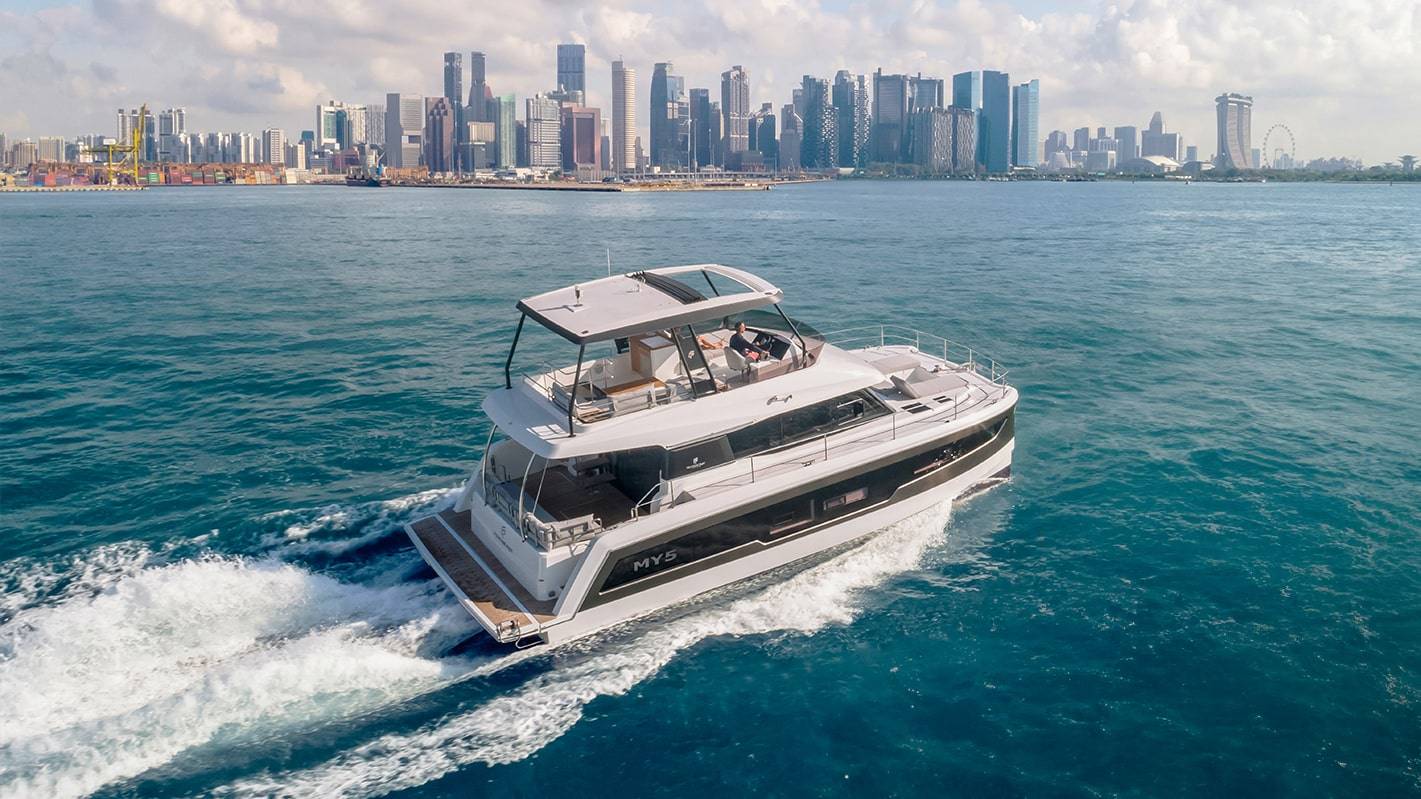
It’s easy to enjoy the sea with a swim platform that lowers to water level. With three luxurious double cabins , available in a range of layouts, all the attributes of a Motor Yacht are combined in less than thirteen metres.
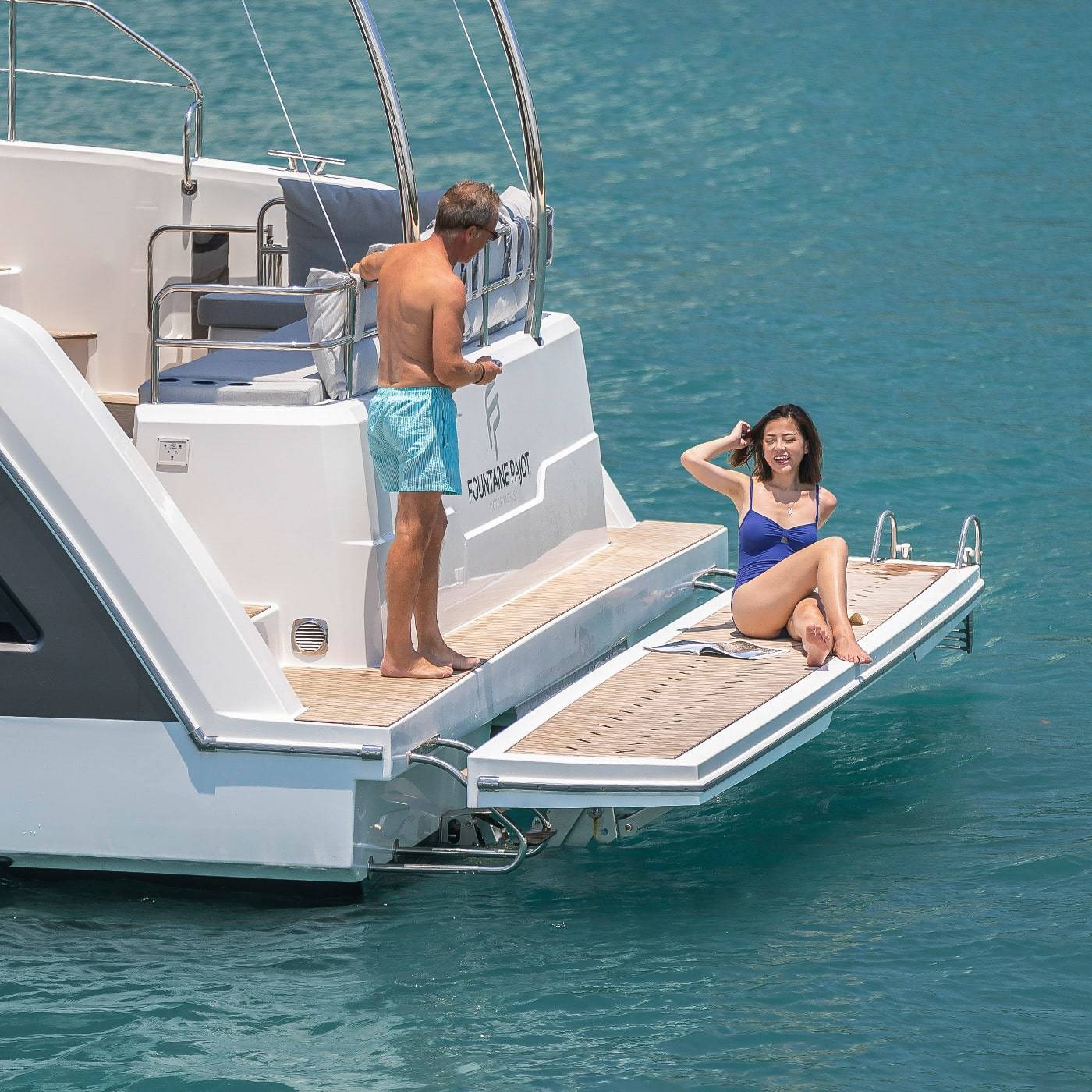
Indoor & outdoor areas
Unique design and incomparable spaces.
The dedicated companionway to the Owner’s cabin enhances the feeling of privacy. Her transverse queen-size bed enjoys sea views and the large portholes bathe this suite in natural light from morning to night. One of the double cabins is fitted with bunk beds that configures to adapt to any situation.
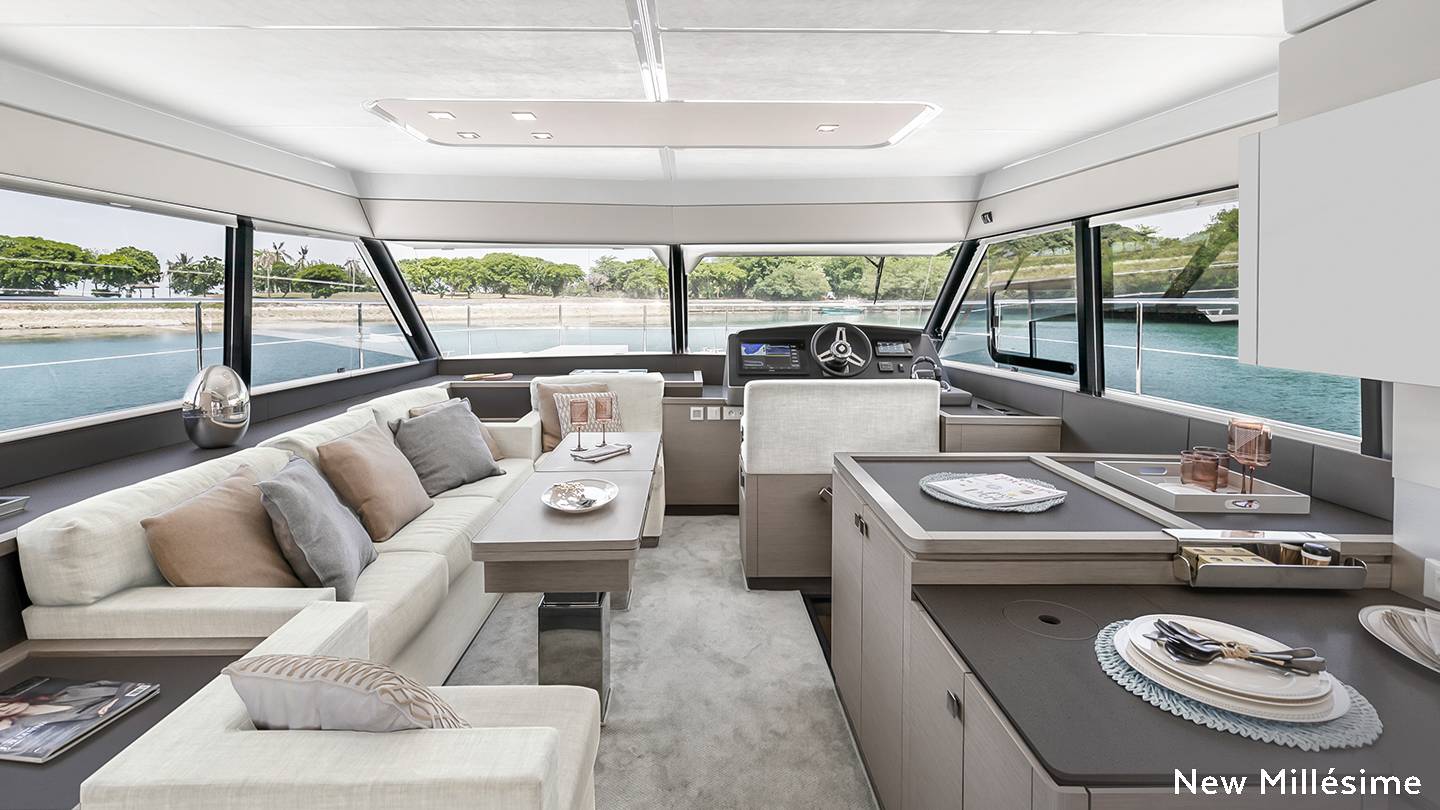
Virtual visit
As if you were there….
Welcome aboard this exceptional yacht for a 100% immersive visit. Explore her interior and exterior living spaces in minute detail!
- Technology & Navigation
- Construction & Design
Waiting times for a Fountaine Pajot motor yacht may vary according to the stage of your project, the model you want or your navigation area. Some Fountaine Pajot dealers have new motor catamarans ready to sail ! Contact your nearest dealer HERE to ask about the availability of the boat of your dreams!
Visit your nearest Fountaine Pajot boat dealer to buy a new motor yacht from our range. You will benefit from personalised advice through the Fountaine Pajot dealer network. Discover our network HERE
The price of a Fountaine Pajot power catamaran varies according to the size of the model chosen and your cruising project. Our dealers are at your disposal to guide you in your choice of fittings, packages and options to best suit your boat purchase project. You can find out the starting price of the boat your choice on this page HERE .
IPS engines, fitted on some Fountaine Pajot motor catamarans are designed to offer greater energy efficiency, which translates into better fuel economy compared to other systems of propulsion. The overall design of IPS engines aims to optimise a boat’s performance in terms of speed , manoeuvrability and fuel economy. And of course, IPS engines offer excellent manoeuvrability thanks to steerable propellors, thus facilitating manœuvres in tight spaces like harbours.
Spacious and comfortable when sailing, Fountaine Pajot motor yachts also offer fine cruising speed. Depending on the model and the engine installed on board, they can reach a max speed of 24 knots and 18 knots in fast cruising mode.
Power catamarans are naturally more efficient than monohull power boats . Depending on the model and the engine installed on board, at a high cruising speed, i.e. around 18 knots, motor yachts in the Fountaine Pajot range can reach between 260 and 425 nautical miles. At an “economical” cruising speed, they can reach up to 1000 nautical miles. The Power 67, the Flagship model in the range, can reach up to 4000 nautical miles at economy cruise speed. Take a look at the boat comparator here
Thanks to its architecture with two floats and a central suspended platform, its mass is divided by two and better spread. Thinner hulls decrease the Archimedes thrust and require much less energy to move the keel through the water. Half the consumption of a monocoque is the result, increasing the range of motor catamarans for long crossings and long stays at anchor. For the same length, a catamaran gives much more living surface . The great width permits much more spacious cockpit space as well as a huge interior-exterior living space on one level,
Innovative, high-tech composite materials constitute most of the structure of our motor catamarans : hulls, flybridge, decks, bulkheads and more. Fountaine Pajot has perfected a resin injection and infusion technique, an advanced technology that gives our boats all their robustness. Thanks to this expertise, we can make our motor yachts considerably lighter while maintaining consistent quality . Injection also makes it possible to meet the most stringent environmental requirements, in line with the commitments of the Fountaine Pajot Group.
13-meter motorboat
Interested in this model?
Your local dealer will be happy to advise you and give you more details about this model!
A voyage into the Motor Yacht world of Fountaine Pajot
Dive deep into the Fountaine Pajot experience through testimonials, news, webcasts, podcasts, press reviews, photo and video reports... Together, let’s redefine the parameters of Motor Yacht cruising!
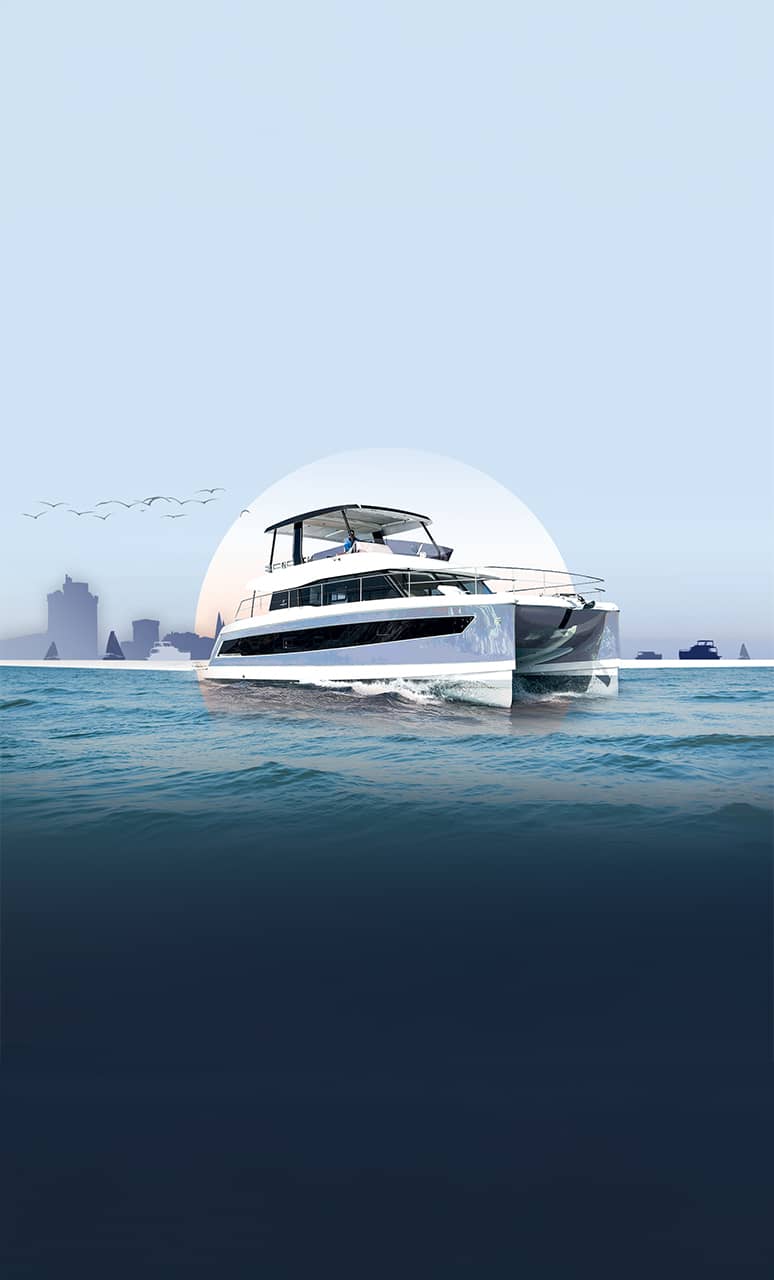
10 Jun 2024
A private Motor Yachts boat show in La Rochelle
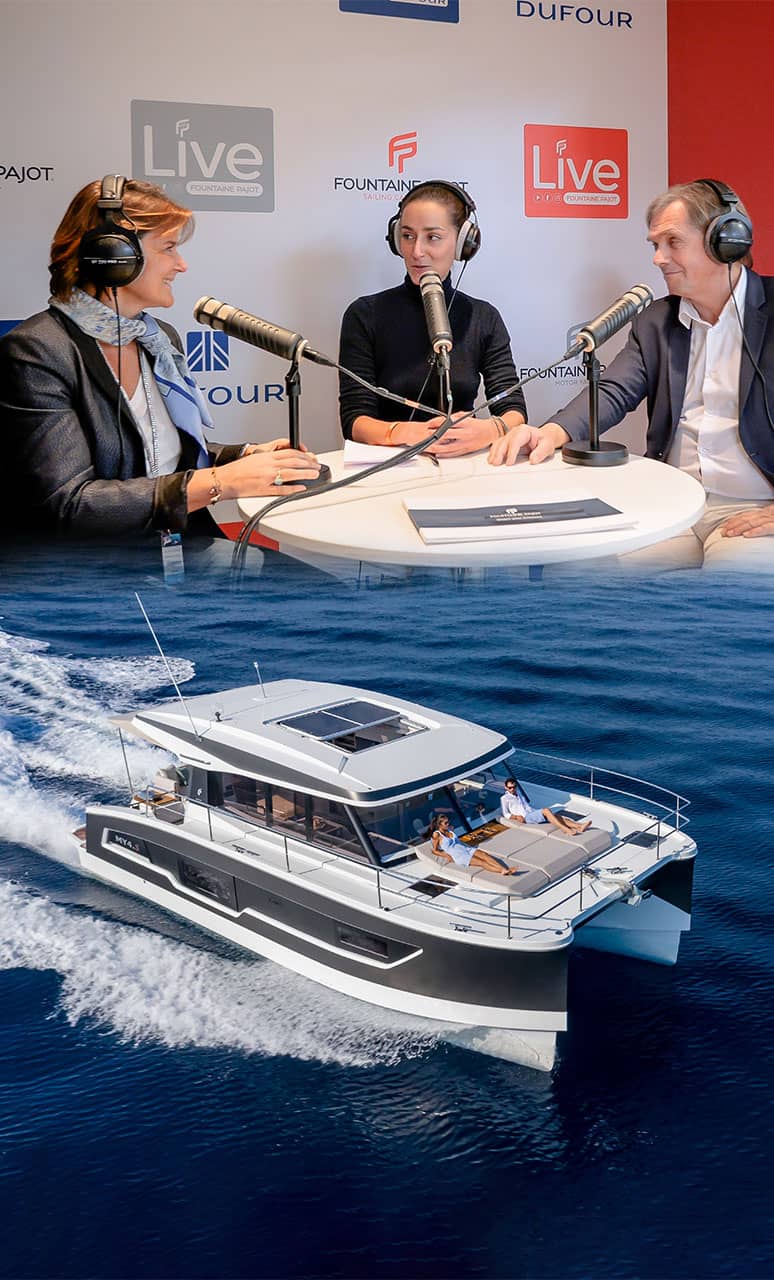
MY4.S, a motor yacht at the top of navigation and comfort?
All about the new Fountaine Pajot Motor Yachts with Stéphanie de Loustal.
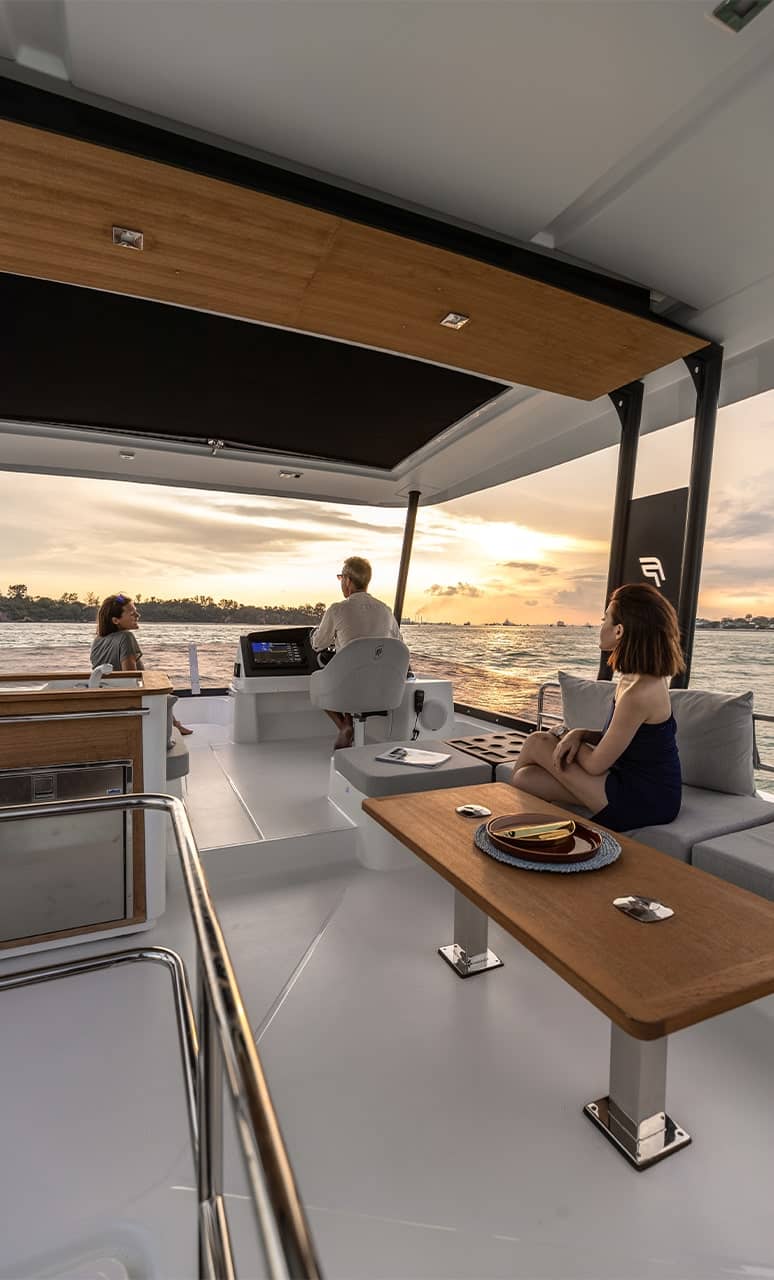
18 Mar 2024
A Motor Yacht in harmony with the sea
Fountaine Pajot Owners Rendez-vous 2016
For its 40th anniversary, Fountaine Pajot met up with owners of Sailing Catamarans and Motor Yachts to mark this special occasion.
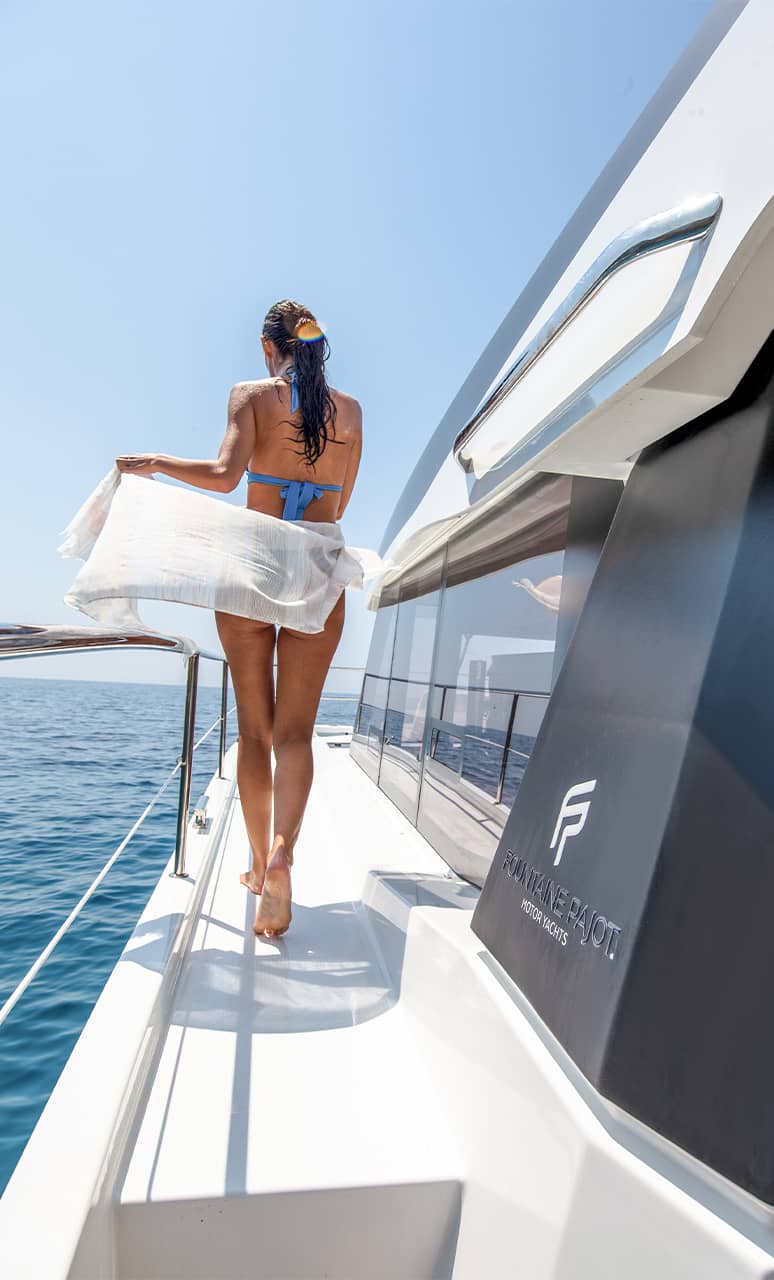
20 Feb 2024
A new way to experience Motor Yachts
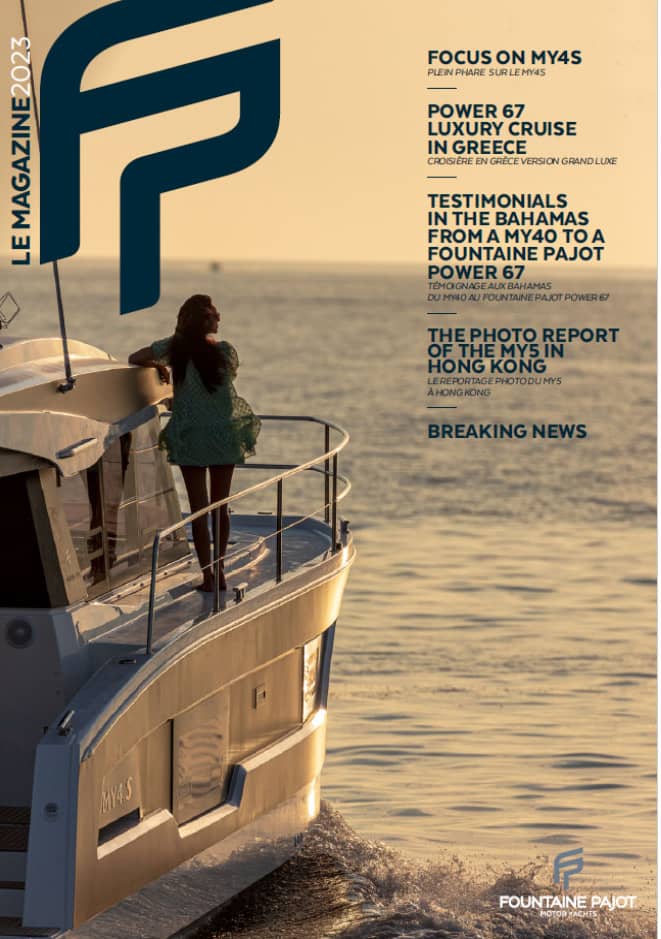
2023 magazine
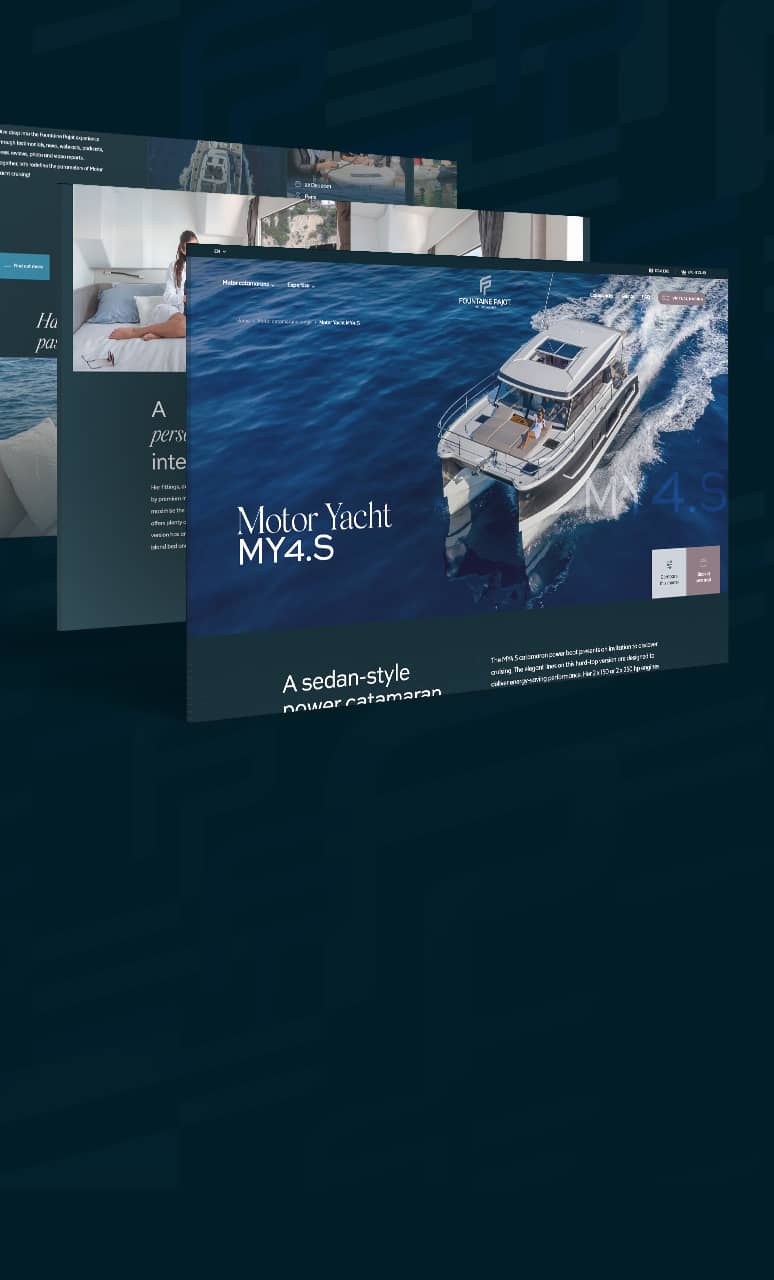
25 Jan 2024
Welcome to the new Fountaine Pajot sites! A brand-new experience…
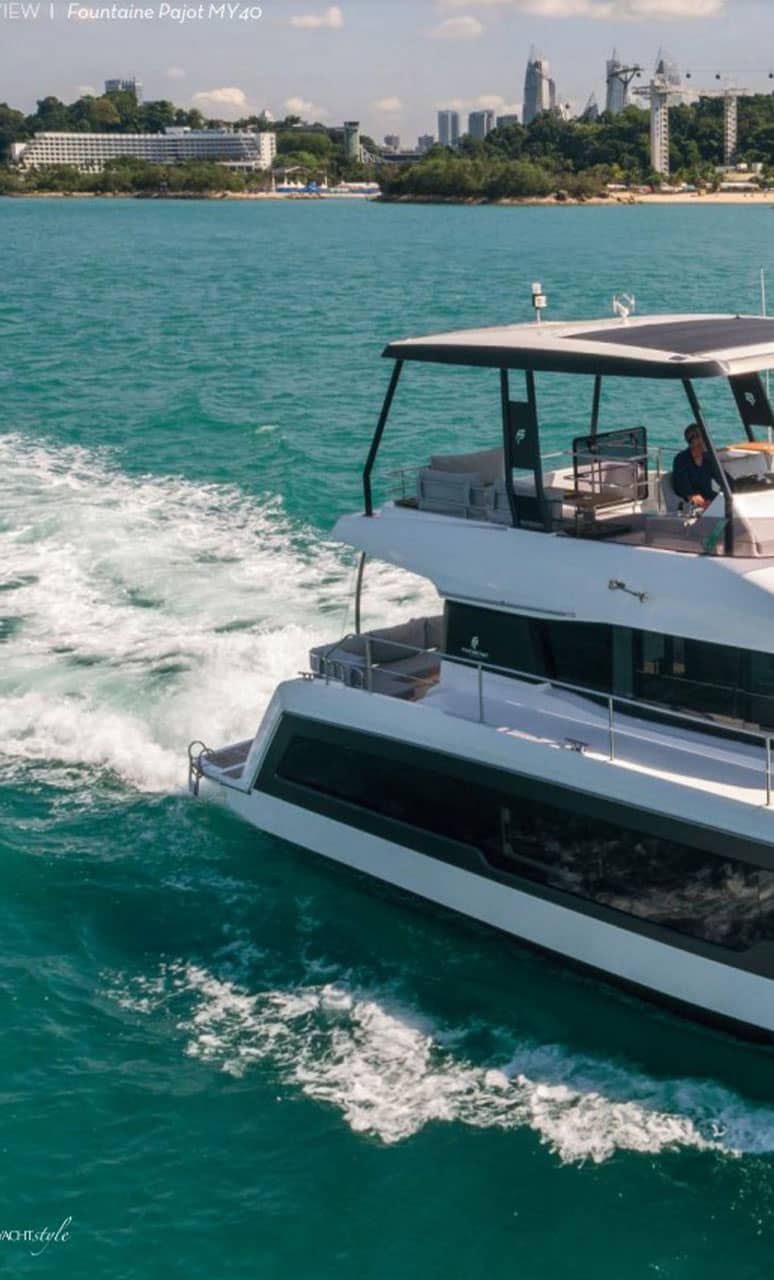
Yacht Style – MY5
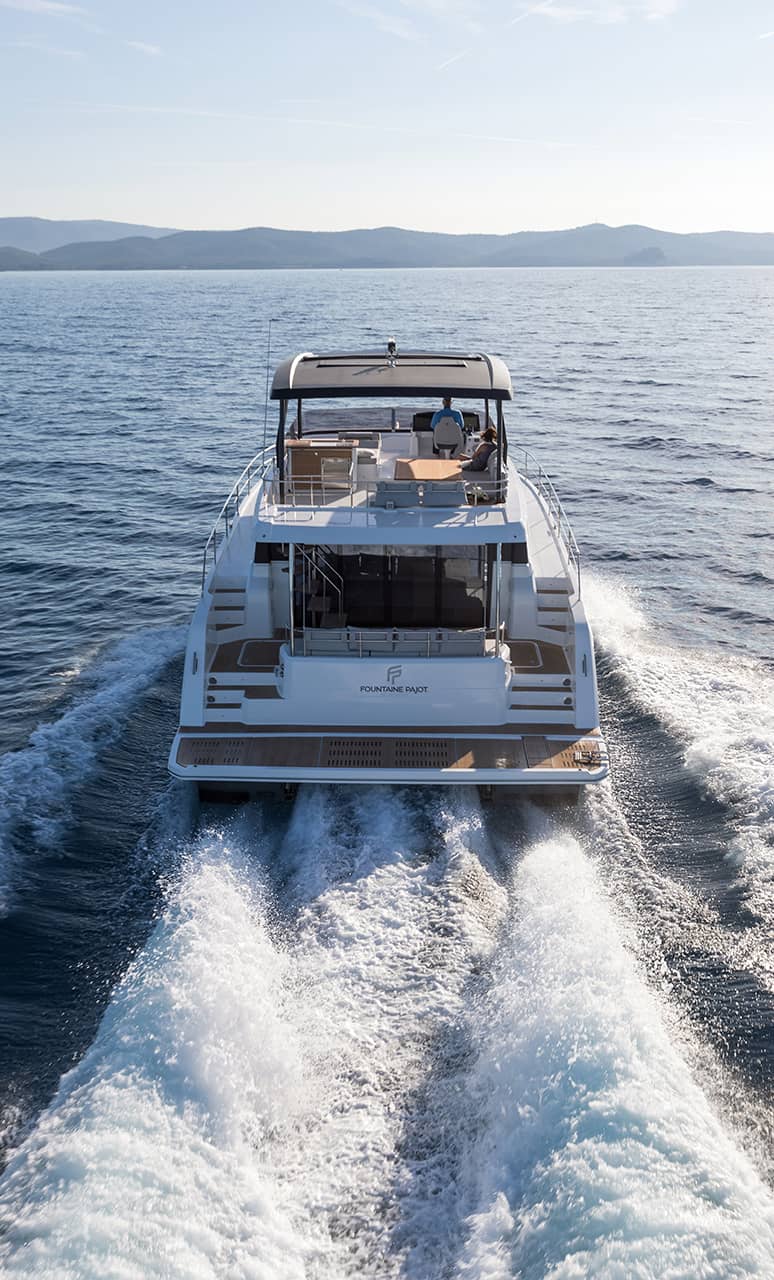
15 Jan 2024
Exclusive Events | Which Motor Yachts to visit in 2024 ?
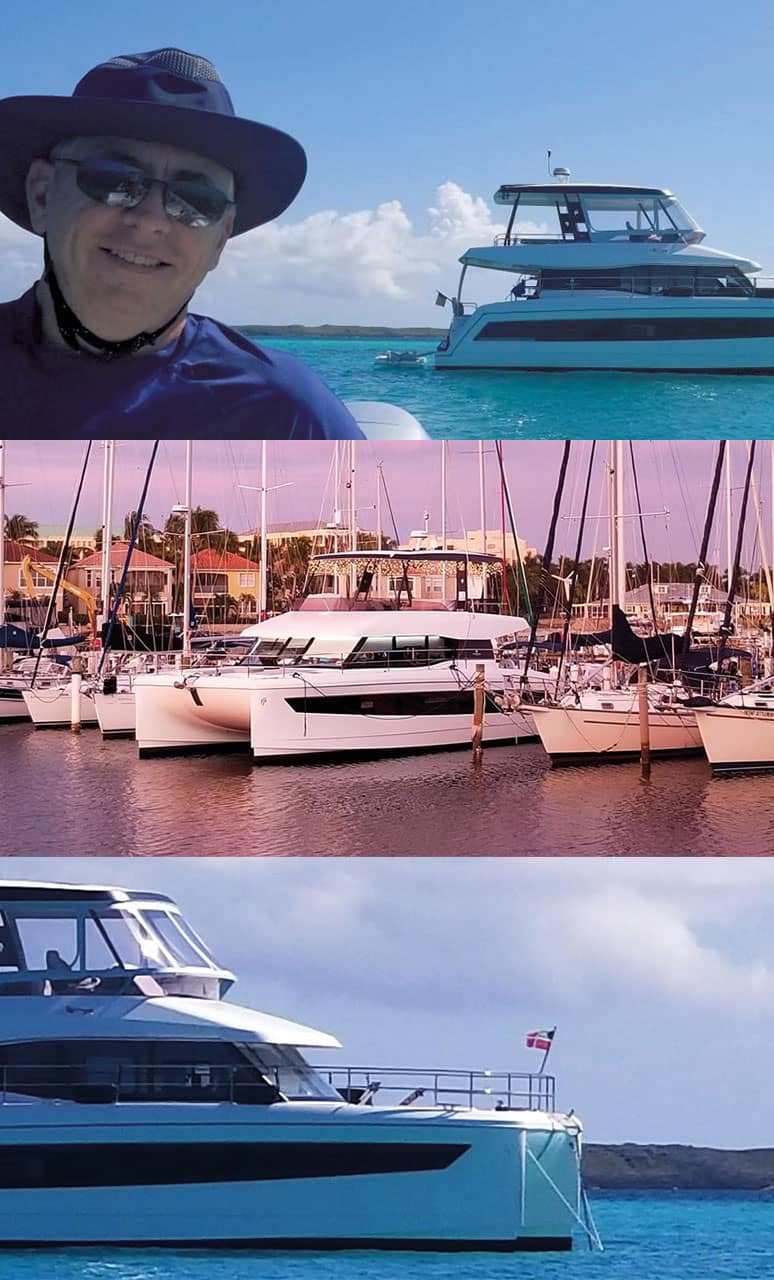
Long distance cruising aboard a catamaran motor yacht MY 44
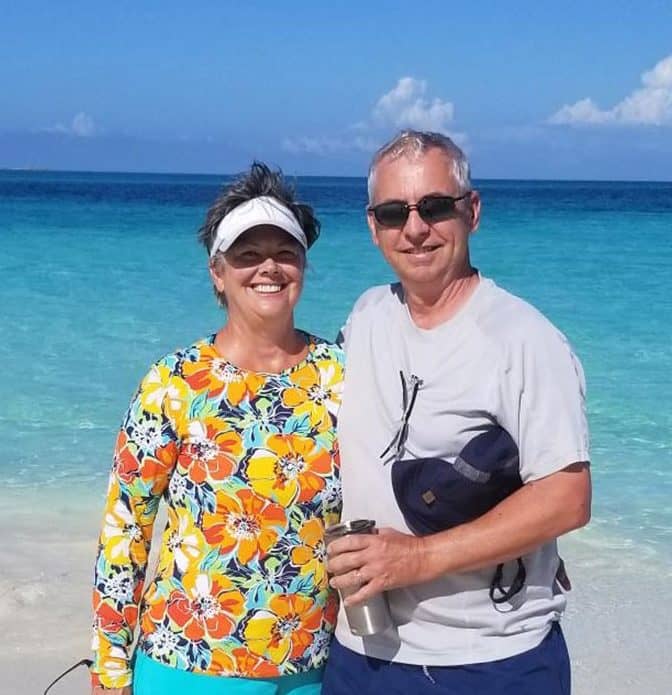
Patrick and Janet
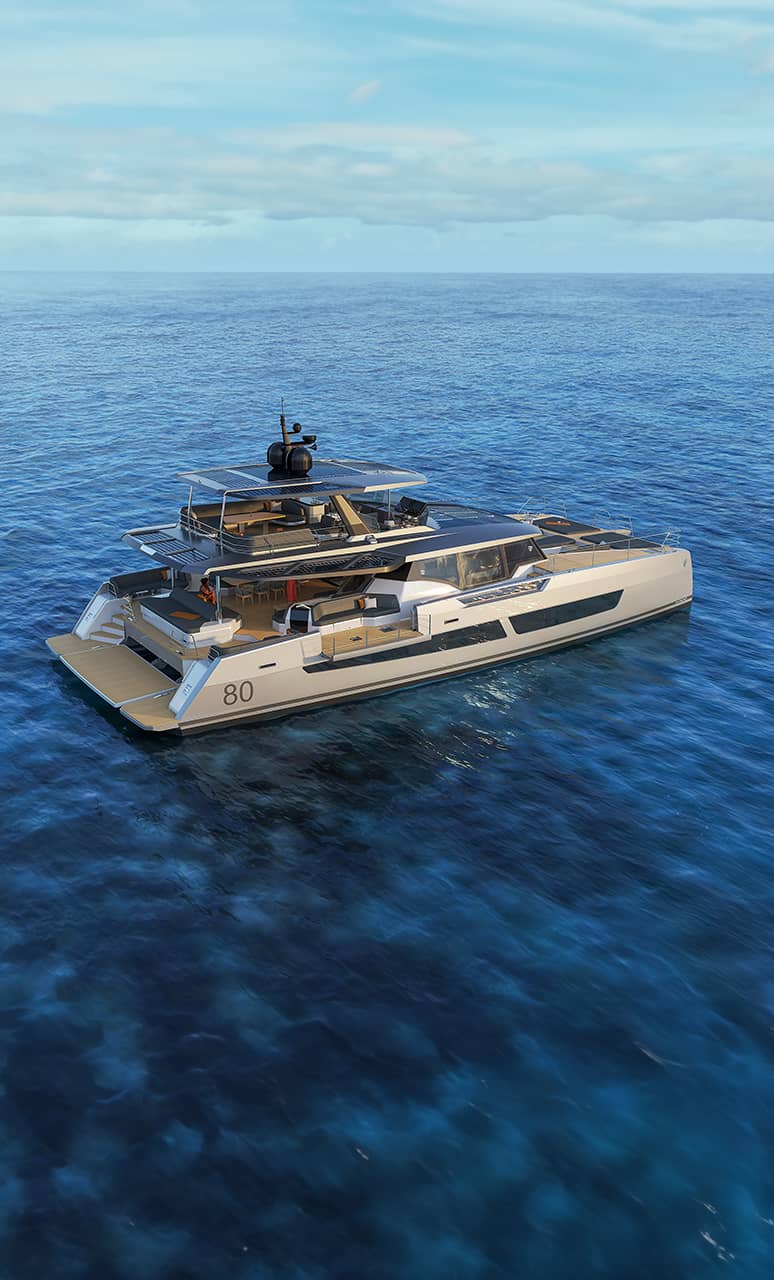
25 Sep 2023
Fountaine Pajot reveals a new 80-foot power catamaran yacht
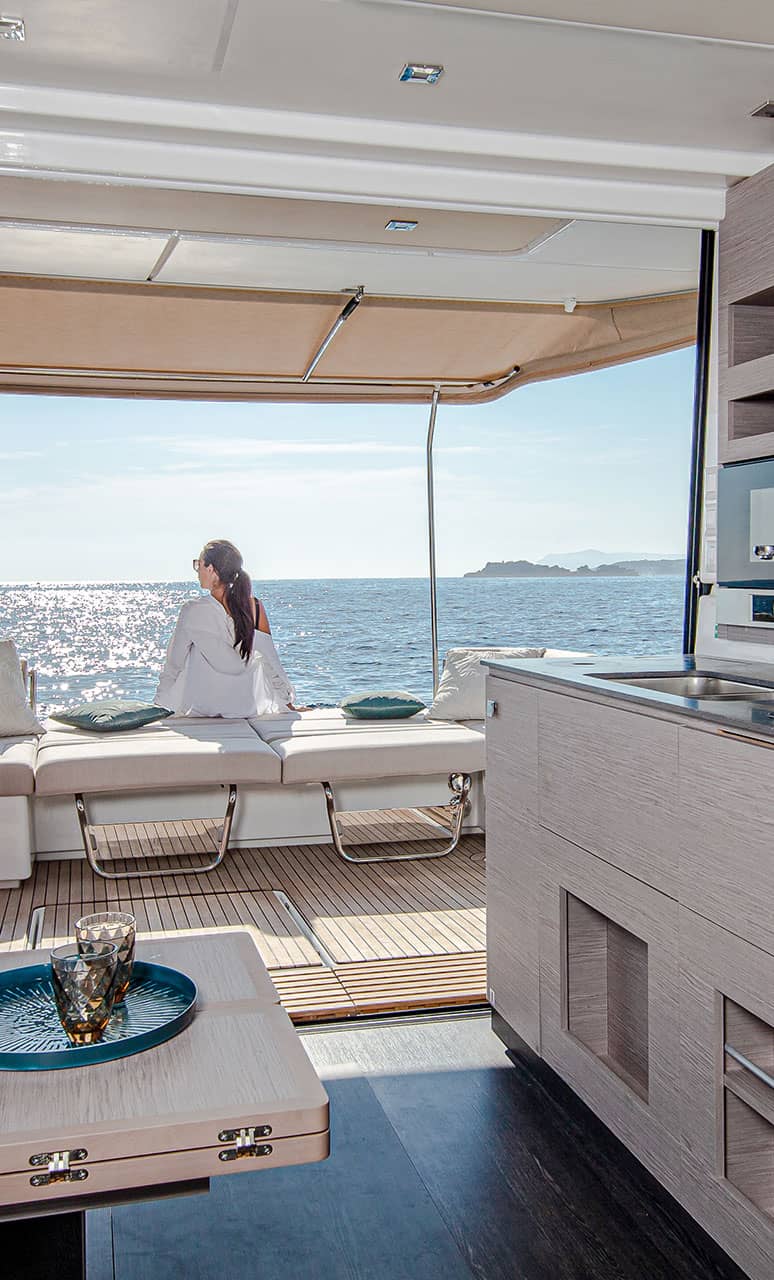
Discover the full test of the MY4.s by BoatTEST.com
Subscribe to the newsletter
Follow the adventures of Fountaine Pajot Owners, discover news and upcoming events, and take advantage of exclusive invitations to explore the Motor Yacht of your dreams.
Compare models
Motor Yacht MY4.S

Hosting capacity
Skipper cabin Non
Bunk beds Oui
Bunk beds Non
Motorisation
Cummins Non
Speed and autonomy
Technical information
User-friendly areas
Sunbathing Oui
Kitchen Oui
Sunbathing Non
Kitchen Non
Discover the prices
Double rooms
Your contact details
One last step before reaching the next page & discovering the prices proposed & main options for this version! You'll then be able, to schedule a live chat with your local dealer to discuss all the options and configurations available for this model!
Your home port
Any questions?
No pack information currently available online for this Flagship model. We will get back to you directly. Thank you
Would you like to configure this model’s options or set up another model?
Make an appointment with your nearest dealer and choose the boat of your dreams.
Please use a modern browser to view this website. Some elements might not work as expected when using Internet Explorer.
- Landing Page
- Luxury Yacht Vacation Types
- Corporate Yacht Charter
- Tailor Made Vacations
- Luxury Exploration Vacations
- View All 3676
- Motor Yachts
- Sailing Yachts
- Classic Yachts
- Catamaran Yachts
- Filter By Destination
- More Filters
- Latest Reviews
- Charter Special Offers
- Destination Guides
- Inspiration & Features
- Mediterranean Charter Yachts
- France Charter Yachts
- Italy Charter Yachts
- Croatia Charter Yachts
- Greece Charter Yachts
- Turkey Charter Yachts
- Bahamas Charter Yachts
- Caribbean Charter Yachts
- Australia Charter Yachts
- Thailand Charter Yachts
- Dubai Charter Yachts
- Destination News
- New To Fleet
- Charter Fleet Updates
- Special Offers
- Industry News
- Yacht Shows
- Corporate Charter
- Finding a Yacht Broker
- Charter Preferences
- Questions & Answers
- Add my yacht
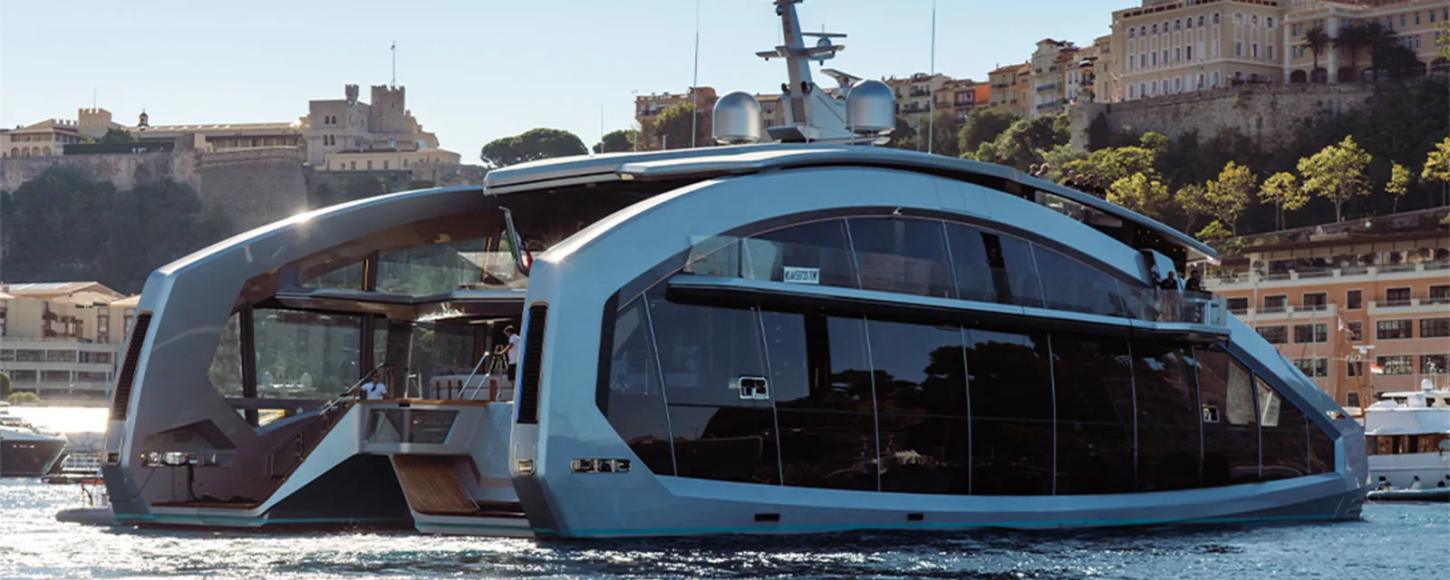
- Yacht Charter Fleet
Charter yacht THIS IS IT wins Best Catamaran at Robb Report Monaco Best of the Best 2024
- Share this on Facebook
- Share this on X
- Share via Email
By Anna Ingles 15 July 2024
Luxury charter yacht THIS IS IT has been honored with the Best Catamaran award at Robb Report Monaco's Best of the Best 2024. Hosted on July 10th at the Monaco Yacht Club, the anticipated annual event celebrates premier luxury products and experiences across diverse categories, including yachting, architecture, style, design, and technological innovation.
Paying meticulous attention to criteria such as innovation, attention to detail, and the relentless pursuit of excellence, the distinguished judging panel for the award ceremony consisted of editors and experts spanning 15 categories such as automotive, yachting, aviation, travel, style, watches, jewelry, food, wine, spirits, art, design, cigars, equipment, and residential building.

Giovanni Costantino, Founder & CEO of The Italian Sea Group, praised the team's commitment to the catamaran yacht charter , remarking, "The dedication, skill, and hard work of our team have been crucial in achieving this recognition. I extend my congratulations to our management and the professionals who worked together to create this remarkable catamaran, rich in detail, research, and technology."
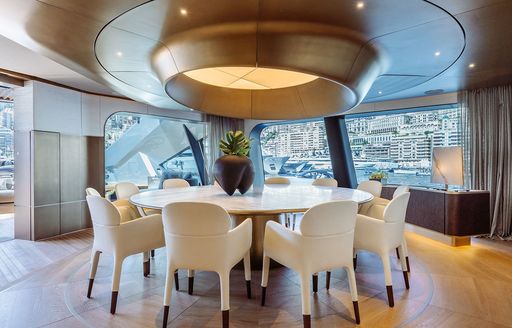
Tecnomar charter yacht THIS IS IT stands out in the luxury yacht rental market with its groundbreaking design and unconventional approach. The yacht fuses traditional and modern elements, showcasing a layout with striking asymmetries and over 600 square meters of glass surfaces. The design is inspired by technological and architectural advancements rather than conventional yachting aesthetics.
Lap up the natural splendor of your surroundings in the utmost comfort onboard catamaran yacht THIS IS IT
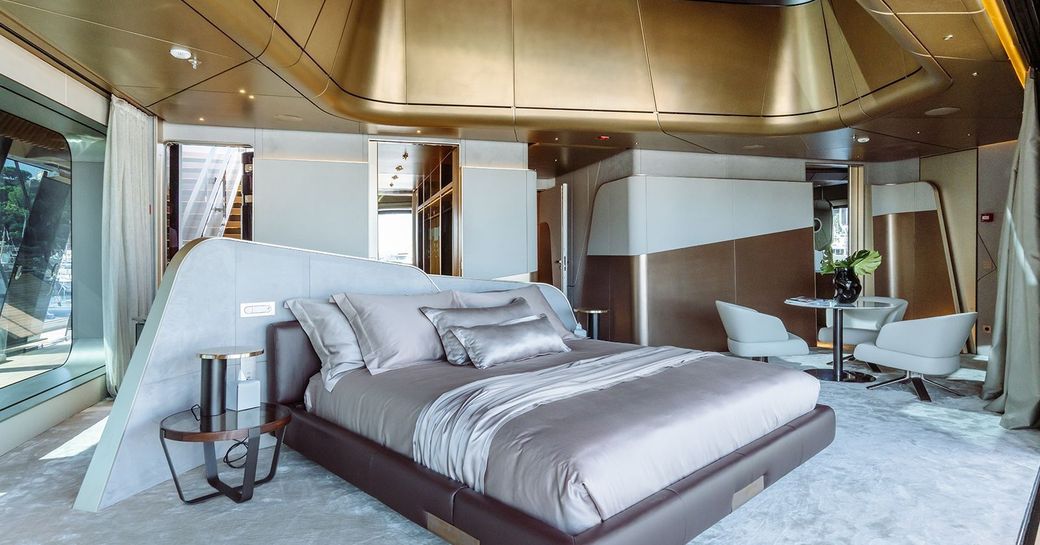
Notable features of THIS IS IT include its dynamic design, speed, and sporty aesthetics, which are integral to Tecnomar's brand identity. The engineering process meticulously focused on weight distribution, essential due to the extensive use of glass in the design.
The interior boasts refined details and high-quality materials such as leather, Alcantara, oak, and teak, complemented by gray marble accents. The design emphasizes dynamic, enveloping shapes with a sophisticated color palette of beige and platinum gray, enhanced by gold, bronze, and titanium accents.
Currently available for Mediterranean yacht charters throughout the summer season, find out more about chartering THIS IS IT by contacting your preferred yacht charter broker today for more details on availability and yacht rental costs .
Alternative catamaran yacht charters
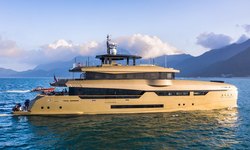
43m Heysea 2020
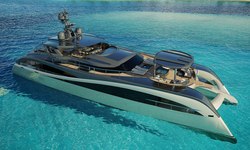
43m Rossinavi 2024
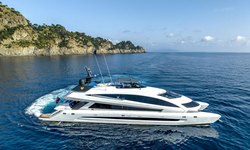
41m Kockums 2019
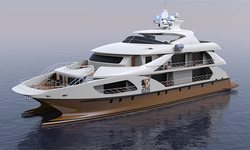
38m Custom 2019

36m SilverYachts 2022
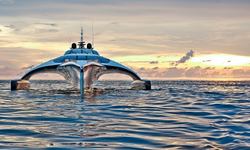
43m McConaghy Boats 2012
RELATED AREA GUIDES
View destinations guides, photo galleries & itineraries for areas related to this news article
- South of France
- Mediterranean
- West Mediterranean
- READ MORE ABOUT:
- Robb Report
- Best of the Best
RELATED STORIES
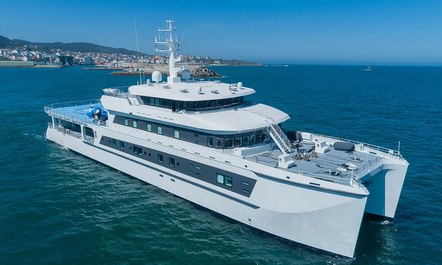
Previous Post
Embark on a last minute escape to Croatia with 40% off Benetti yacht charter ST DAVID
43M Overmarine superyacht SANCTUARY offers availability for Greece yacht charters
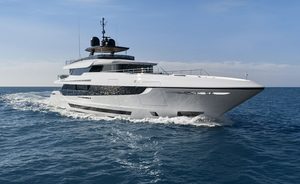
EDITOR'S PICK
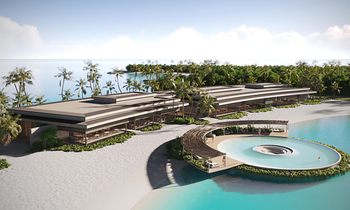
Latest News
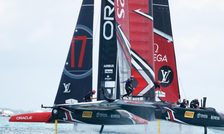
19 July 2024

18 July 2024

17 July 2024
- See All News
Yacht Reviews
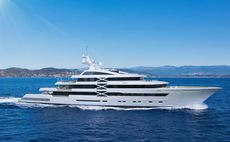
- See All Reviews
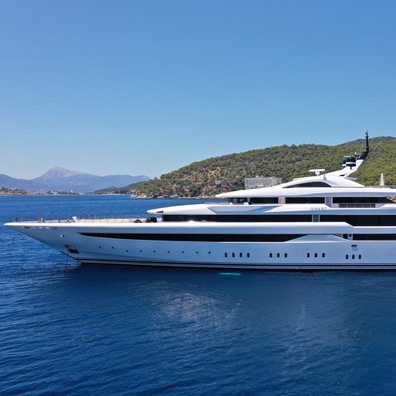
Charter Yacht of the week
Join our newsletter
Useful yacht charter news, latest yachts and expert advice, sent out every fortnight.
Please enter a valid e-mail
Thanks for subscribing
Featured Luxury Yachts for Charter
This is a small selection of the global luxury yacht charter fleet, with 3676 motor yachts, sail yachts, explorer yachts and catamarans to choose from including superyachts and megayachts, the world is your oyster. Why search for your ideal yacht charter vacation anywhere else?

136m | Lurssen
from $4,368,000 p/week ♦︎
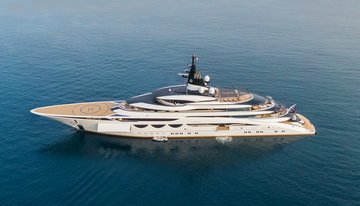
115m | Lurssen
from $2,831,000 p/week ♦︎
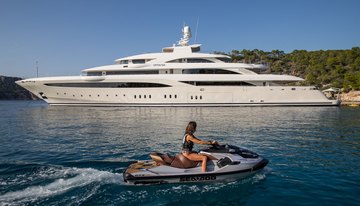
85m | Golden Yachts
from $980,000 p/week ♦︎
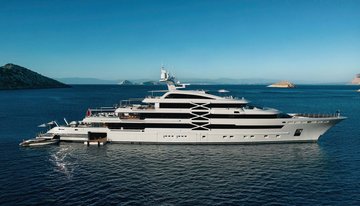
88m | Golden Yachts
from $1,179,000 p/week ♦︎
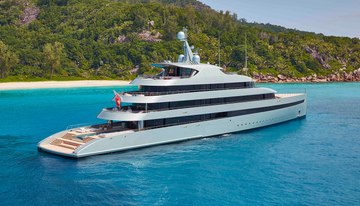
84m | Feadship
from $1,072,000 p/week ♦︎

93m | Feadship
from $1,501,000 p/week ♦︎
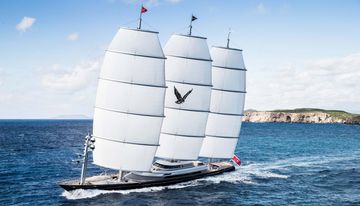
Maltese Falcon
88m | Perini Navi
from $490,000 p/week
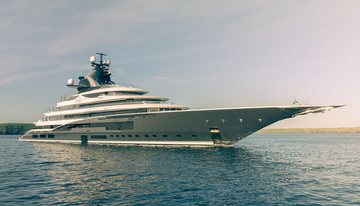
122m | Lurssen
from $3,000,000 p/week
As Featured In
The YachtCharterFleet Difference
YachtCharterFleet makes it easy to find the yacht charter vacation that is right for you. We combine thousands of yacht listings with local destination information, sample itineraries and experiences to deliver the world's most comprehensive yacht charter website.
San Francisco
- Like us on Facebook
- Follow us on Twitter
- Follow us on Instagram
- Find us on LinkedIn
- Add My Yacht
- Affiliates & Partners
Popular Destinations & Events
- St Tropez Yacht Charter
- Monaco Yacht Charter
- St Barts Yacht Charter
- Greece Yacht Charter
- Mykonos Yacht Charter
- Caribbean Yacht Charter
Featured Charter Yachts
- Maltese Falcon Yacht Charter
- Wheels Yacht Charter
- Victorious Yacht Charter
- Andrea Yacht Charter
- Titania Yacht Charter
- Ahpo Yacht Charter
Receive our latest offers, trends and stories direct to your inbox.
Please enter a valid e-mail.
Thanks for subscribing.
Search for Yachts, Destinations, Events, News... everything related to Luxury Yachts for Charter.
Yachts in your shortlist

The global authority in superyachting
- NEWSLETTERS
- Yachts Home
- The Superyacht Directory
- Yacht Reports
- Brokerage News
- The largest yachts in the world
- The Register
- Yacht Advice
- Yacht Design
- 12m to 24m yachts
- Monaco Yacht Show
- Builder Directory
- Designer Directory
- Interior Design Directory
- Naval Architect Directory
- Yachts for sale home
- Motor yachts
- Sailing yachts
- Explorer yachts
- Classic yachts
- Sale Broker Directory
- Charter Home
- Yachts for Charter
- Charter Destinations
- Charter Broker Directory
- Destinations Home
- Mediterranean
- South Pacific
- Rest of the World
- Boat Life Home
- Owners' Experiences
- Interiors Suppliers
- Owners' Club
- Captains' Club
- BOAT Showcase
- Boat Presents
- Events Home
- World Superyacht Awards
- Superyacht Design Festival
- Design and Innovation Awards
- Young Designer of the Year Award
- Artistry and Craft Awards
- Explorer Yachts Summit
- Ocean Talks
- The Ocean Awards
- BOAT Connect
- Between the bays
- Golf Invitational
- Boat Pro Home
- Superyacht Insight
- Global Order Book
- Premium Content
- Product Features
- Testimonials
- Pricing Plan
- Tenders & Equipment

Voodoo Yachts introduces high-speed and "exceptionally efficient" catamaran model
New Zealand-based Voodoo Yachts has announced a new, hydrofoil-assisted catamaran model known as the XF95.
The largest entry in the Xpedition Foiler range, the 28.5-metre model is based on the same proven, pioneering platform as the shipyard's previous models which have been "tested and battle-hardened in the South Pacific". The XF95 is characterised by a new exterior style, including forward raked windscreens, "exceptional efficiency" and an impressive top speed of 40 knots.
"This speed is unique in the adventure superyacht market, and a combination which grants the owners much more freedom. To our knowledge, this will be the largest high-speed hydrofoiling luxury motor yacht in the world," said Voodoo Yachts co-founder and director Mitch Pachoud. "[And] with the foil she will ride unlike anything else of this size, sitting high and smooth in the water."
Key numbers include a volume of 245GT, a 9.5-metre beam and 500 square metres of on board space, comparable to builds in the 36 to 38-metre sector. The model is highly customisable, from the exterior – which can feature an enclosed or open bridge – to the layout, which offers several configurations.
For instance, the main saloon can be arranged with or without a formal dining and lounge space, while the upper deck has an optional configuration that includes a cocktail bar. Accommodation is also customisable, with one particular configuration featuring an owner's cabin adjacent to a sauna and a gym. There is also the option to include a home theatre or increase the owner's suite to fit the yacht's full beam.
Other model highlights include the main deck aft, which features a dip pool, lounge area and a swim platform with sunloungers. The garage can store a Williams Dieseljet 625 plus two full-sized Jet Skis.
"We have focused on designing a boat that will easily adapt to a wide range of climates and cruising locations, including the Med, the Caribbean, the Middle East, New Zealand and Australia," added Pachoud. "This will be a sensationally special yacht, and completely unique. There is nothing else out there that's like the XF95 at this size."
The XF95 model will also offer "environmentally friendly" options, including a large solar power array.
Sign up to BOAT Briefing email
Latest news, brokerage headlines and yacht exclusives, every weekday
By signing up for BOAT newsletters, you agree to our Terms of Use and our Privacy Policy .
More stories
Most popular, from our partners, sponsored listings.
- Share full article
Advertisement
How to Charter a Boat
If you want to sail off into the sunset, at least temporarily, you need to understand how to get aboard first.

By Lauren Sloss
This time of year, it’s an inevitable thought: Life would be that much better out on the water. Specifically, on a boat.
Even if you have neither a boat nor boating experience, it’s never been easier to make your nautical dreams come true — whether you want a day trip on your local lake or a fully staffed multiday voyage in a far-flung locale. Here are the initial questions that will help you plan an adventure on the water.
Whom are you traveling with?
Thinking about the size and dynamic of your group is an important first step, even if you are simply going on a day trip. Will children be on board? How old? What about elderly parents?
Dan Lockyer, the chief commercial officer of Dream Yacht Worldwide , strongly encourages travelers to determine group size — and, ideally, get people committed — before booking.
“The location that you want to go to, the time of year that you want to go, the type of boat that you want will entirely depend on the makeup of the group that you’re sailing with,” Mr. Lockyer said.
Do you want to captain, or do you want a captain?
Different charter companies specialize in certain locations, types of boats, itineraries and services. Some companies offer the opportunity for a “bareboat” charter, in which you rent the boat and take on the navigation and provisioning yourself, while others exclusively offer fully staffed options, including a captain and a cook.
If you want to captain the boat yourself, almost all outfits require some kind of proof of sailing or boating experience, often in line with local regulations.
Edward King, 45, an executive at a streaming company based in San Francisco, is experienced in sailing the city’s waterways. But on vacation, he said he would prefer to let a captain and crew take the lead.
Mr. King said he appreciates a captain who is familiar with both the local waters — “they’ll know how to avoid sailing into a certain sandbar,” he said, — as well as the local attractions.
In contrast, Matt Blake, 38, a software engineer based in Oakland, Calif., was eager to grow his sailing experience during a recent trip to La Paz, Mexico, with his fiancée. He hired a captain but made clear that the captain was there to help and teach.
Where do you want to go?
“Do you want something that’s more culturally oriented? Nature oriented? An adventure trip?” asked Mary Curry, the voyage product director of Adventure Life , which offers small group tours and private trips on land and on water around the world.
That answer can determine your destination. Popular cruising grounds include the Caribbean, Croatia, Alaska and French Polynesia, but the sky — or the sea — is really the limit. For help narrowing your focus, travel advisers often have relationships with charter companies or outfits around the world, and sailing publications offer recommendations.
Kyla Malkani, who has had experience with charters working as a destination wedding planner, recommends consulting the concierge of waterfront hotels, particularly for short-term or day rentals.
“A lot of times they will have either their own fleet or they will have some sort of connection at a dock,” said Ms. Malkani, 37, who is based in Washington, D.C., and is currently working as a content creator and freelance event planner.
What kind of boat?
Where you want to travel and for how long will likely determine the kinds of boats that are available to you. Crucial at this point, too, is an understanding of the boat’s layout and amenities.
“You definitely want to choose the right kind of boat,” said Ms. Malkani. “If you want more adventure, a sailboat is nice. If you’re looking for a luxury party environment, a yacht is best. And if you’re looking for something smooth, for older people or with kids, a catamaran is great.”
David Barclay is a luxury travel adviser who has also chartered boats for his own vacations.
“You want to match what the travelers want to what the boat offers,” he said.
Perhaps a group of friends might not mind a catamaran with functional but not luxurious marine bathrooms, but a multigenerational group might prefer more high-touch amenities.
When should I book?
Often, charter trips are once-in-a-lifetime experiences that require a great deal of advanced planning.
“You may have a specific place you want to go, or a specific time of year you want to travel,” said Mr. Barclay. “And some places just aren’t good at certain times of year.”
Naturally, you don’t want to be at sea in the Caribbean during hurricane season, or in the Mediterranean during winter storms. But you also might want to avoid peak cruising seasons, too.
The first three weeks of August are quite popular, said Mr. Lockyer. “If you have some flexibility and can travel in early July, you’ll get the same sort of great weather, a greater selection of boats and the anchorages won’t be as crowded.”
How much does it cost?
Charter costs are incredibly variable, dependent on all of the factors coming into play: your boat type and size, your destination, your group size, the amount of crew you’d like and the amenities on board. That said, costs could range anywhere from $2,000 for a day on a sailboat to hundreds of thousands of dollars for a multiday mega-yacht charter. Have a budget in mind when beginning your research process.
What if I didn’t plan far in advance?
While advanced planning is encouraged, and often necessary for bigger boat trips, it’s possible to book a boat last-minute.
Boatsetter , an Airbnb-like platform for boats, is a good resource for last-minute bookings, especially for day trips, and even has an Instant Book option for down-to-the-wire bookings.
“If it’s for a special event, or around major holidays, you may want to book a month or two in advance. But for general bookings, you can find options within a week or two,” said Kim Koditek, Boatsetter’s head of brand strategy and communications, of the company’s overnight offerings, which appear on their platform under the luxury yacht charters category .
Ms. Malkani has used Boatsetter for some of her charters, most of which have been booked with a specific goal in mind.
“I’m a sunset chaser,” she said. “My husband and I just really love being on the water, and we always try to squeeze in some sort of boat day activity when we’re traveling.”
For more travel advice, visit our collection of Travel 101 tips and hacks.
Come Sail Away
Love them or hate them, cruises can provide a unique perspective on travel..
Cruise Ship Surprises: Here are five unexpected features on ships , some of which you hopefully won’t discover on your own.
Icon of the Seas: Our reporter joined thousands of passengers on the inaugural sailing of Royal Caribbean’s Icon of the Seas . The most surprising thing she found? Some actual peace and quiet .
Th ree-Year Cruise, Unraveled: The Life at Sea cruise was supposed to be the ultimate bucket-list experience : 382 port calls over 1,095 days. Here’s why those who signed up are seeking fraud charges instead.
TikTok’s Favorite New ‘Reality Show’: People on social media have turned the unwitting passengers of a nine-month world cruise into “cast members” overnight.
Dipping Their Toes: Younger generations of travelers are venturing onto ships for the first time . Many are saving money.
Cult Cruisers: These devoted cruise fanatics, most of them retirees, have one main goal: to almost never touch dry land .

IMAGES
VIDEO
COMMENTS
The Catamaran Vs. motor yacht, a comparison that has lasted for ages, is one we will finally put to rest in this article. We promise to make spotting their differences easy. Differences Distinguishing the Catamaran Vs. Motor Yacht At the end of this section, everything that distinguishes these two sailing boats from each other will […]
Maneuverability - Yachts take more skill to maneuver tight spaces, while catamarans can turn 360 degrees within their own length.; Windward Performance - Yachts point higher into the wind and sail more efficiently upwind.Catamarans excel on reaches and downwind sailing. So for performance-oriented sailing, monohull yachts have some advantages.
Catamaran vs Sailing Yacht. While both catamarans and sailing yachts offer exhilarating experiences on the water, they differ in design and capabilities. Catamarans provide enhanced stability and a shallow draft, allowing for smooth sailing in various conditions. Sailing yachts, on the other hand, feature a single hull and mainly rely on wind ...
Catamarans are also more fuel efficient than yachts. They don't have to deal with the drag like a yacht. Since yachts contain powerful motors, they can cruise around quicker than catamarans. There is a range of sizes available in the yacht industry. You'll never find a catamaran that can compete with the size of a huge luxury yacht.
Attach one line to each of the forward cleats and bring the loose ends to the center. Pick up the mooring with a boathook. String one line through the eye and bring it back to the same cleat. Repeat on the other side, keeping the lines the same length so the cat is centered.
Shop for new or used sportsfish yachts on YachtWorld. Catamaran Motor Yachts 40 feet + Big catamaran yacht design has undergone significant development over the past decade thanks to the ever-growing popularity of luxury powerboat catamarans. Firstly, the two-hull structure doubles the recreational space compared with a monohull of a similar size.
The most compelling argument of all must be this: seasoned monohull boaters are converting to catamarans by the truckload. Many converted former motor yacht owners are now passionate advocates of power catamarans. For experienced yachties demanding performance, the advantages are simply too great to ignore. It is rare to hear of any catamaran ...
What Is Better to Charter a Catamaran vs Yacht? Those new to yacht charter and catamaran charter will often ask, what is Better to charter - a Catamaran or Yacht?To assess the catamaran vs yacht question, we need to understand the main differences. A catamaran is, strictly speaking, a yacht with two hulls and a yacht in this context and a sailing vessel with one hull, otherwise known as a ...
Unlike yachts, catamarans generally have a minimum of two engines. These motors enhance the level of maneuverability of the vessel. In other words, catamarans are easier to pilot or maneuver than yachts of the same length. Furthermore, the presence of a second engine on a catamaran makes it noticeably more potent than a yacht.
Aquila power catamarans are well known for cruising comfort. Photo via Aquila. Aquila has one of the largest and most diverse power catamaran lineups around, with nine models ranging from 28' all the way to 70'. These are very different boats, too, including center consoles, dual consoles, a cuddy cabin, and flybridge yachts.
A motorboat (or speed boat) is a fast boat that mostly serves to move from a motor yacht, sailboat or catamaran to the shore. It has no cabin to stay overnight or any toilet space (in most cases). The size of the recreational motorboat ranges from 3 to 8 meters and has one or two fast motors from 50hp to 500hp.
Motor Yacht or Power Catamaran? Which is better? With a Motor Yacht's power, sophistication, and space, you can explore an ocean of possibilities. Our range provides exceptional performance at sea, with magnificent panoramic views from their luminous interiors, impressive power, excellent fuel efficiency, and world-class safety. ...
Most yachts, if large enough to accommodate, have a main salon and a forward stateroom in terms of cabins. The larger the yacht, the more rooms it may have. Catamaran vs. Yacht: Structural Differences. If you are looking for a cruising catamaran, you will need a larger boat than the monohull counterparts.
These cruise-centric yachts offer homelike livability for avid travelers, are fuel efficient and are fairly intuitive to run. Power cats are popular in the bareboat charter market too, for these very reasons. Here, we take a look at 12 catamarans ranging from a cruising-couple-size 36-footer to a 78-footer for friends, family and some more ...
The highly capable motor yacht can take you on Arctic expeditions, luxurious trips along the Italian Riviera, or snorkeling in the Bahamas. No matter the conditions outside, motor yachts deliver comfort, style, and plenty of room to unwind. ... Like the aforementioned power catamarans, the sailing catamaran yachts offer a very comfortable ...
7. Shallow Draft Equals Better Anchorages. Catamarans have significantly shallower drafts than monohulls, allowing for safer anchorages closer to shore. Most catamarans in the 40-ft to 50-ft range draw between 3-ft to 4.5-ft, so they can anchor in places that a monohulls can not even consider.
Power Catamaran boats pricing. Power Catamaran boats listed for sale on YachtWorld offers a diverse price range, from $43,874 on the relatively lower-priced, classic models to an astonishing $9,095,936 for the more sophisticated yachts available. When evaluating your budget and the listed price of a yacht for sale, it is crucial to factor in ...
We can also see that the cat consistently decelerated slower when it hit the wave than the V-hull did. It had an average deceleration of 0.287 seconds, compared to the V-hull's 0.081 seconds-which is 3.5 times faster. The cat not only landed with less force, it decelerated slower as well.
Catamaran. A catamaran is a multihull vessel with two or twin hulls that are parallel to each other and fixed to a wide beam. This design offers stability and speed, making it a popular choice for cruising long distances comfortably and even racing. They also provide more interior space than trimarans, allowing for larger cabins and more storage.
Jul 30, 2018. Original: Aug 17, 2015. Two sailboat experts argue monohull vs. catamaran. Contributed by Denison Yacht Sales. The great debate over which is better—one or two hulls—boils down to several factors, each with distinct advantages and disadvantages. The verdict usually defaults to personal preference and intended use of the vessel ...
Stay connected for the latest Fountaine Pajot news. Follow the adventures of Fountaine Pajot Owners, discover news and upcoming events, and take advantage of exclusive invitations to explore the Motor Yacht of your dreams. Discover the exceptional range of motor catamarans & motor yachts: MY4.S, MY5, MY6, Power 67 & Power 80 - Fountaine Pajot ...
Power catamarans are naturally more efficient than monohull power boats.Depending on the model and the engine installed on board, at a high cruising speed, i.e. around 18 knots, motor yachts in the Fountaine Pajot range can reach between 260 and 425 nautical miles.
Luxury charter yacht THIS IS IT has been honored with the Best Catamaran award at Robb Report Monaco's Best of the Best 2024. Hosted on July 10th at the Monaco Yacht Club, the anticipated annual event celebrates premier luxury products and experiences across diverse categories, including yachting, architecture, style, design, and technological innovation.
Some of the most popular Catamaran models presently listed include: Diamond Yachts P55 Power Catamaran, 270, Catathai 50, Custom Song Saigon and DAY CHARTER MODEL T. Various Catamaran models are currently offered for sale by specialized yacht brokers, dealers and brokerages on YachtWorld, with listings ranging from 1986 year models up to 2025. ...
New Zealand-based Voodoo Yachts has announced a new, hydrofoil-assisted catamaran model known as the XF95. The largest entry in the Xpedition Foiler range, the 28.5-metre model is based on the same proven, pioneering platform as the shipyard's previous models which have been "tested and battle-hardened in the South Pacific".
This time of year, it's an inevitable thought: Life would be that much better out on the water. Specifically, on a boat. Even if you have neither a boat nor boating experience, it's never been ...